Quick filters:
Space probes Stock Photos and Images
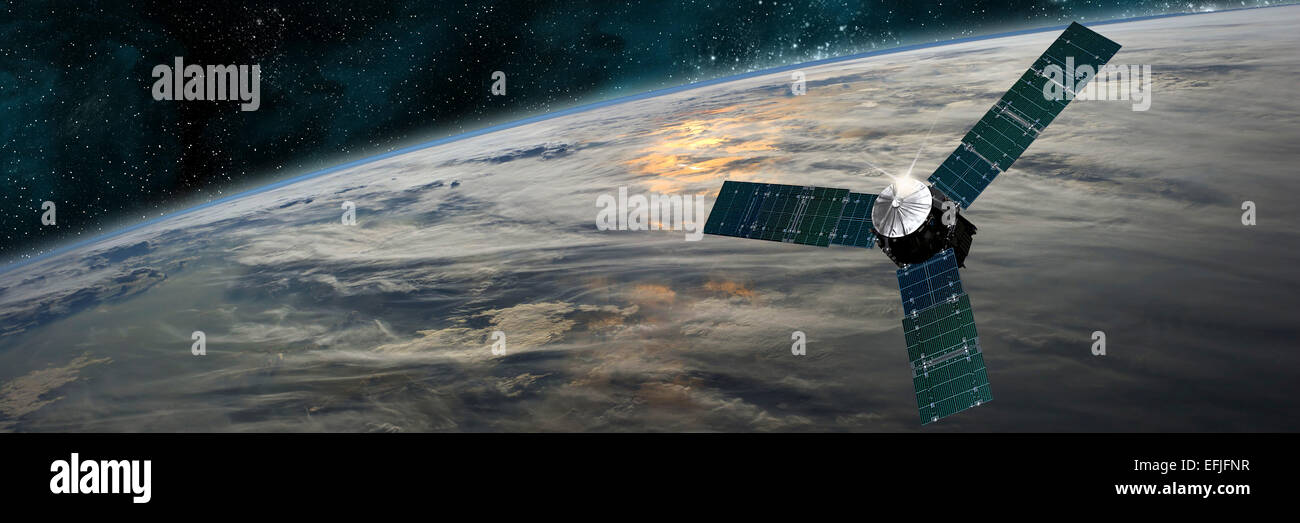 A space probe investigates a beautiful cloud covered planet in outer space. Clouds swirl over the planet's surface and through i Stock Photohttps://www.alamy.com/image-license-details/?v=1https://www.alamy.com/stock-photo-a-space-probe-investigates-a-beautiful-cloud-covered-planet-in-outer-78468819.html
A space probe investigates a beautiful cloud covered planet in outer space. Clouds swirl over the planet's surface and through i Stock Photohttps://www.alamy.com/image-license-details/?v=1https://www.alamy.com/stock-photo-a-space-probe-investigates-a-beautiful-cloud-covered-planet-in-outer-78468819.htmlRFEFJFNR–A space probe investigates a beautiful cloud covered planet in outer space. Clouds swirl over the planet's surface and through i
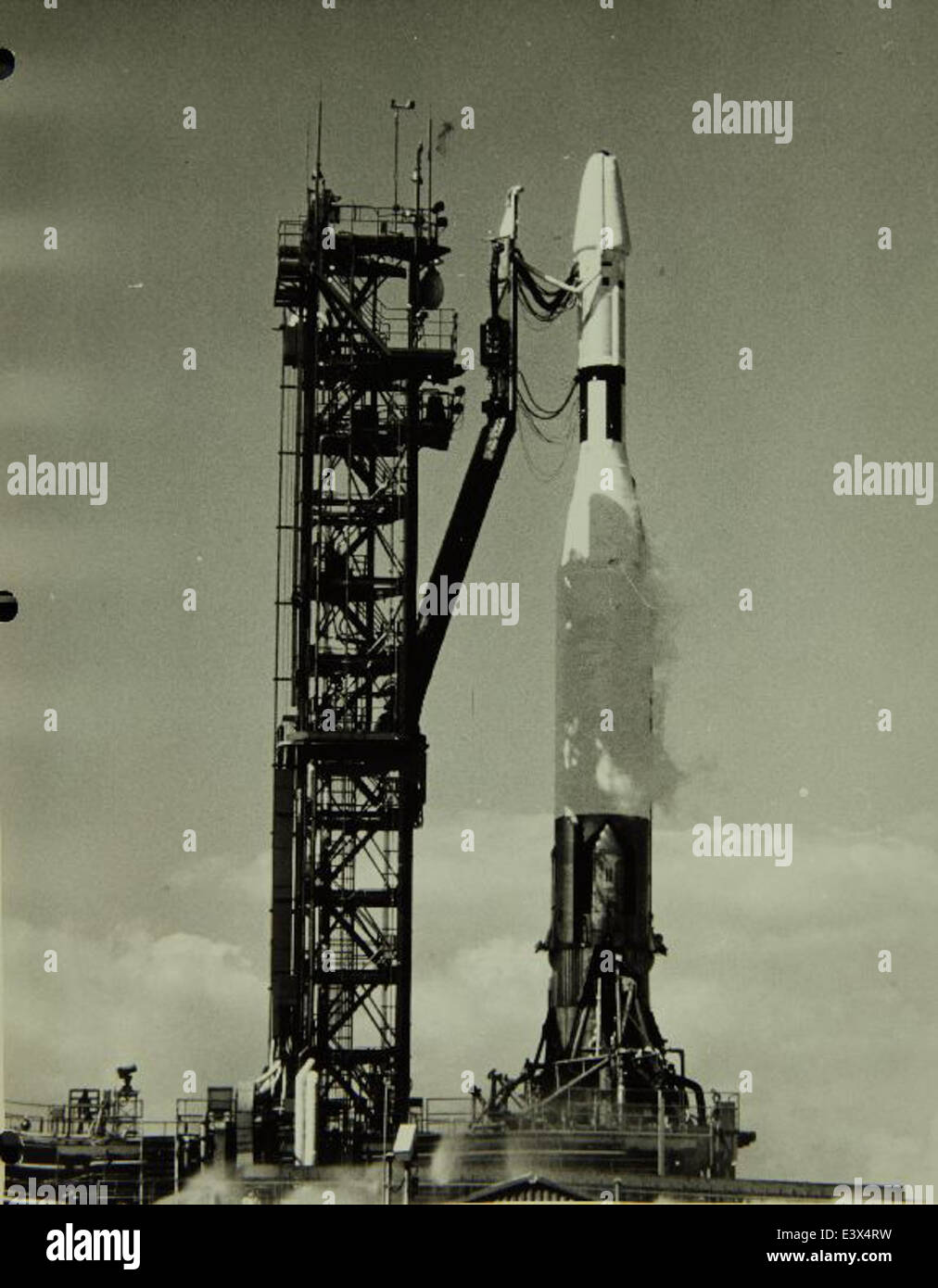 The Convair/General Dynamics Atlas rocket was a key player in early space exploration. It was used as a launch vehicle for the Ranger space probes, designed to gather data about the Moon. Stock Photohttps://www.alamy.com/image-license-details/?v=1https://www.alamy.com/stock-photo-the-convairgeneral-dynamics-atlas-rocket-was-a-key-player-in-early-71259997.html
The Convair/General Dynamics Atlas rocket was a key player in early space exploration. It was used as a launch vehicle for the Ranger space probes, designed to gather data about the Moon. Stock Photohttps://www.alamy.com/image-license-details/?v=1https://www.alamy.com/stock-photo-the-convairgeneral-dynamics-atlas-rocket-was-a-key-player-in-early-71259997.htmlRME3X4RW–The Convair/General Dynamics Atlas rocket was a key player in early space exploration. It was used as a launch vehicle for the Ranger space probes, designed to gather data about the Moon.
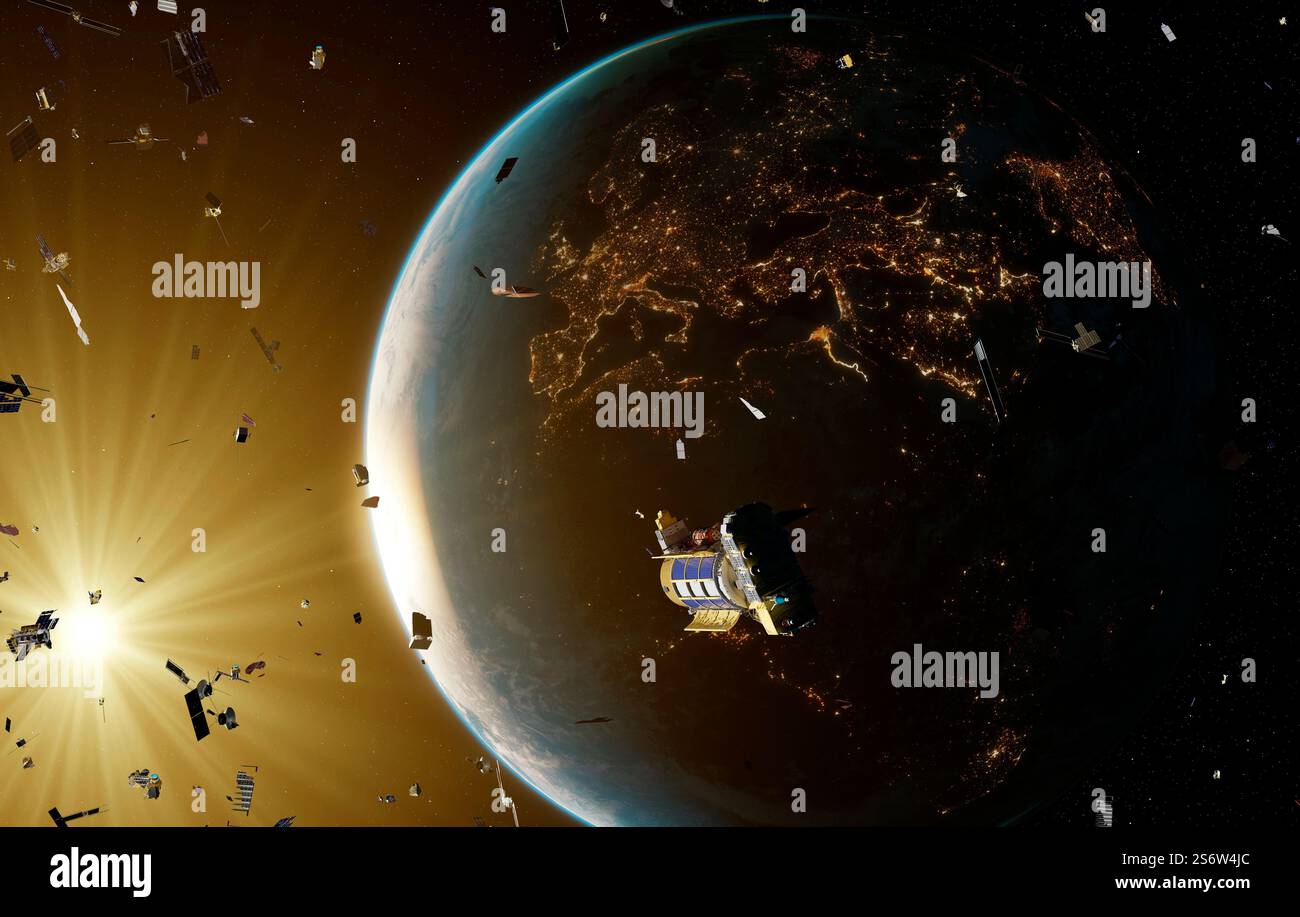 Humans have been sending space probes, satellites and general miscellaneous materials into orbit around our planet since the late 1950s. Most of these remain in orbit even now, having long served their purpose and been deactivated or else damaged beyond repair. As a result the space around the planet - the Low Earth Orbit zone in particular - is extremely crowded and reaching saturation. Each payload we launch increases the likelihood of a collision - and potential disaster. Stock Photohttps://www.alamy.com/image-license-details/?v=1https://www.alamy.com/humans-have-been-sending-space-probes-satellites-and-general-miscellaneous-materials-into-orbit-around-our-planet-since-the-late-1950s-most-of-these-remain-in-orbit-even-now-having-long-served-their-purpose-and-been-deactivated-or-else-damaged-beyond-repair-as-a-result-the-space-around-the-planet-the-low-earth-orbit-zone-in-particular-is-extremely-crowded-and-reaching-saturation-each-payload-we-launch-increases-the-likelihood-of-a-collision-and-potential-disaster-image641024004.html
Humans have been sending space probes, satellites and general miscellaneous materials into orbit around our planet since the late 1950s. Most of these remain in orbit even now, having long served their purpose and been deactivated or else damaged beyond repair. As a result the space around the planet - the Low Earth Orbit zone in particular - is extremely crowded and reaching saturation. Each payload we launch increases the likelihood of a collision - and potential disaster. Stock Photohttps://www.alamy.com/image-license-details/?v=1https://www.alamy.com/humans-have-been-sending-space-probes-satellites-and-general-miscellaneous-materials-into-orbit-around-our-planet-since-the-late-1950s-most-of-these-remain-in-orbit-even-now-having-long-served-their-purpose-and-been-deactivated-or-else-damaged-beyond-repair-as-a-result-the-space-around-the-planet-the-low-earth-orbit-zone-in-particular-is-extremely-crowded-and-reaching-saturation-each-payload-we-launch-increases-the-likelihood-of-a-collision-and-potential-disaster-image641024004.htmlRF2S6W4JC–Humans have been sending space probes, satellites and general miscellaneous materials into orbit around our planet since the late 1950s. Most of these remain in orbit even now, having long served their purpose and been deactivated or else damaged beyond repair. As a result the space around the planet - the Low Earth Orbit zone in particular - is extremely crowded and reaching saturation. Each payload we launch increases the likelihood of a collision - and potential disaster.
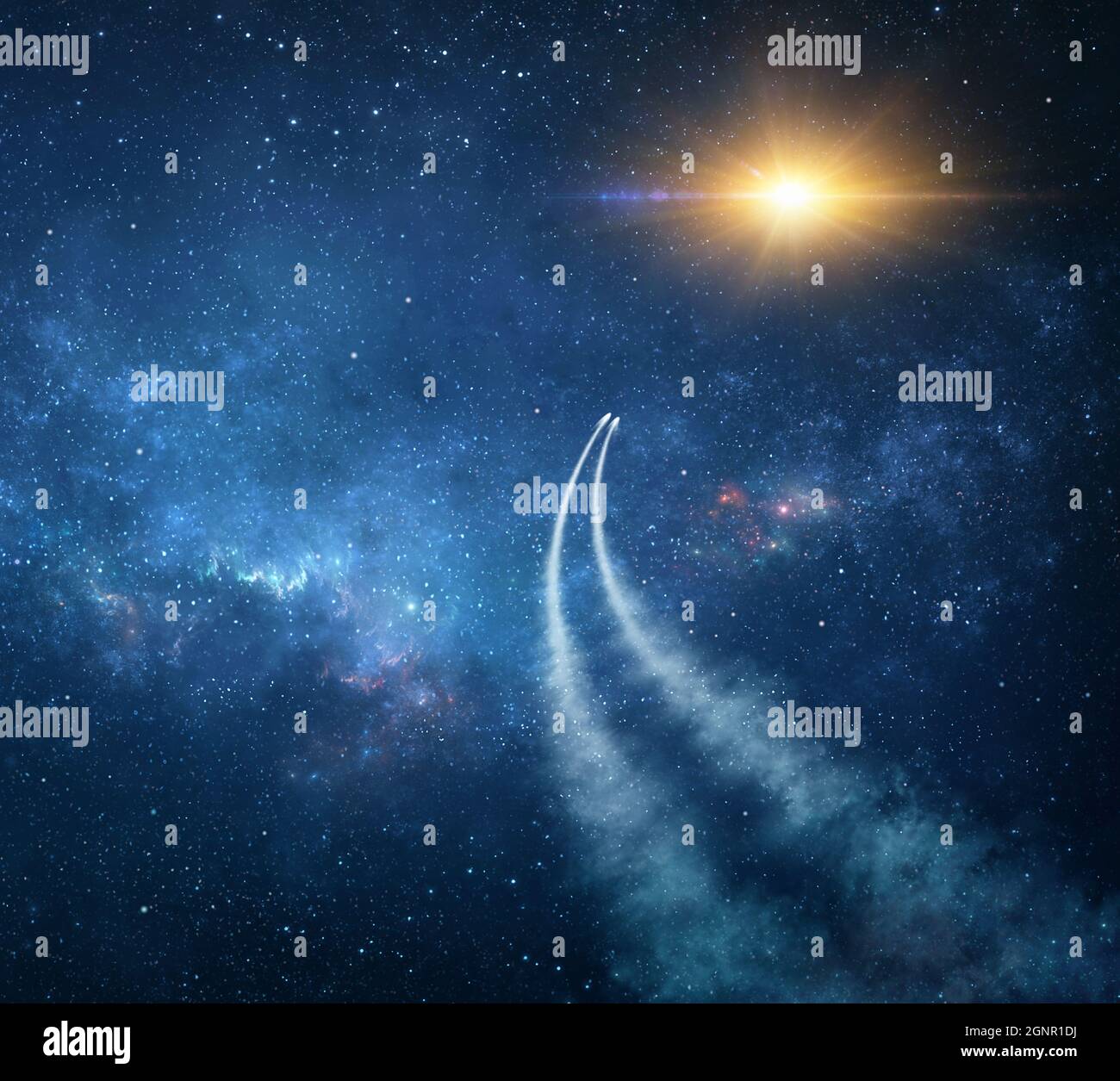 Spaceships traveling into deep space, exploring galaxies and Universe. Space probes passing through stars and nebulae towards the Sun. Stock Photohttps://www.alamy.com/image-license-details/?v=1https://www.alamy.com/spaceships-traveling-into-deep-space-exploring-galaxies-and-universe-space-probes-passing-through-stars-and-nebulae-towards-the-sun-image443673038.html
Spaceships traveling into deep space, exploring galaxies and Universe. Space probes passing through stars and nebulae towards the Sun. Stock Photohttps://www.alamy.com/image-license-details/?v=1https://www.alamy.com/spaceships-traveling-into-deep-space-exploring-galaxies-and-universe-space-probes-passing-through-stars-and-nebulae-towards-the-sun-image443673038.htmlRF2GNR1DJ–Spaceships traveling into deep space, exploring galaxies and Universe. Space probes passing through stars and nebulae towards the Sun.
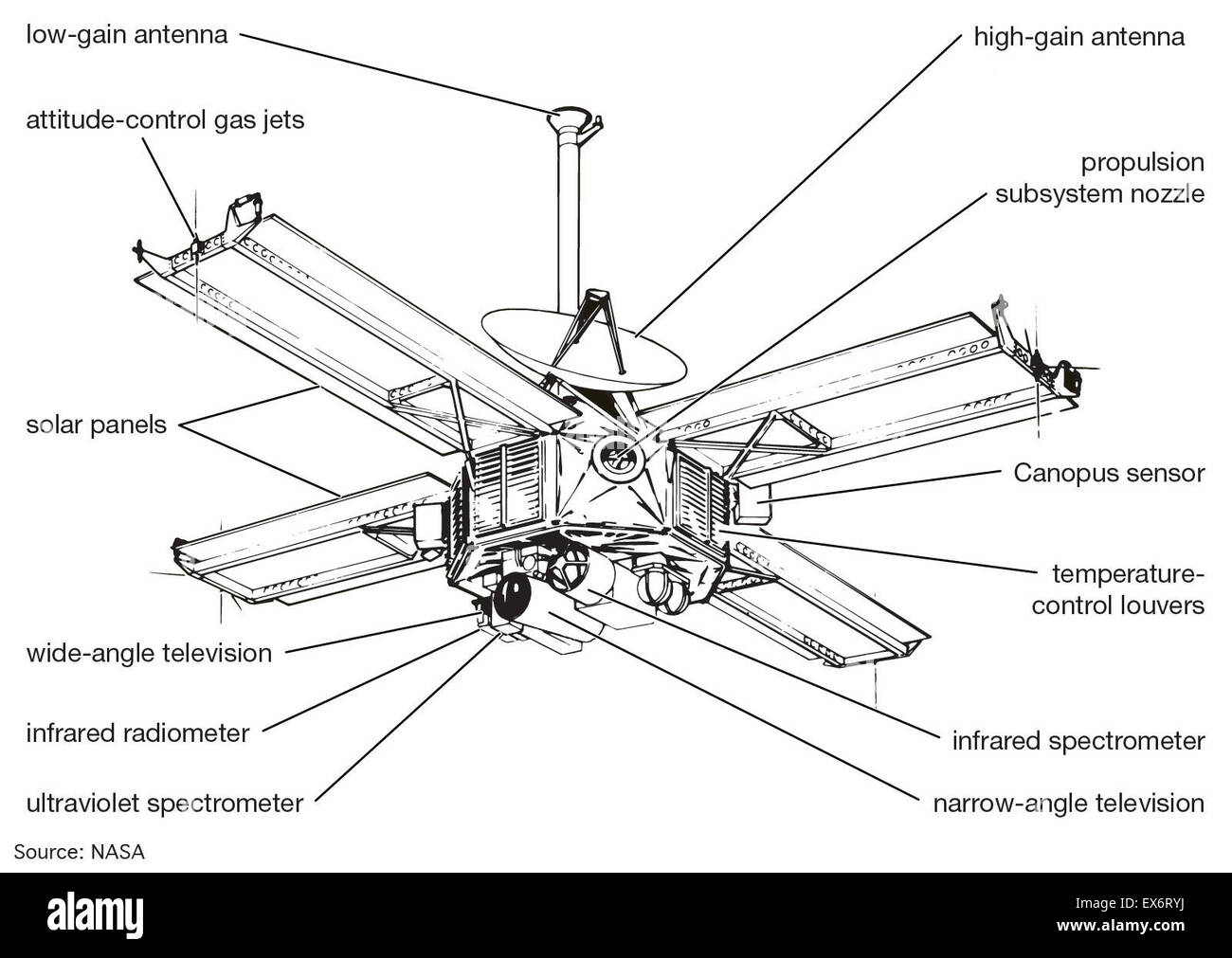 Deep-space probe: Mariners 6 and 7 Stock Photohttps://www.alamy.com/image-license-details/?v=1https://www.alamy.com/stock-photo-deep-space-probe-mariners-6-and-7-84973046.html
Deep-space probe: Mariners 6 and 7 Stock Photohttps://www.alamy.com/image-license-details/?v=1https://www.alamy.com/stock-photo-deep-space-probe-mariners-6-and-7-84973046.htmlRMEX6RYJ–Deep-space probe: Mariners 6 and 7
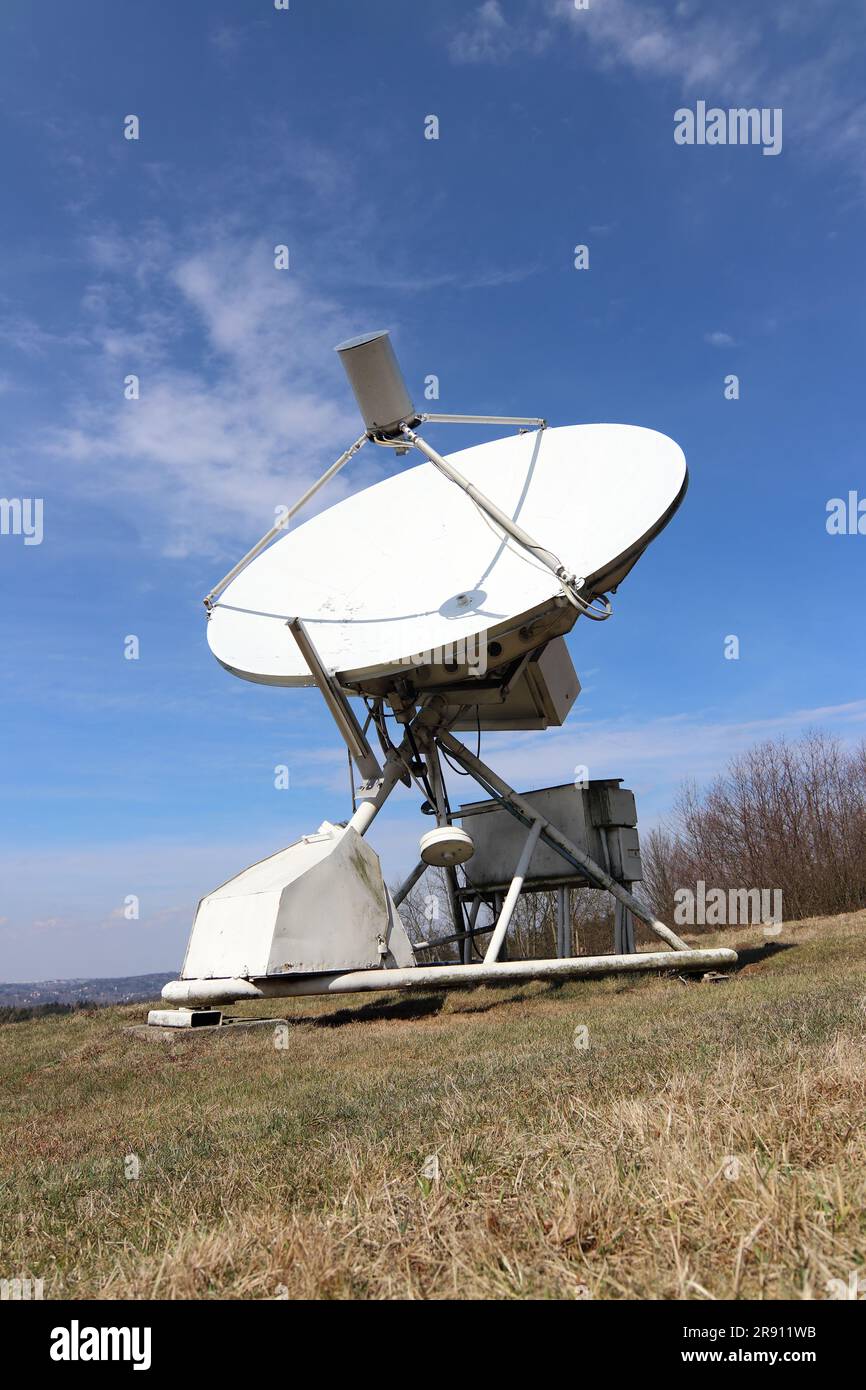 Radiotelescope - directional antenna used in radio astronomy to receive and collect data from satellites and space probes Stock Photohttps://www.alamy.com/image-license-details/?v=1https://www.alamy.com/radiotelescope-directional-antenna-used-in-radio-astronomy-to-receive-and-collect-data-from-satellites-and-space-probes-image556287127.html
Radiotelescope - directional antenna used in radio astronomy to receive and collect data from satellites and space probes Stock Photohttps://www.alamy.com/image-license-details/?v=1https://www.alamy.com/radiotelescope-directional-antenna-used-in-radio-astronomy-to-receive-and-collect-data-from-satellites-and-space-probes-image556287127.htmlRF2R911WB–Radiotelescope - directional antenna used in radio astronomy to receive and collect data from satellites and space probes
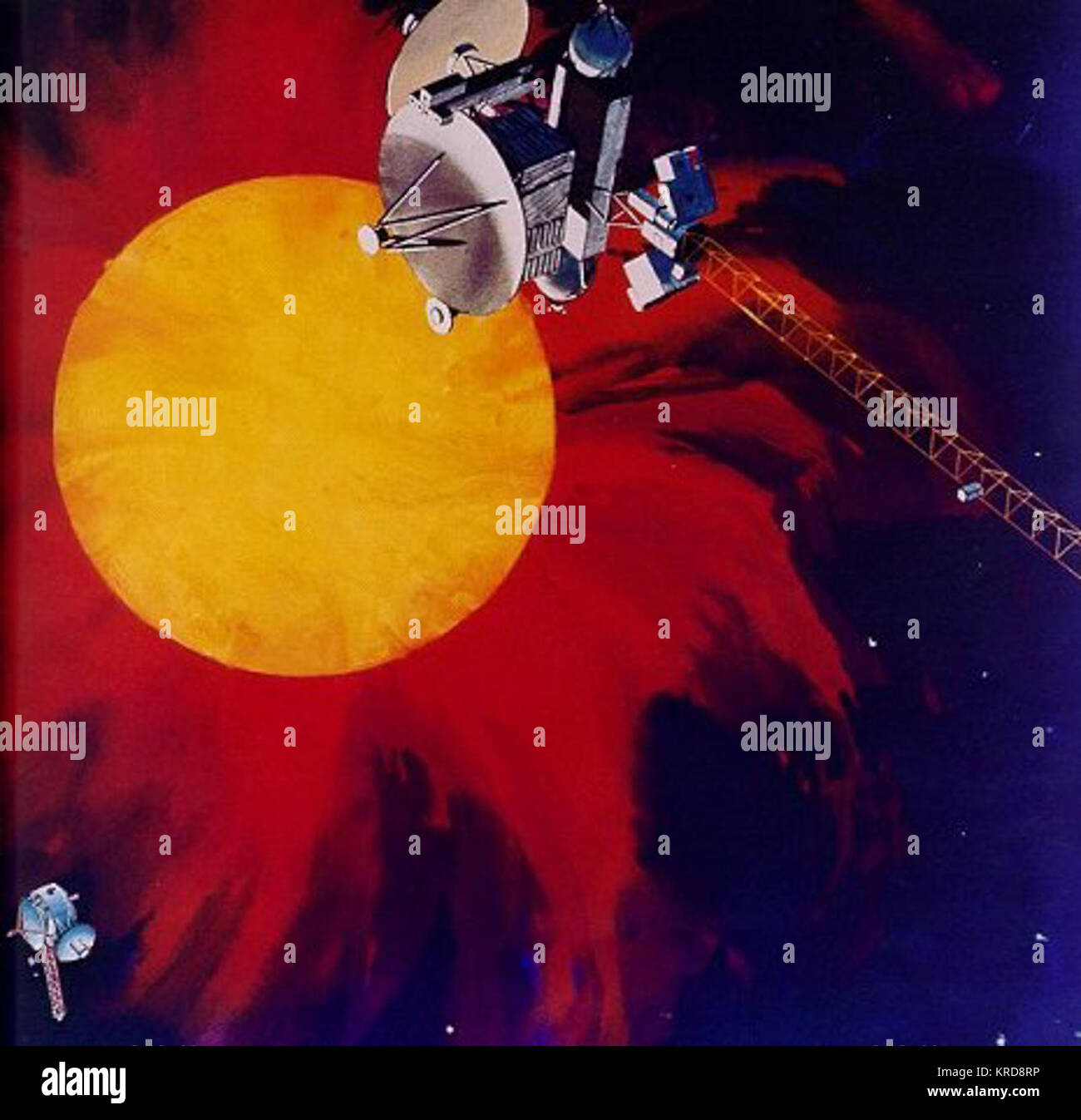 ISPM space probes Stock Photohttps://www.alamy.com/image-license-details/?v=1https://www.alamy.com/stock-image-ispm-space-probes-169322714.html
ISPM space probes Stock Photohttps://www.alamy.com/image-license-details/?v=1https://www.alamy.com/stock-image-ispm-space-probes-169322714.htmlRMKRD8RP–ISPM space probes
RME14A4E–Apr. 17, 2012 - Tracker's Trophy: Professor A.C.B. Lovell, Director of the Manchestor University Radio Telescope and Experimental Station at Jodell Bank, Cheshire England, site at his deak with a model of Pioneer I (left), the American space vehicle, presented to him by American scientists for the University's part in the exploration of center space. Behind him is the ''spider web'' of part of the giant apparatus, the world's largest fully steerable radio telescope, that on request has tracked both American and Russian space probes.
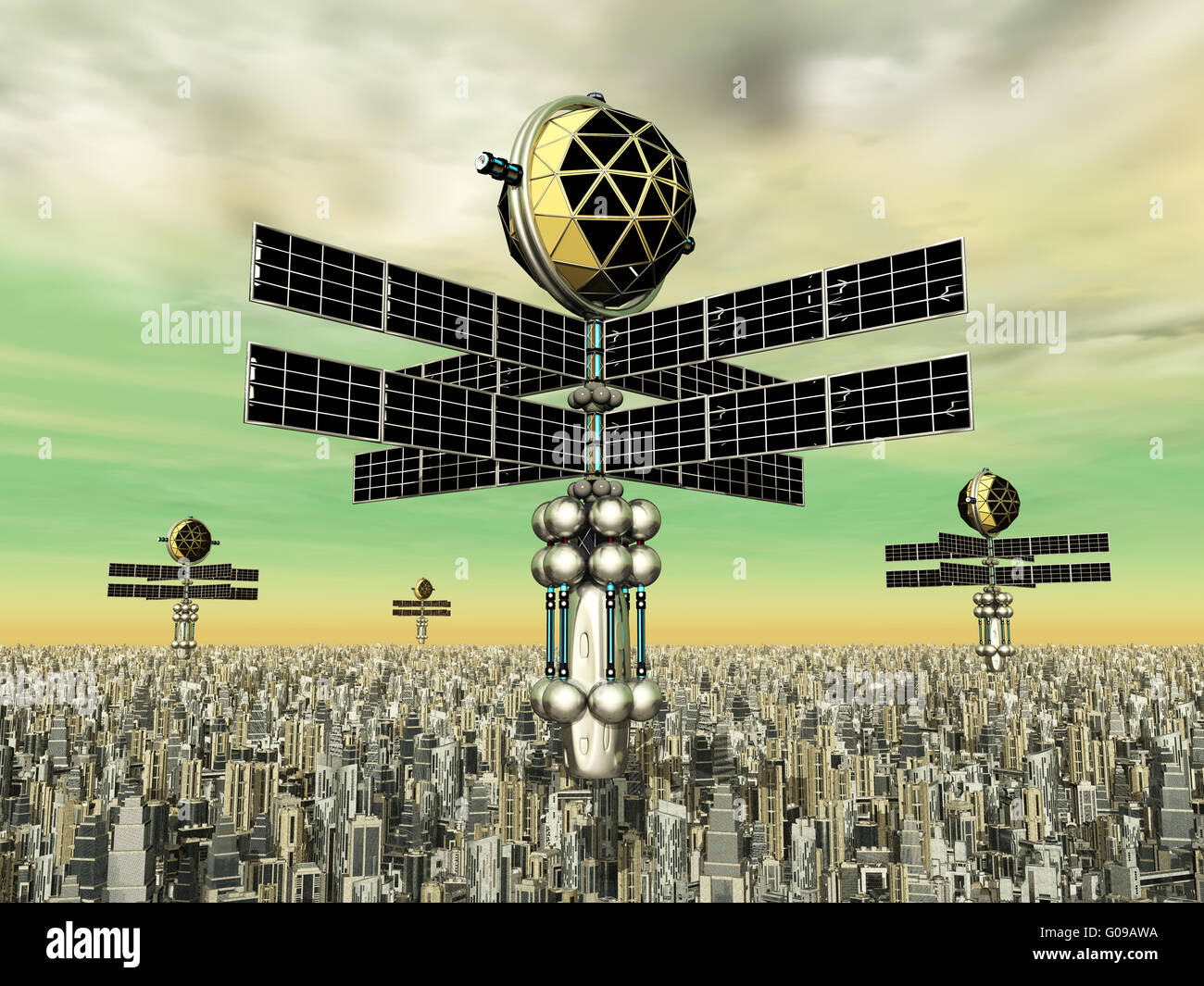 Megacity and Space Probes Stock Photohttps://www.alamy.com/image-license-details/?v=1https://www.alamy.com/stock-photo-megacity-and-space-probes-103468326.html
Megacity and Space Probes Stock Photohttps://www.alamy.com/image-license-details/?v=1https://www.alamy.com/stock-photo-megacity-and-space-probes-103468326.htmlRMG09AWA–Megacity and Space Probes
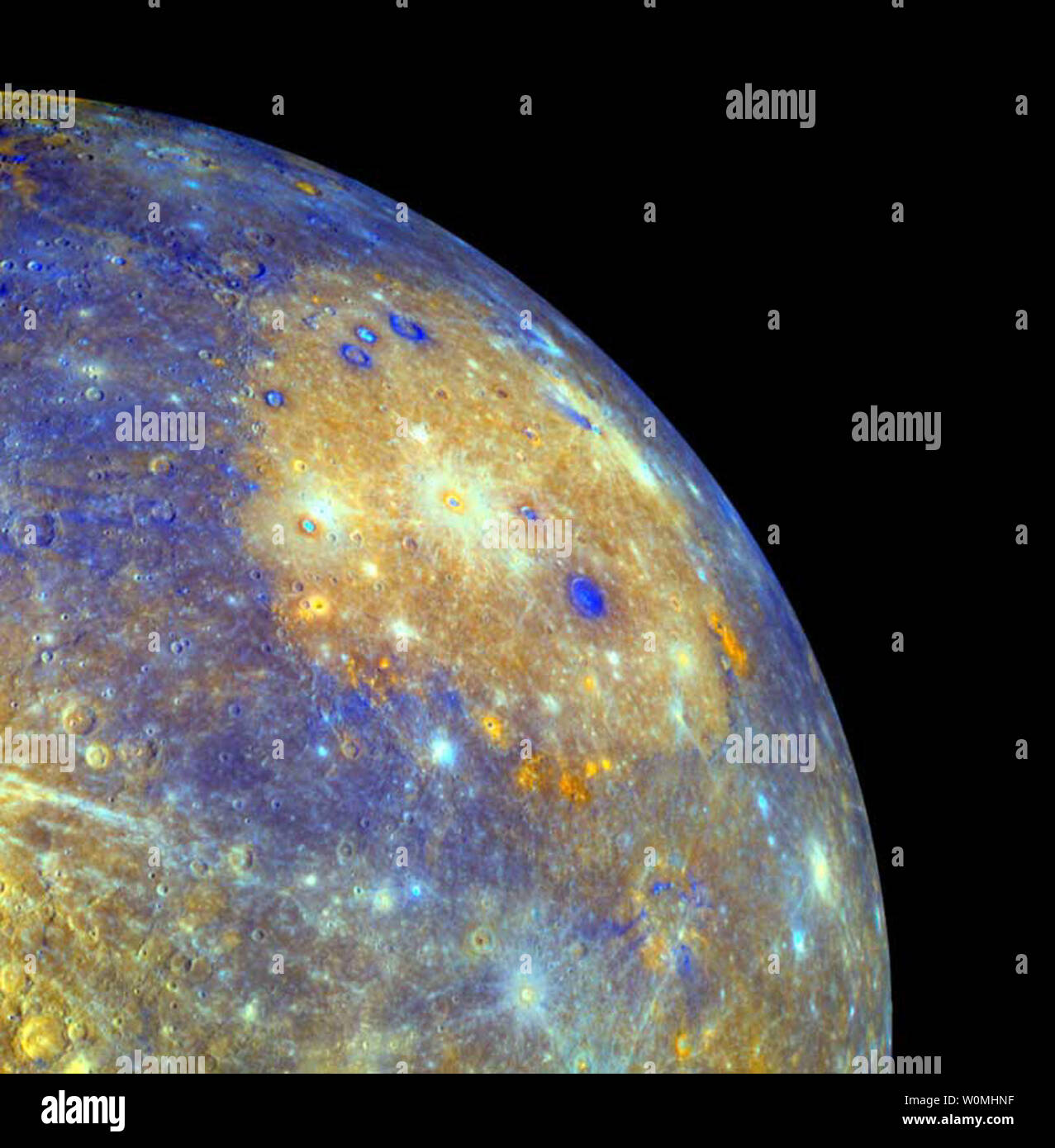 This NASA image released in 2008 shows an enhanced image of Mercury from the Messenger space probe's flyby of the planet. NASA said the Messenger space probe successfully entered Mercury's orbit Thursday night. This marks the first time a spacecraft has entered orbit of our solar system's innermost planet. UPI/NASA.. Stock Photohttps://www.alamy.com/image-license-details/?v=1https://www.alamy.com/this-nasa-image-released-in-2008-shows-an-enhanced-image-of-mercury-from-the-messenger-space-probes-flyby-of-the-planet-nasa-said-the-messenger-space-probe-successfully-entered-mercurys-orbit-thursday-night-this-marks-the-first-time-a-spacecraft-has-entered-orbit-of-our-solar-systems-innermost-planet-upinasa-image258608491.html
This NASA image released in 2008 shows an enhanced image of Mercury from the Messenger space probe's flyby of the planet. NASA said the Messenger space probe successfully entered Mercury's orbit Thursday night. This marks the first time a spacecraft has entered orbit of our solar system's innermost planet. UPI/NASA.. Stock Photohttps://www.alamy.com/image-license-details/?v=1https://www.alamy.com/this-nasa-image-released-in-2008-shows-an-enhanced-image-of-mercury-from-the-messenger-space-probes-flyby-of-the-planet-nasa-said-the-messenger-space-probe-successfully-entered-mercurys-orbit-thursday-night-this-marks-the-first-time-a-spacecraft-has-entered-orbit-of-our-solar-systems-innermost-planet-upinasa-image258608491.htmlRMW0MHNF–This NASA image released in 2008 shows an enhanced image of Mercury from the Messenger space probe's flyby of the planet. NASA said the Messenger space probe successfully entered Mercury's orbit Thursday night. This marks the first time a spacecraft has entered orbit of our solar system's innermost planet. UPI/NASA..
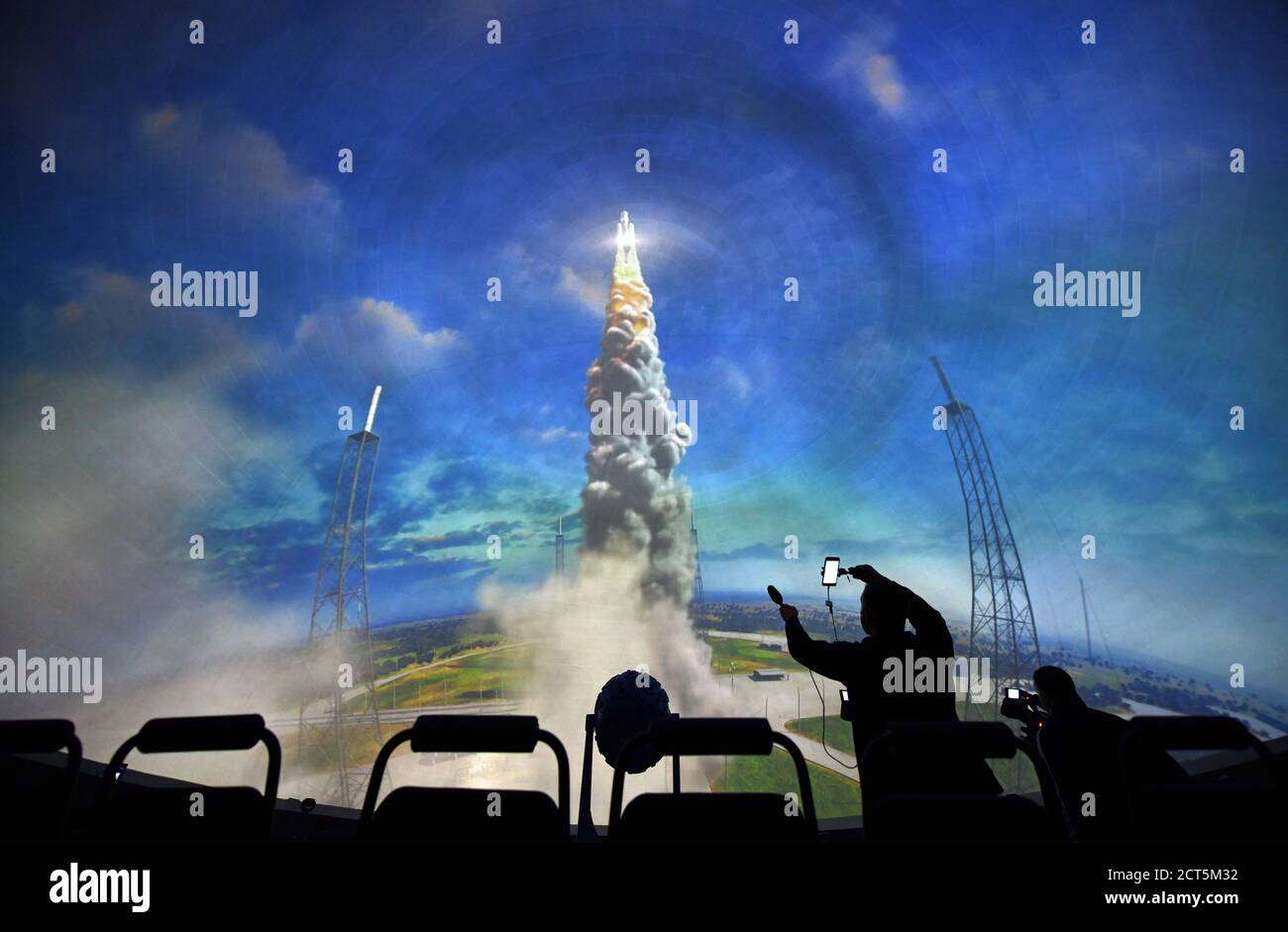 21 September 2020, Thuringia, Jena: The program 'Voyager - The Infinite Mission' will be presented during a press conference at the Zeiss Planetarium Jena. From 23 September, visitors to the demonstrations will be able to see images of the outermost planets of the solar system and their moons, which were taken by the US space probes Voyager 1 and 2. The planetarium had to close for almost three months in spring due to the Corona Pandemic. It has only been receiving visitors again since 9 June. Photo: Martin Schutt/dpa-Zentralbild/dpa - ATTENTION: For editorial use only and only with full menti Stock Photohttps://www.alamy.com/image-license-details/?v=1https://www.alamy.com/21-september-2020-thuringia-jena-the-program-voyager-the-infinite-mission-will-be-presented-during-a-press-conference-at-the-zeiss-planetarium-jena-from-23-september-visitors-to-the-demonstrations-will-be-able-to-see-images-of-the-outermost-planets-of-the-solar-system-and-their-moons-which-were-taken-by-the-us-space-probes-voyager-1-and-2-the-planetarium-had-to-close-for-almost-three-months-in-spring-due-to-the-corona-pandemic-it-has-only-been-receiving-visitors-again-since-9-june-photo-martin-schuttdpa-zentralbilddpa-attention-for-editorial-use-only-and-only-with-full-menti-image376294998.html
21 September 2020, Thuringia, Jena: The program 'Voyager - The Infinite Mission' will be presented during a press conference at the Zeiss Planetarium Jena. From 23 September, visitors to the demonstrations will be able to see images of the outermost planets of the solar system and their moons, which were taken by the US space probes Voyager 1 and 2. The planetarium had to close for almost three months in spring due to the Corona Pandemic. It has only been receiving visitors again since 9 June. Photo: Martin Schutt/dpa-Zentralbild/dpa - ATTENTION: For editorial use only and only with full menti Stock Photohttps://www.alamy.com/image-license-details/?v=1https://www.alamy.com/21-september-2020-thuringia-jena-the-program-voyager-the-infinite-mission-will-be-presented-during-a-press-conference-at-the-zeiss-planetarium-jena-from-23-september-visitors-to-the-demonstrations-will-be-able-to-see-images-of-the-outermost-planets-of-the-solar-system-and-their-moons-which-were-taken-by-the-us-space-probes-voyager-1-and-2-the-planetarium-had-to-close-for-almost-three-months-in-spring-due-to-the-corona-pandemic-it-has-only-been-receiving-visitors-again-since-9-june-photo-martin-schuttdpa-zentralbilddpa-attention-for-editorial-use-only-and-only-with-full-menti-image376294998.htmlRM2CT5M32–21 September 2020, Thuringia, Jena: The program 'Voyager - The Infinite Mission' will be presented during a press conference at the Zeiss Planetarium Jena. From 23 September, visitors to the demonstrations will be able to see images of the outermost planets of the solar system and their moons, which were taken by the US space probes Voyager 1 and 2. The planetarium had to close for almost three months in spring due to the Corona Pandemic. It has only been receiving visitors again since 9 June. Photo: Martin Schutt/dpa-Zentralbild/dpa - ATTENTION: For editorial use only and only with full menti
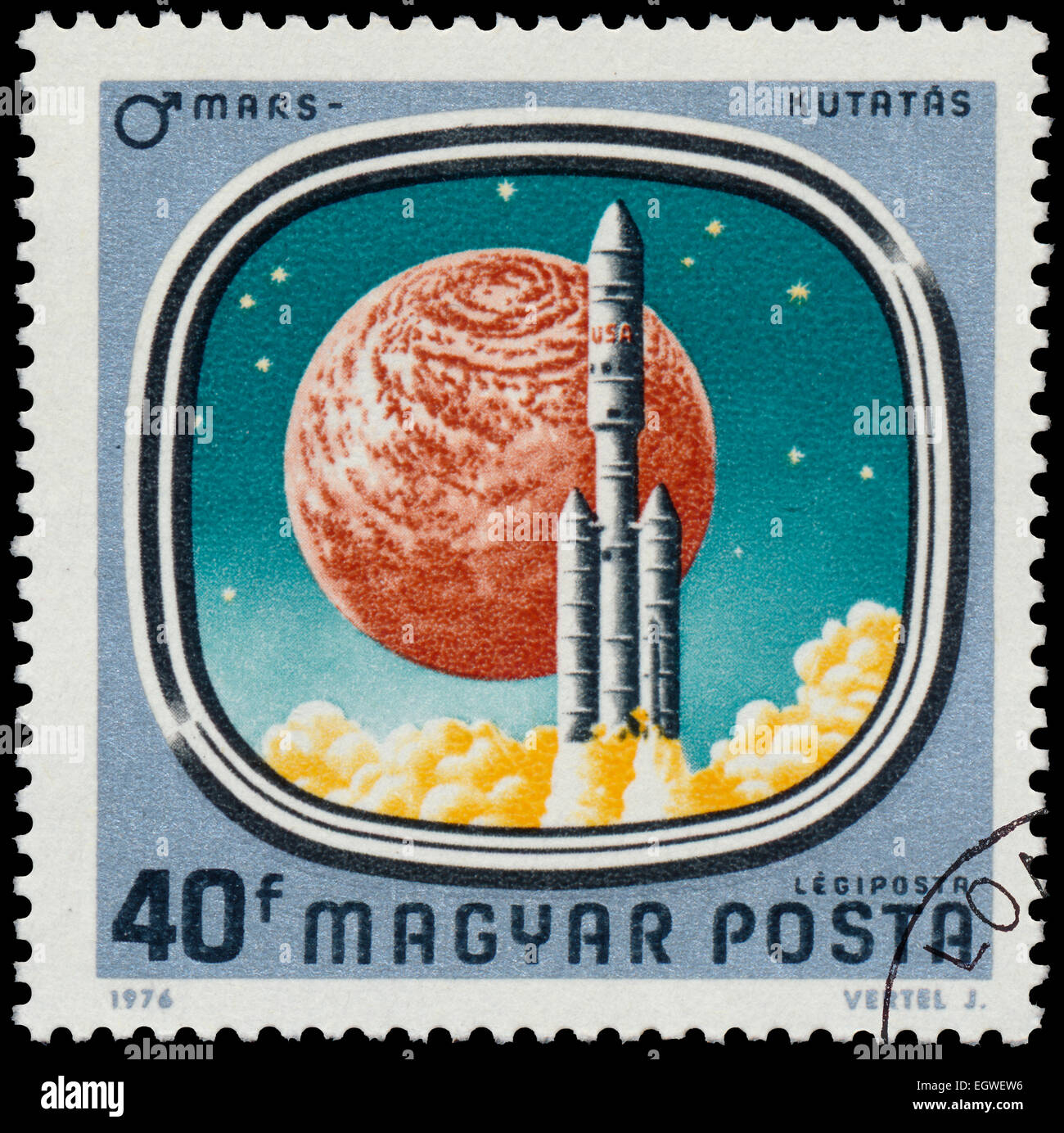 HUNGARY - CIRCA 1976: Stamp printed in Hungary shows Launch of Viking, with the same inscription, from the series 'Space Probes Stock Photohttps://www.alamy.com/image-license-details/?v=1https://www.alamy.com/stock-photo-hungary-circa-1976-stamp-printed-in-hungary-shows-launch-of-viking-79236450.html
HUNGARY - CIRCA 1976: Stamp printed in Hungary shows Launch of Viking, with the same inscription, from the series 'Space Probes Stock Photohttps://www.alamy.com/image-license-details/?v=1https://www.alamy.com/stock-photo-hungary-circa-1976-stamp-printed-in-hungary-shows-launch-of-viking-79236450.htmlRFEGWEW6–HUNGARY - CIRCA 1976: Stamp printed in Hungary shows Launch of Viking, with the same inscription, from the series 'Space Probes
 Text sign showing Any Questions. Word Written on Clueless Blank face Inquiry Disputes Probes Issues Riddles Rocket Ship Launching Fast Straight Up To The Outer Space. Stock Photohttps://www.alamy.com/image-license-details/?v=1https://www.alamy.com/text-sign-showing-any-questions-word-written-on-clueless-blank-face-inquiry-disputes-probes-issues-riddles-rocket-ship-launching-fast-straight-up-to-the-outer-space-image483603195.html
Text sign showing Any Questions. Word Written on Clueless Blank face Inquiry Disputes Probes Issues Riddles Rocket Ship Launching Fast Straight Up To The Outer Space. Stock Photohttps://www.alamy.com/image-license-details/?v=1https://www.alamy.com/text-sign-showing-any-questions-word-written-on-clueless-blank-face-inquiry-disputes-probes-issues-riddles-rocket-ship-launching-fast-straight-up-to-the-outer-space-image483603195.htmlRF2K2P0PK–Text sign showing Any Questions. Word Written on Clueless Blank face Inquiry Disputes Probes Issues Riddles Rocket Ship Launching Fast Straight Up To The Outer Space.
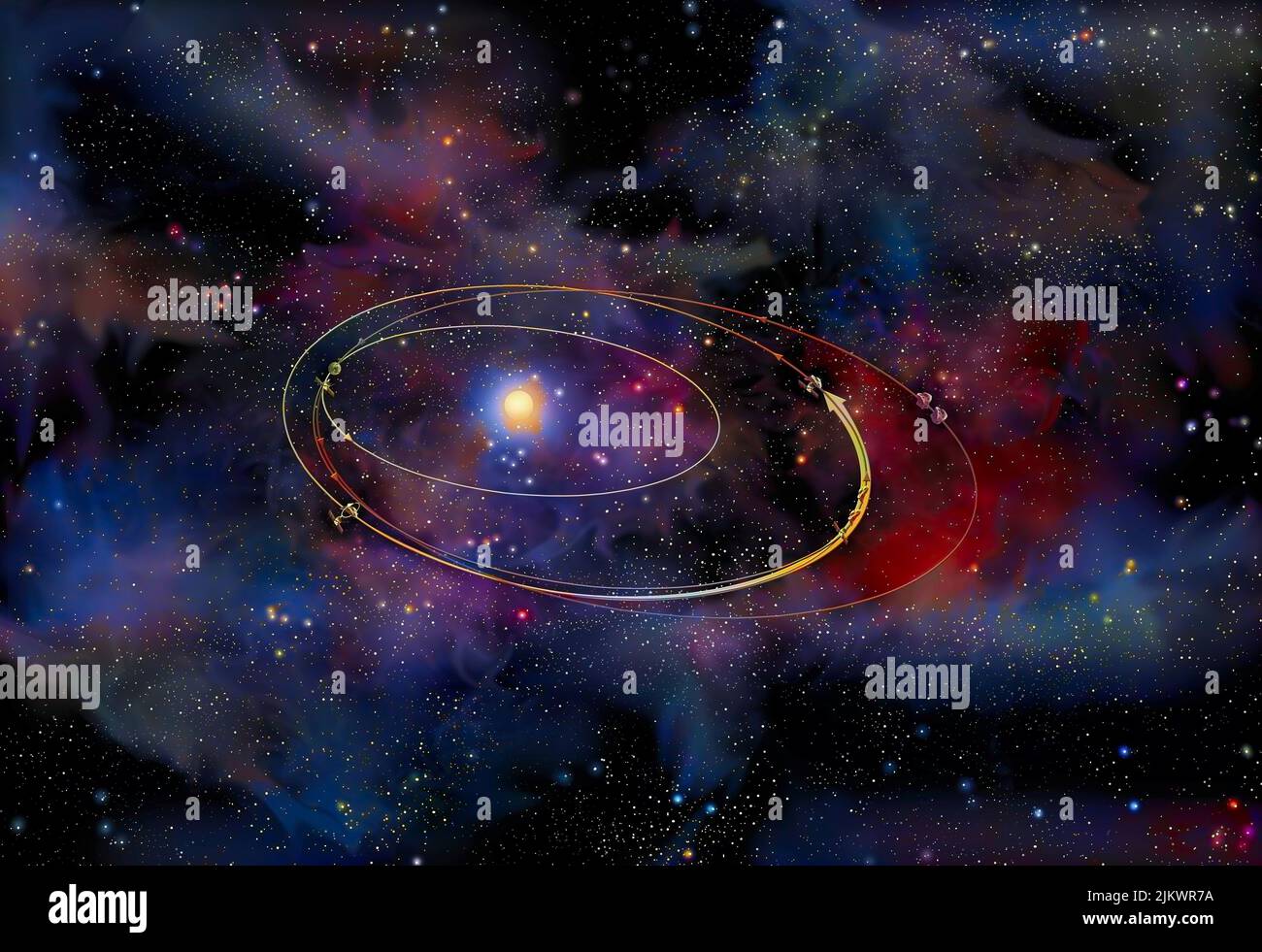 The asteroid Eros: sending the American probe Near into space for observations. Stock Photohttps://www.alamy.com/image-license-details/?v=1https://www.alamy.com/the-asteroid-eros-sending-the-american-probe-near-into-space-for-observations-image476925438.html
The asteroid Eros: sending the American probe Near into space for observations. Stock Photohttps://www.alamy.com/image-license-details/?v=1https://www.alamy.com/the-asteroid-eros-sending-the-american-probe-near-into-space-for-observations-image476925438.htmlRF2JKWR7A–The asteroid Eros: sending the American probe Near into space for observations.
RM2RKNPCD–Bildnummer: 57372782 Datum: 12.03.2012 Copyright: imago/Xinhua (120312) -- SHANGHAI, March 12, 2012 (Xinhua) -- Two workers build the radio telescope in Shanghai, east China,March 12, 2012. The 65-meter-diameter telescope, a form of directional radio antenna used in radio astronomy, will be used in tracking and collecting data from satellites and space probes including Chinese astronomical projects like Chang e lunar probe, YH-1 Mars exploration and other deep space explorations. The antenna structure of the telescope is scheduled to be finished by September 2012 and the facility is set to b
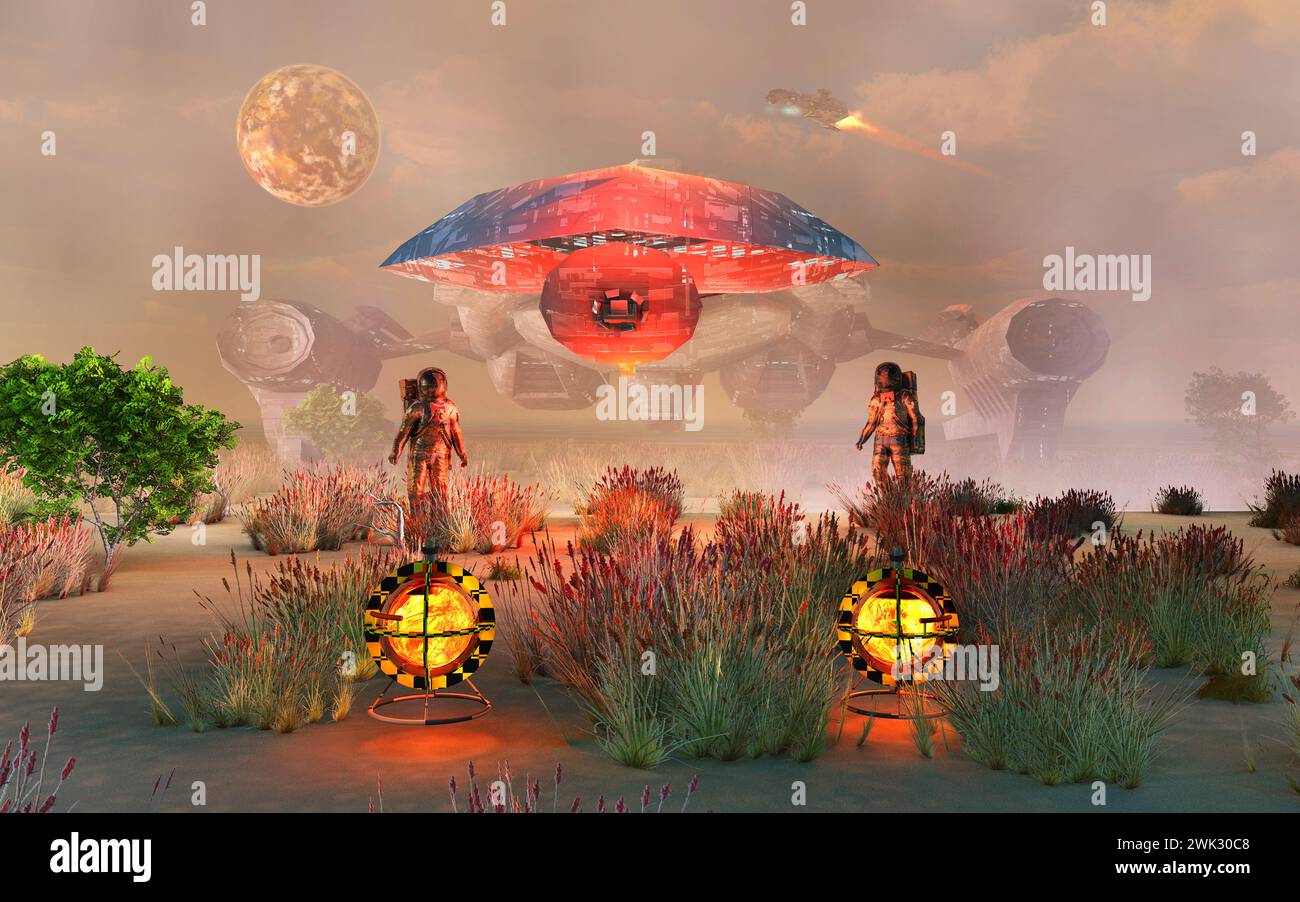 Heavy Space Cruiser Stock Photohttps://www.alamy.com/image-license-details/?v=1https://www.alamy.com/heavy-space-cruiser-image596897176.html
Heavy Space Cruiser Stock Photohttps://www.alamy.com/image-license-details/?v=1https://www.alamy.com/heavy-space-cruiser-image596897176.htmlRM2WK30C8–Heavy Space Cruiser
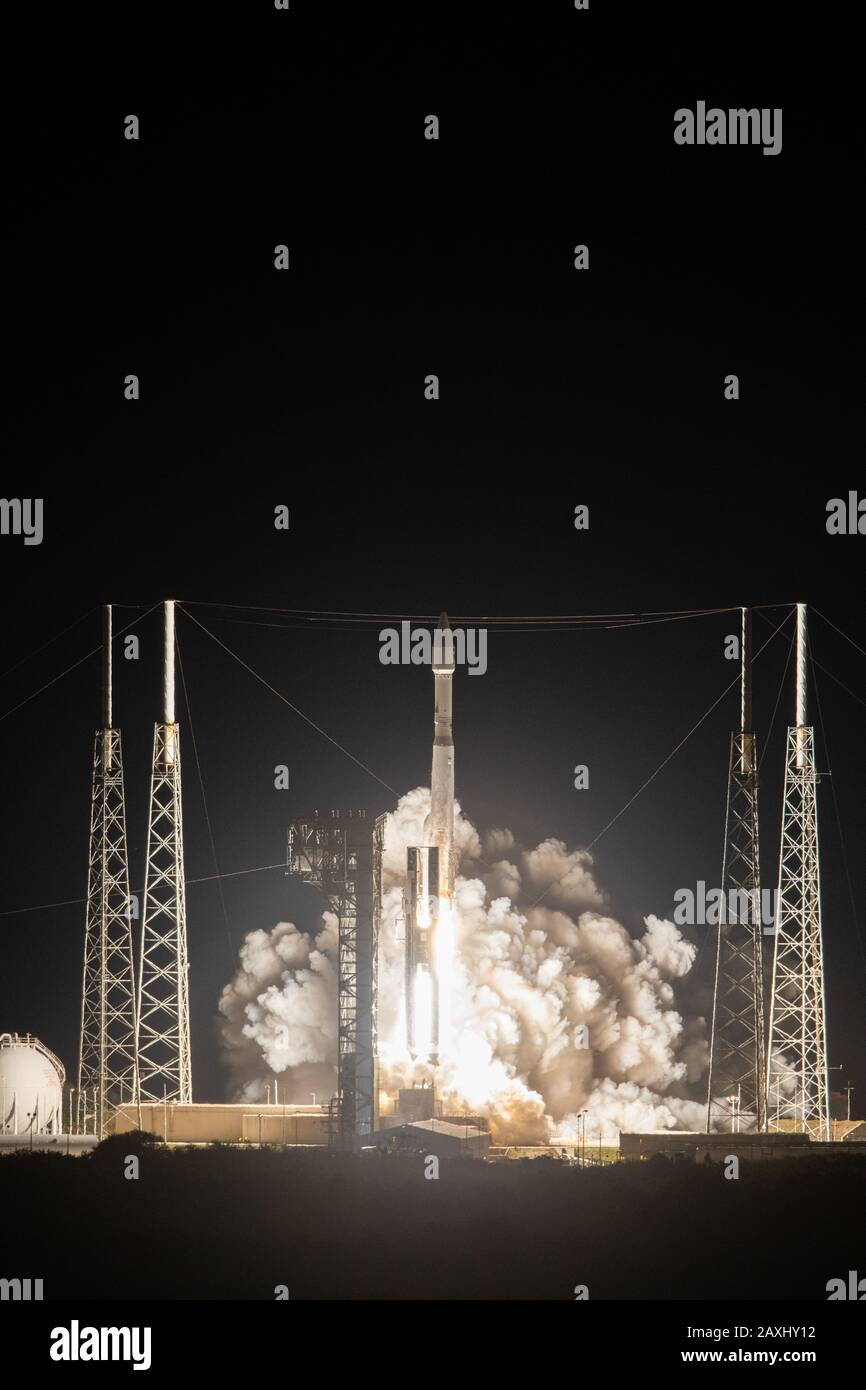 CAPE CANAVERAL, USA - 9 Feb 2020 - The United Launch Alliance Atlas V rocket, carrying the Solar Orbiter, lifts off Space Launch Complex 41 at Cape Ca Stock Photohttps://www.alamy.com/image-license-details/?v=1https://www.alamy.com/cape-canaveral-usa-9-feb-2020-the-united-launch-alliance-atlas-v-rocket-carrying-the-solar-orbiter-lifts-off-space-launch-complex-41-at-cape-ca-image343372430.html
CAPE CANAVERAL, USA - 9 Feb 2020 - The United Launch Alliance Atlas V rocket, carrying the Solar Orbiter, lifts off Space Launch Complex 41 at Cape Ca Stock Photohttps://www.alamy.com/image-license-details/?v=1https://www.alamy.com/cape-canaveral-usa-9-feb-2020-the-united-launch-alliance-atlas-v-rocket-carrying-the-solar-orbiter-lifts-off-space-launch-complex-41-at-cape-ca-image343372430.htmlRM2AXHY12–CAPE CANAVERAL, USA - 9 Feb 2020 - The United Launch Alliance Atlas V rocket, carrying the Solar Orbiter, lifts off Space Launch Complex 41 at Cape Ca
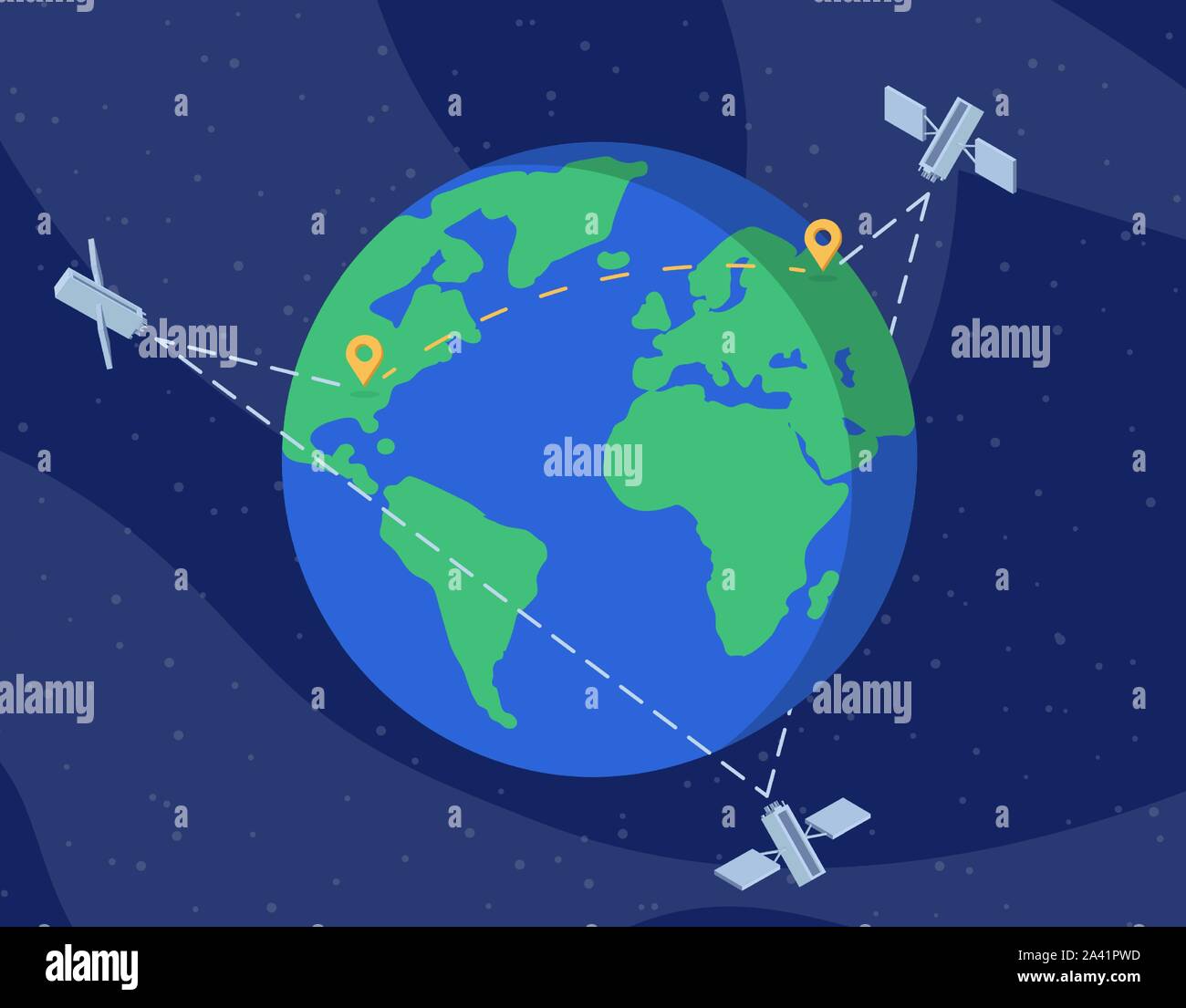 Global satellite network flat vector illustration. International communication technology, wireless information transfer cartoon concept. Telecommunication equipment, space probes and location marks Stock Vectorhttps://www.alamy.com/image-license-details/?v=1https://www.alamy.com/global-satellite-network-flat-vector-illustration-international-communication-technology-wireless-information-transfer-cartoon-concept-telecommunication-equipment-space-probes-and-location-marks-image329495529.html
Global satellite network flat vector illustration. International communication technology, wireless information transfer cartoon concept. Telecommunication equipment, space probes and location marks Stock Vectorhttps://www.alamy.com/image-license-details/?v=1https://www.alamy.com/global-satellite-network-flat-vector-illustration-international-communication-technology-wireless-information-transfer-cartoon-concept-telecommunication-equipment-space-probes-and-location-marks-image329495529.htmlRF2A41PWD–Global satellite network flat vector illustration. International communication technology, wireless information transfer cartoon concept. Telecommunication equipment, space probes and location marks
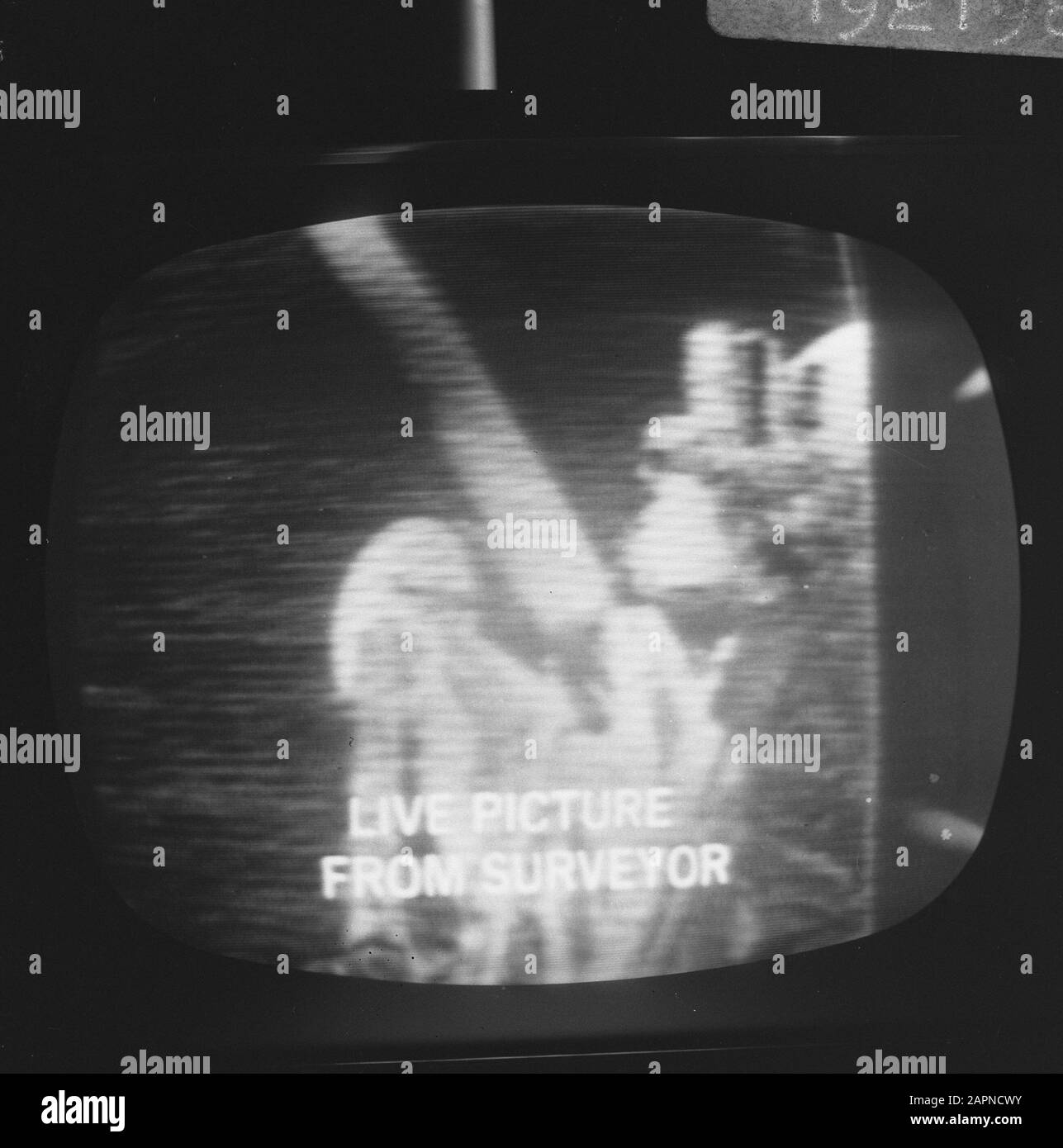 Recording of the Moon by Surveyor from TV Aff Date: June 2, 1966 Keywords: moon landings, space travel Institution name: Surveyor Stock Photohttps://www.alamy.com/image-license-details/?v=1https://www.alamy.com/recording-of-the-moon-by-surveyor-from-tv-aff-date-june-2-1966-keywords-moon-landings-space-travel-institution-name-surveyor-image340990551.html
Recording of the Moon by Surveyor from TV Aff Date: June 2, 1966 Keywords: moon landings, space travel Institution name: Surveyor Stock Photohttps://www.alamy.com/image-license-details/?v=1https://www.alamy.com/recording-of-the-moon-by-surveyor-from-tv-aff-date-june-2-1966-keywords-moon-landings-space-travel-institution-name-surveyor-image340990551.htmlRM2APNCWY–Recording of the Moon by Surveyor from TV Aff Date: June 2, 1966 Keywords: moon landings, space travel Institution name: Surveyor
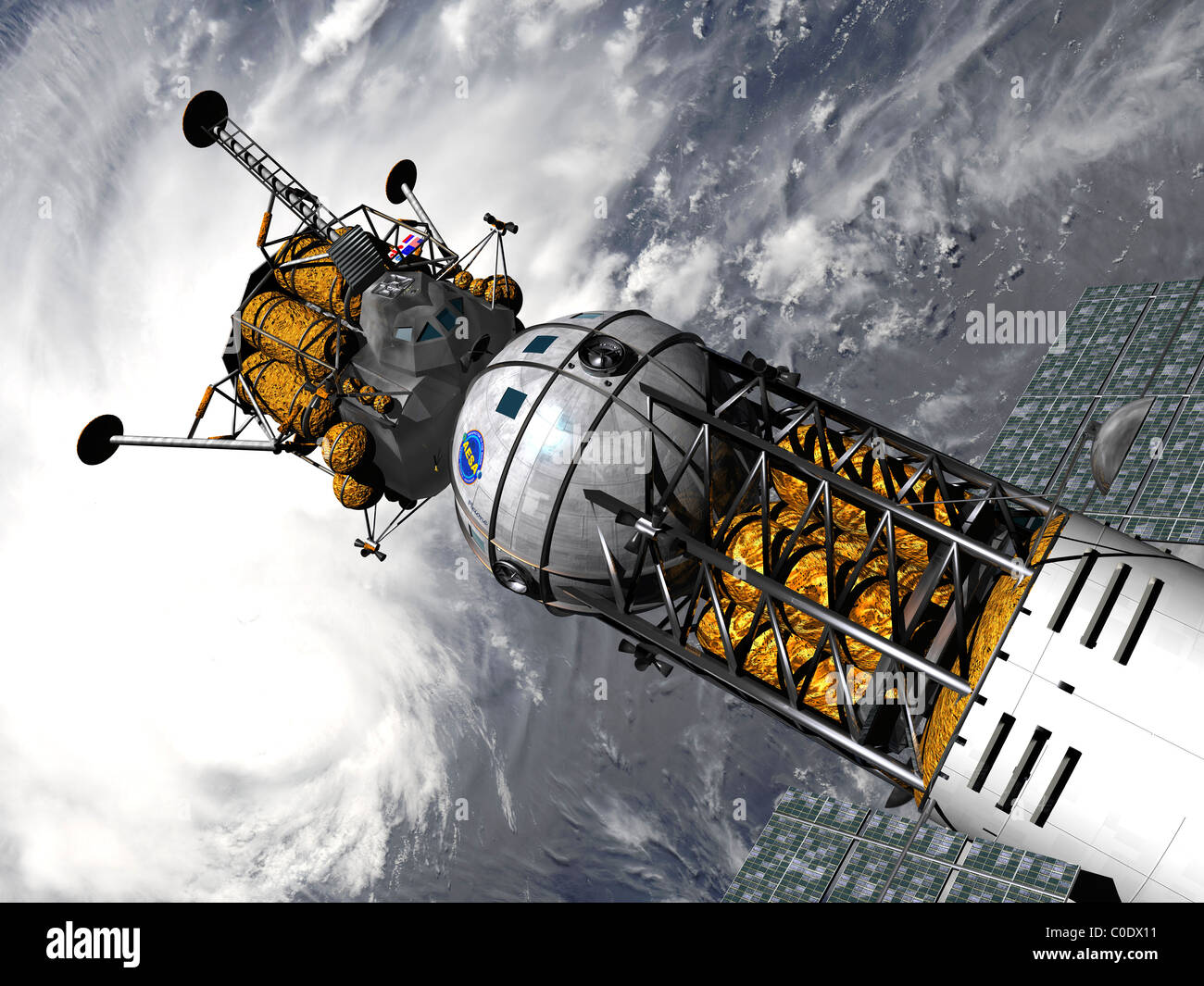 Artist's concept of a space tug docked with a lunar lander. Stock Photohttps://www.alamy.com/image-license-details/?v=1https://www.alamy.com/stock-photo-artists-concept-of-a-space-tug-docked-with-a-lunar-lander-34726525.html
Artist's concept of a space tug docked with a lunar lander. Stock Photohttps://www.alamy.com/image-license-details/?v=1https://www.alamy.com/stock-photo-artists-concept-of-a-space-tug-docked-with-a-lunar-lander-34726525.htmlRFC0DX11–Artist's concept of a space tug docked with a lunar lander.
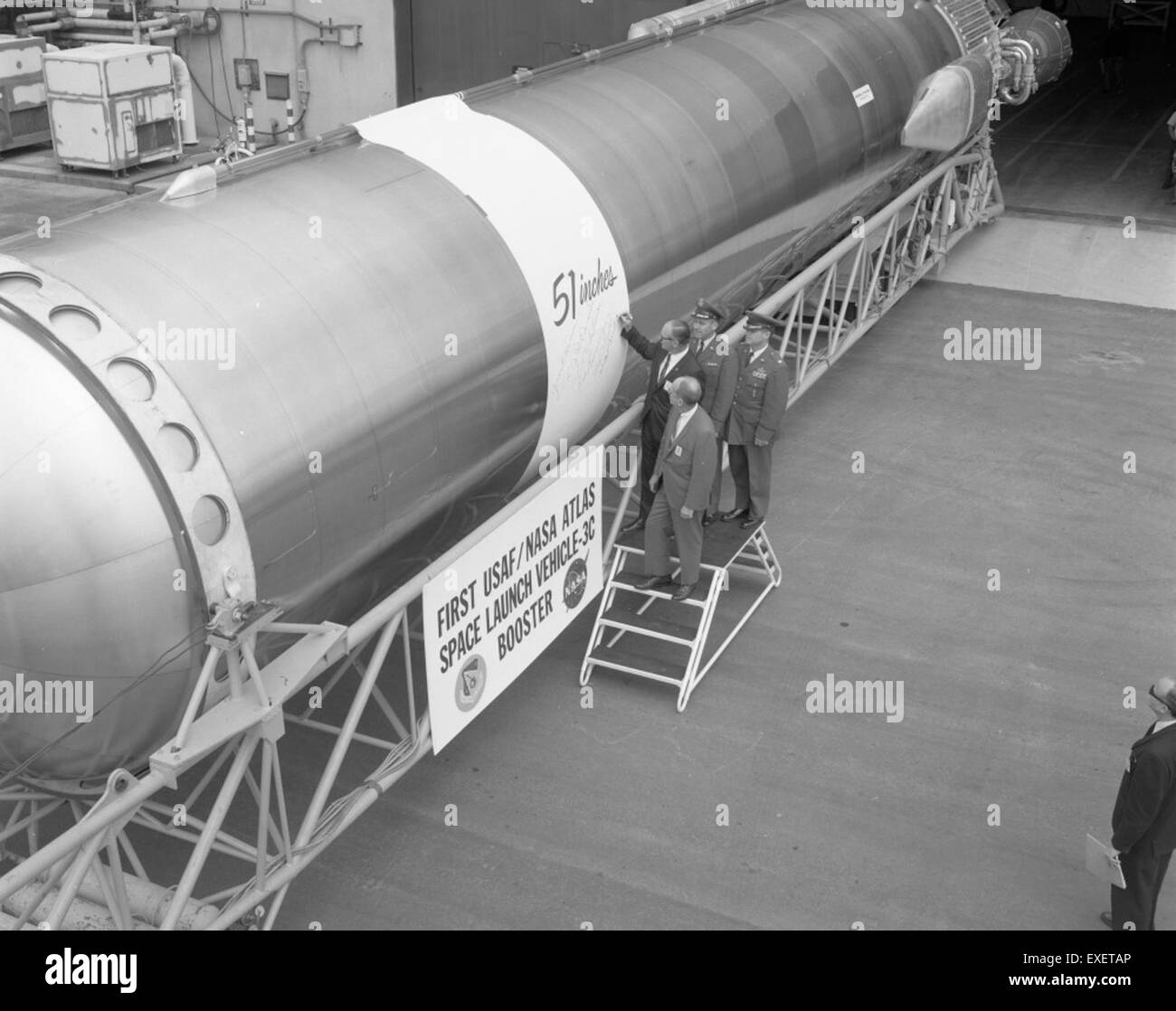 The Centaur SLV 3C rocket is shown during its first rollout on April 14, 1967. The Centaur was a significant component of U.S. space exploration efforts, used for launching satellites and space probes. The rollout included key personnel such as G. Hansen and Col. Sullivan. Stock Photohttps://www.alamy.com/image-license-details/?v=1https://www.alamy.com/stock-photo-the-centaur-slv-3c-rocket-is-shown-during-its-first-rollout-on-april-85148974.html
The Centaur SLV 3C rocket is shown during its first rollout on April 14, 1967. The Centaur was a significant component of U.S. space exploration efforts, used for launching satellites and space probes. The rollout included key personnel such as G. Hansen and Col. Sullivan. Stock Photohttps://www.alamy.com/image-license-details/?v=1https://www.alamy.com/stock-photo-the-centaur-slv-3c-rocket-is-shown-during-its-first-rollout-on-april-85148974.htmlRMEXETAP–The Centaur SLV 3C rocket is shown during its first rollout on April 14, 1967. The Centaur was a significant component of U.S. space exploration efforts, used for launching satellites and space probes. The rollout included key personnel such as G. Hansen and Col. Sullivan.
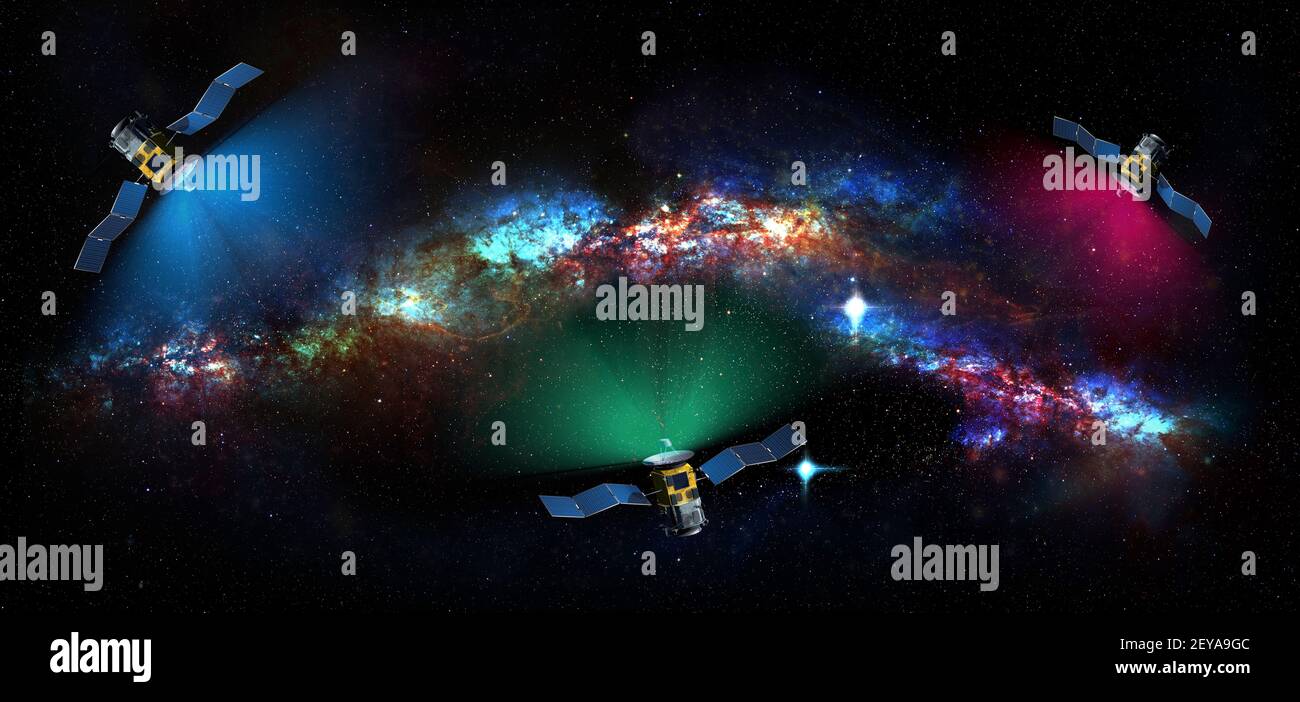 Deep space probes, illustration Stock Photohttps://www.alamy.com/image-license-details/?v=1https://www.alamy.com/deep-space-probes-illustration-image412661212.html
Deep space probes, illustration Stock Photohttps://www.alamy.com/image-license-details/?v=1https://www.alamy.com/deep-space-probes-illustration-image412661212.htmlRF2EYA9GC–Deep space probes, illustration
 Spaceships, space probes traveling through galaxy, returning planet Earth, sun rising behind - Elements of this image furnished by NASA Stock Photohttps://www.alamy.com/image-license-details/?v=1https://www.alamy.com/spaceships-space-probes-traveling-through-galaxy-returning-planet-earth-sun-rising-behind-elements-of-this-image-furnished-by-nasa-image475156188.html
Spaceships, space probes traveling through galaxy, returning planet Earth, sun rising behind - Elements of this image furnished by NASA Stock Photohttps://www.alamy.com/image-license-details/?v=1https://www.alamy.com/spaceships-space-probes-traveling-through-galaxy-returning-planet-earth-sun-rising-behind-elements-of-this-image-furnished-by-nasa-image475156188.htmlRF2JH16FT–Spaceships, space probes traveling through galaxy, returning planet Earth, sun rising behind - Elements of this image furnished by NASA
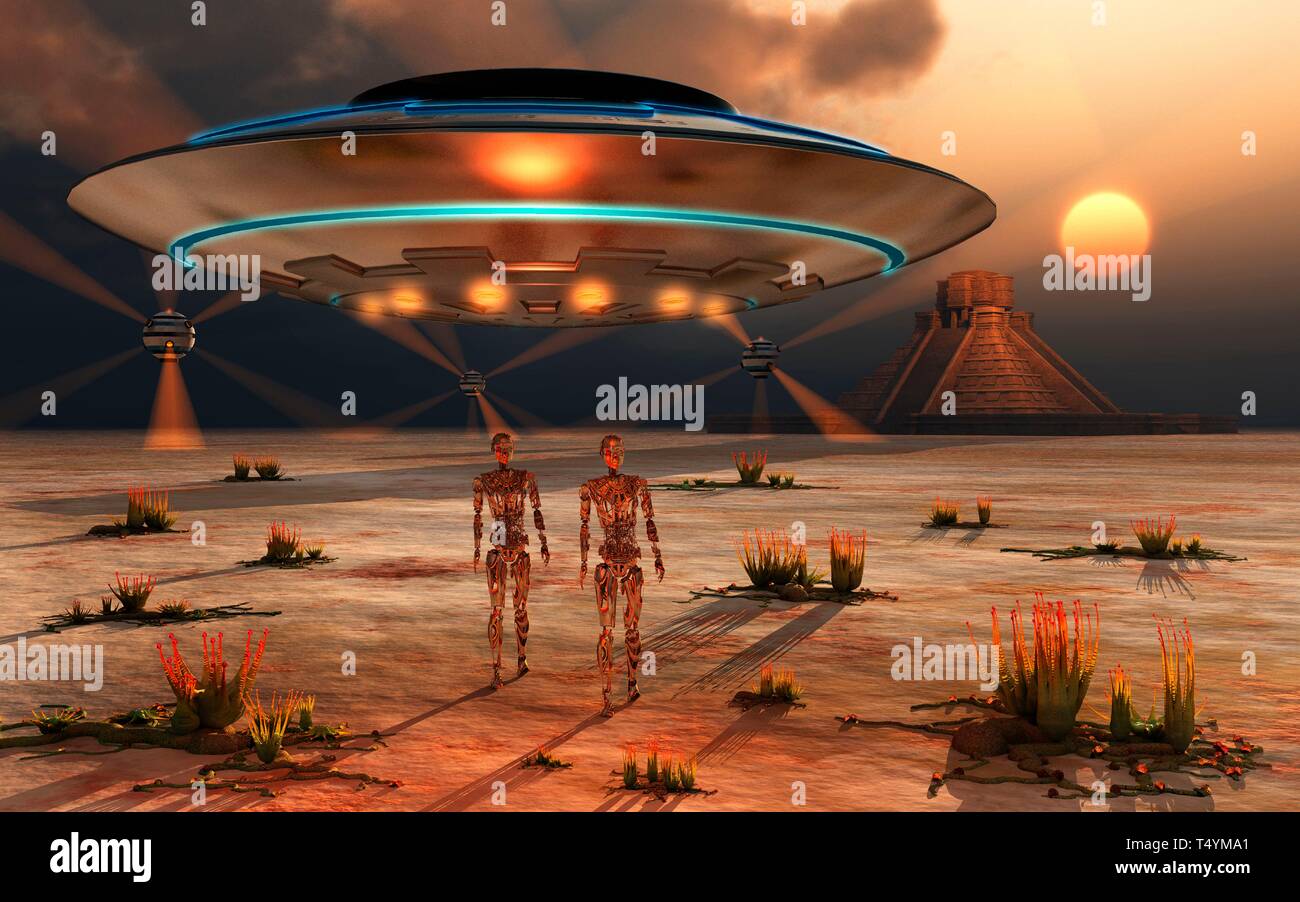 Transhumans Travelling Through Time and Space Stock Photohttps://www.alamy.com/image-license-details/?v=1https://www.alamy.com/transhumans-travelling-through-time-and-space-image244012441.html
Transhumans Travelling Through Time and Space Stock Photohttps://www.alamy.com/image-license-details/?v=1https://www.alamy.com/transhumans-travelling-through-time-and-space-image244012441.htmlRFT4YMA1–Transhumans Travelling Through Time and Space
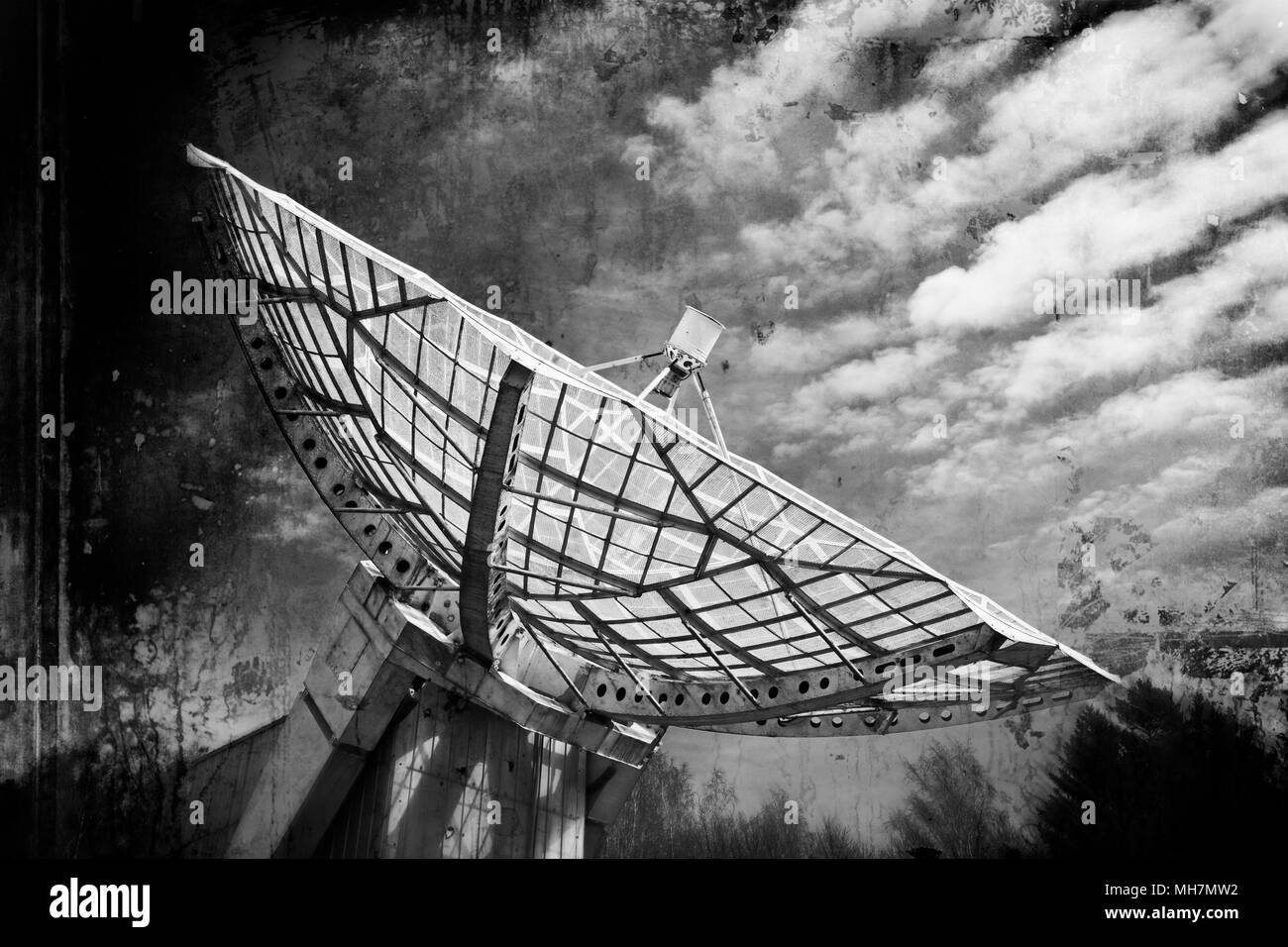 Radiotelescope in grunge style - directional antenna used in radio astronomy to receive and collect data from satellites and space probes Stock Photohttps://www.alamy.com/image-license-details/?v=1https://www.alamy.com/radiotelescope-in-grunge-style-directional-antenna-used-in-radio-astronomy-to-receive-and-collect-data-from-satellites-and-space-probes-image182722878.html
Radiotelescope in grunge style - directional antenna used in radio astronomy to receive and collect data from satellites and space probes Stock Photohttps://www.alamy.com/image-license-details/?v=1https://www.alamy.com/radiotelescope-in-grunge-style-directional-antenna-used-in-radio-astronomy-to-receive-and-collect-data-from-satellites-and-space-probes-image182722878.htmlRFMH7MW2–Radiotelescope in grunge style - directional antenna used in radio astronomy to receive and collect data from satellites and space probes
 Antonelli Stock Photohttps://www.alamy.com/image-license-details/?v=1https://www.alamy.com/stock-image-antonelli-169417563.html
Antonelli Stock Photohttps://www.alamy.com/image-license-details/?v=1https://www.alamy.com/stock-image-antonelli-169417563.htmlRMKRHHR7–Antonelli
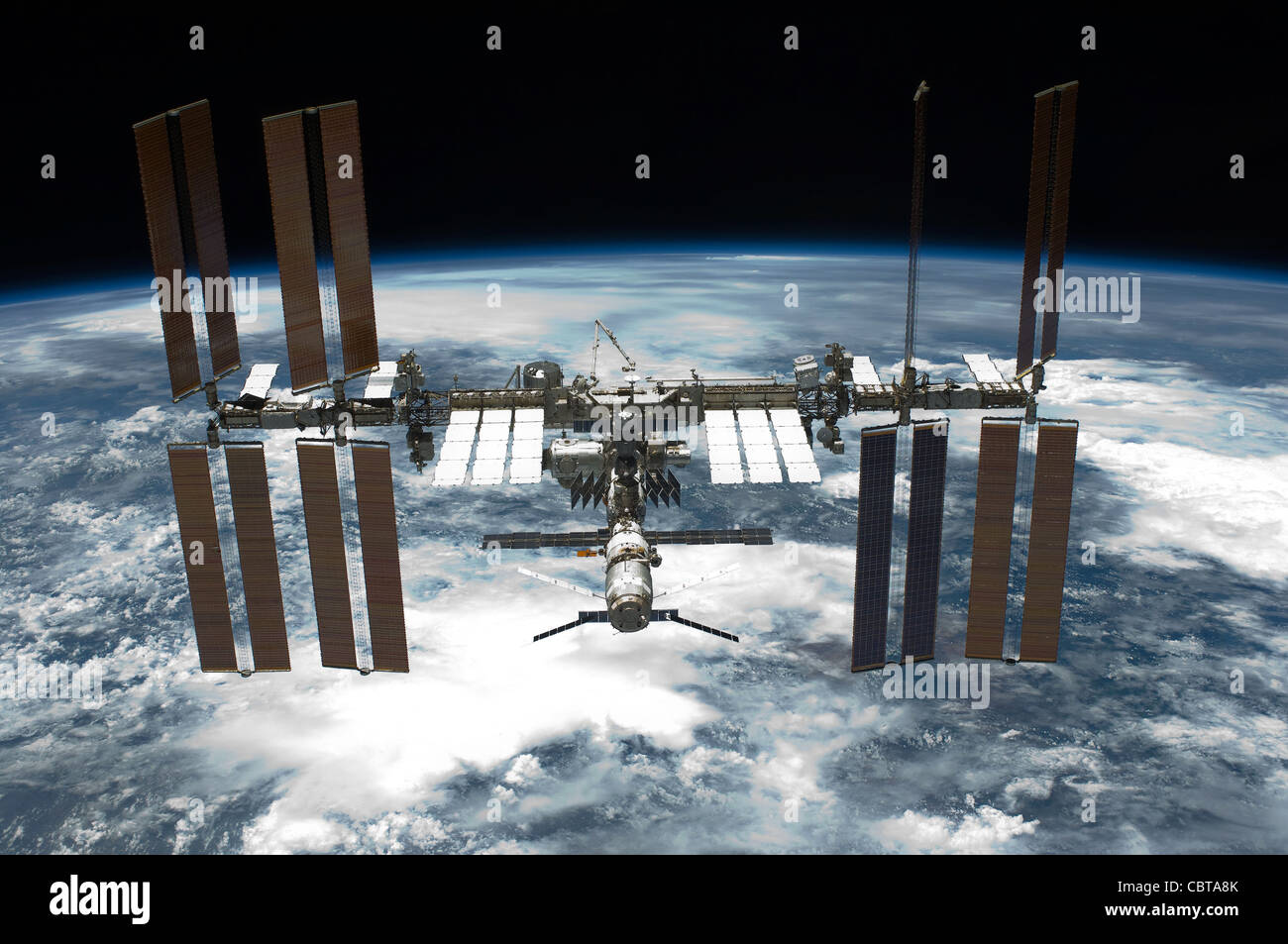 The International Space Station Space Shuttle Mission 134 as photographed from Endeavor May 2011 Stock Photohttps://www.alamy.com/image-license-details/?v=1https://www.alamy.com/stock-photo-the-international-space-station-space-shuttle-mission-134-as-photographed-41716883.html
The International Space Station Space Shuttle Mission 134 as photographed from Endeavor May 2011 Stock Photohttps://www.alamy.com/image-license-details/?v=1https://www.alamy.com/stock-photo-the-international-space-station-space-shuttle-mission-134-as-photographed-41716883.htmlRFCBTA8K–The International Space Station Space Shuttle Mission 134 as photographed from Endeavor May 2011
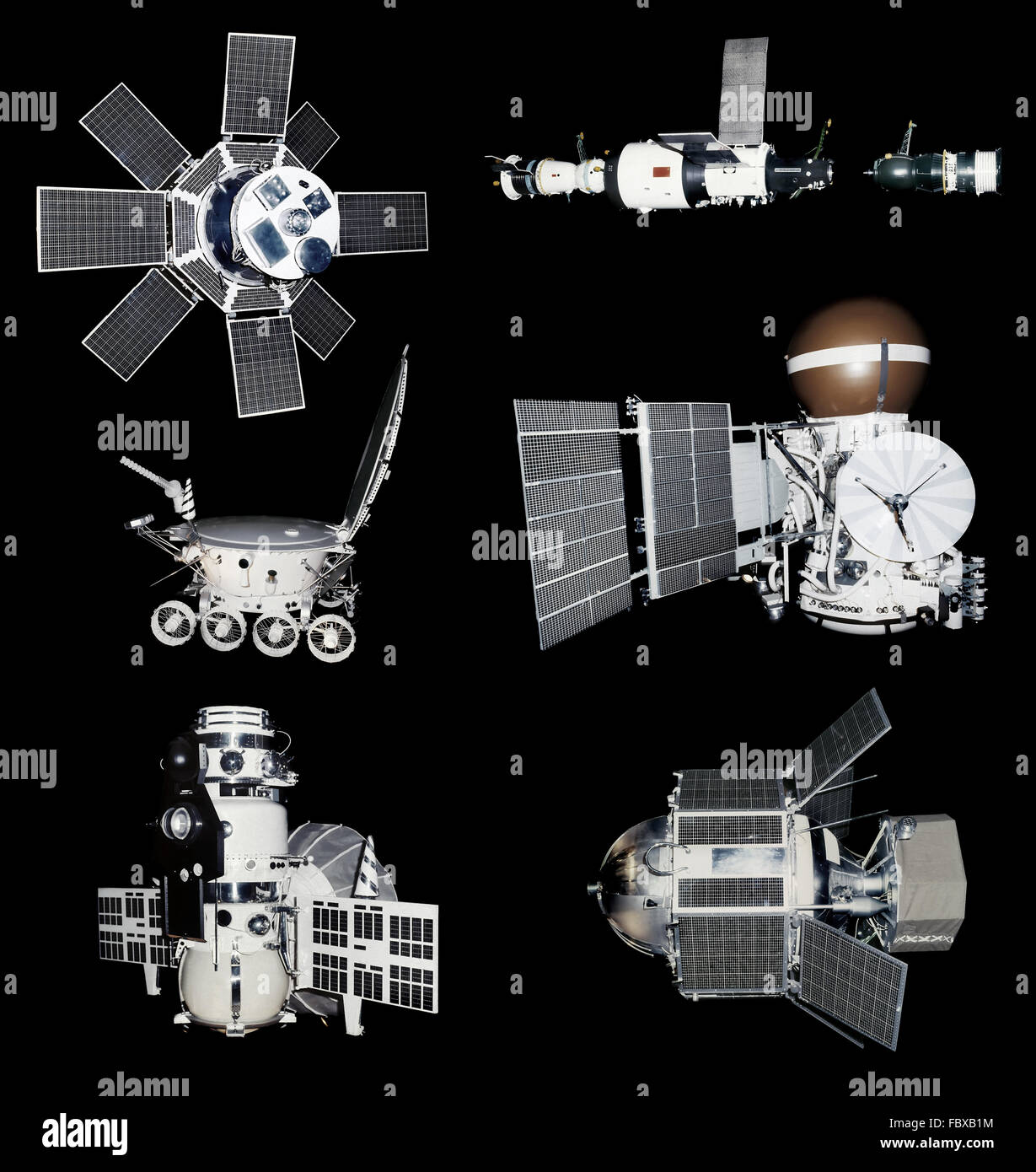 Space Ships Probes Cutout Stock Photohttps://www.alamy.com/image-license-details/?v=1https://www.alamy.com/stock-photo-space-ships-probes-cutout-93392480.html
Space Ships Probes Cutout Stock Photohttps://www.alamy.com/image-license-details/?v=1https://www.alamy.com/stock-photo-space-ships-probes-cutout-93392480.htmlRFFBXB1M–Space Ships Probes Cutout
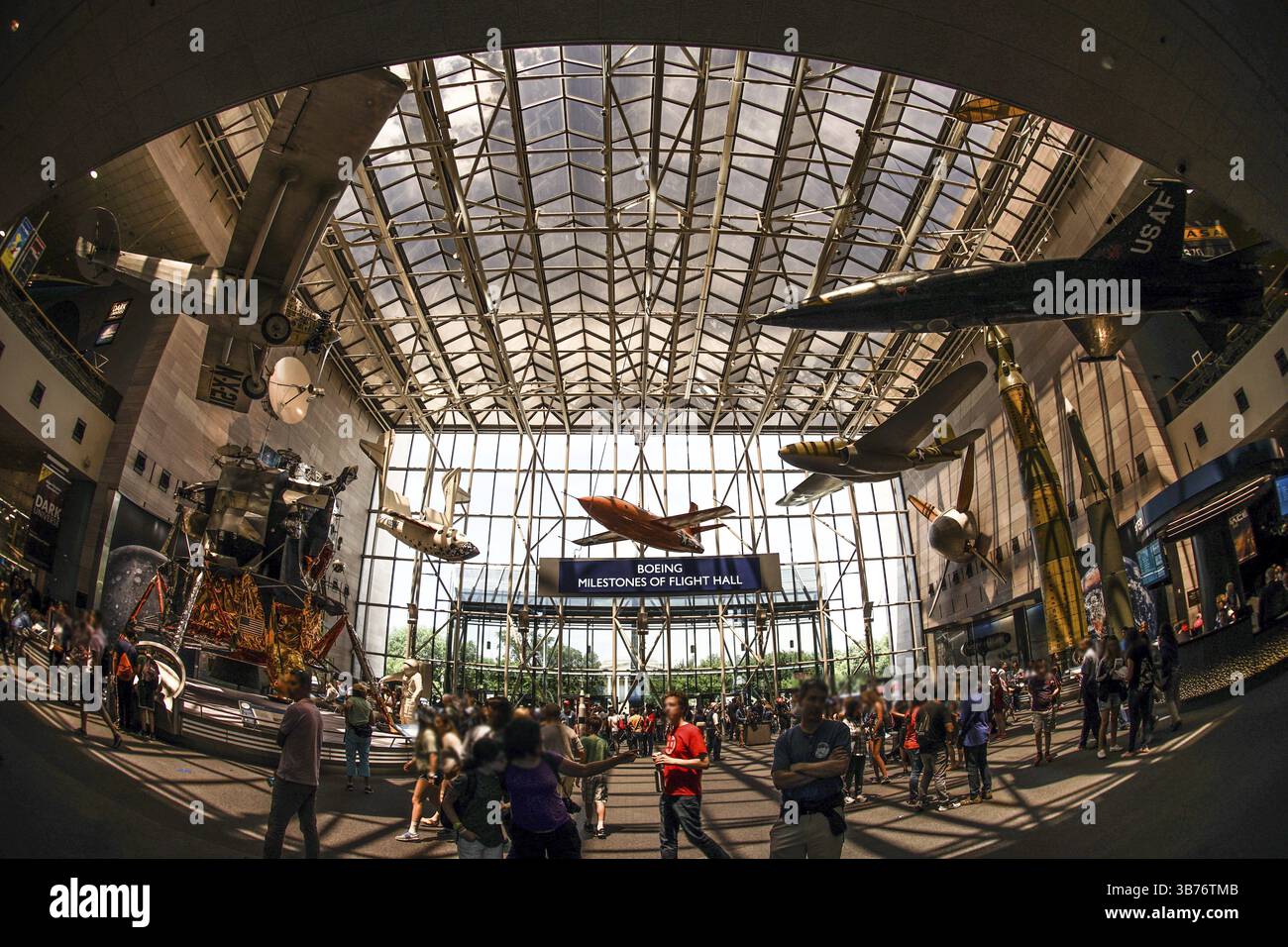 Aerospace industry image. Shooting Location: Washington, DC Stock Photohttps://www.alamy.com/image-license-details/?v=1https://www.alamy.com/aerospace-industry-image-shooting-location-washington-dc-image675658043.html
Aerospace industry image. Shooting Location: Washington, DC Stock Photohttps://www.alamy.com/image-license-details/?v=1https://www.alamy.com/aerospace-industry-image-shooting-location-washington-dc-image675658043.htmlRF3B76TMB–Aerospace industry image. Shooting Location: Washington, DC
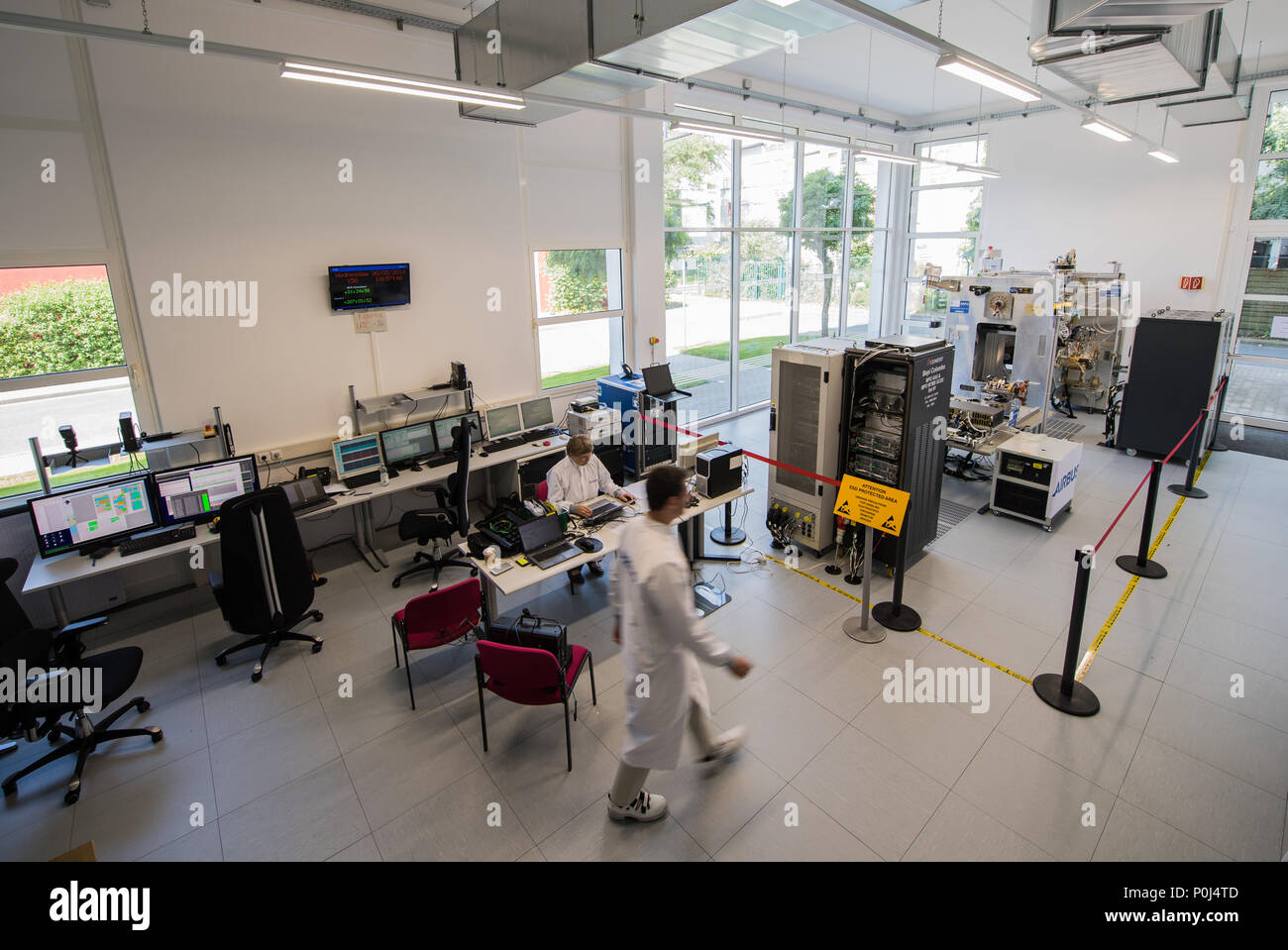 30 May 2018, Germany, Darmstadt: Karel Kotarowski, Airbus engineer, walking into the space probe's closed-off assembly area. 'BepiColombo' is a space probe and its flight to Mercury is planned for October 2018. The mission is a cooperation between ESA and the Japanese space administration JAXA. The probe is to reach the orbit of Mercury in 2025. Photo: Andreas Arnold/dpa Stock Photohttps://www.alamy.com/image-license-details/?v=1https://www.alamy.com/30-may-2018-germany-darmstadt-karel-kotarowski-airbus-engineer-walking-into-the-space-probes-closed-off-assembly-area-bepicolombo-is-a-space-probe-and-its-flight-to-mercury-is-planned-for-october-2018-the-mission-is-a-cooperation-between-esa-and-the-japanese-space-administration-jaxa-the-probe-is-to-reach-the-orbit-of-mercury-in-2025-photo-andreas-arnolddpa-image206923373.html
30 May 2018, Germany, Darmstadt: Karel Kotarowski, Airbus engineer, walking into the space probe's closed-off assembly area. 'BepiColombo' is a space probe and its flight to Mercury is planned for October 2018. The mission is a cooperation between ESA and the Japanese space administration JAXA. The probe is to reach the orbit of Mercury in 2025. Photo: Andreas Arnold/dpa Stock Photohttps://www.alamy.com/image-license-details/?v=1https://www.alamy.com/30-may-2018-germany-darmstadt-karel-kotarowski-airbus-engineer-walking-into-the-space-probes-closed-off-assembly-area-bepicolombo-is-a-space-probe-and-its-flight-to-mercury-is-planned-for-october-2018-the-mission-is-a-cooperation-between-esa-and-the-japanese-space-administration-jaxa-the-probe-is-to-reach-the-orbit-of-mercury-in-2025-photo-andreas-arnolddpa-image206923373.htmlRMP0J4TD–30 May 2018, Germany, Darmstadt: Karel Kotarowski, Airbus engineer, walking into the space probe's closed-off assembly area. 'BepiColombo' is a space probe and its flight to Mercury is planned for October 2018. The mission is a cooperation between ESA and the Japanese space administration JAXA. The probe is to reach the orbit of Mercury in 2025. Photo: Andreas Arnold/dpa
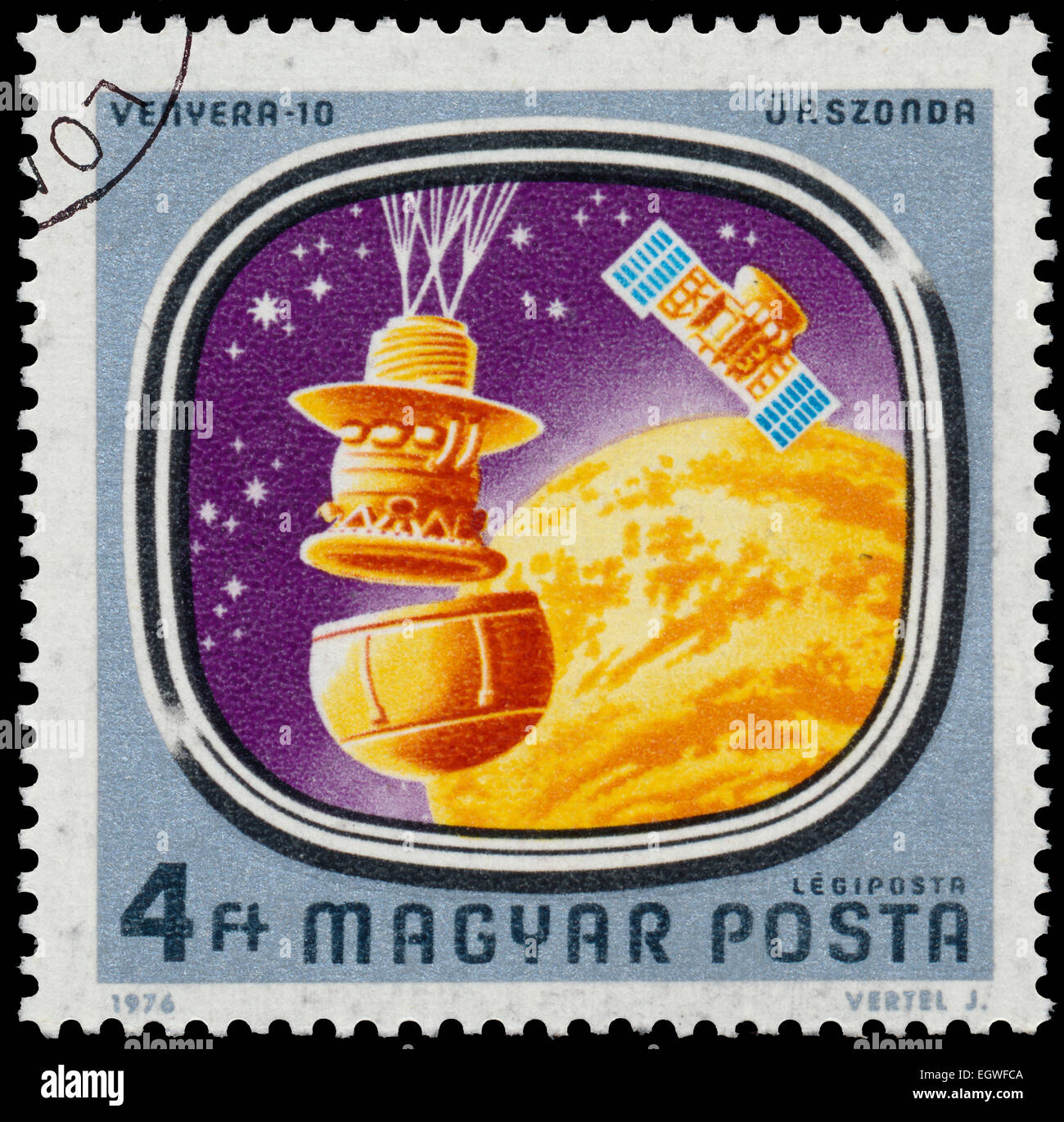 HUNGARY - CIRCA 1976: Stamp printed in Hungary shows Venera, with the same inscription, from the series 'Space Probes to Mars an Stock Photohttps://www.alamy.com/image-license-details/?v=1https://www.alamy.com/stock-photo-hungary-circa-1976-stamp-printed-in-hungary-shows-venera-with-the-79236874.html
HUNGARY - CIRCA 1976: Stamp printed in Hungary shows Venera, with the same inscription, from the series 'Space Probes to Mars an Stock Photohttps://www.alamy.com/image-license-details/?v=1https://www.alamy.com/stock-photo-hungary-circa-1976-stamp-printed-in-hungary-shows-venera-with-the-79236874.htmlRFEGWFCA–HUNGARY - CIRCA 1976: Stamp printed in Hungary shows Venera, with the same inscription, from the series 'Space Probes to Mars an
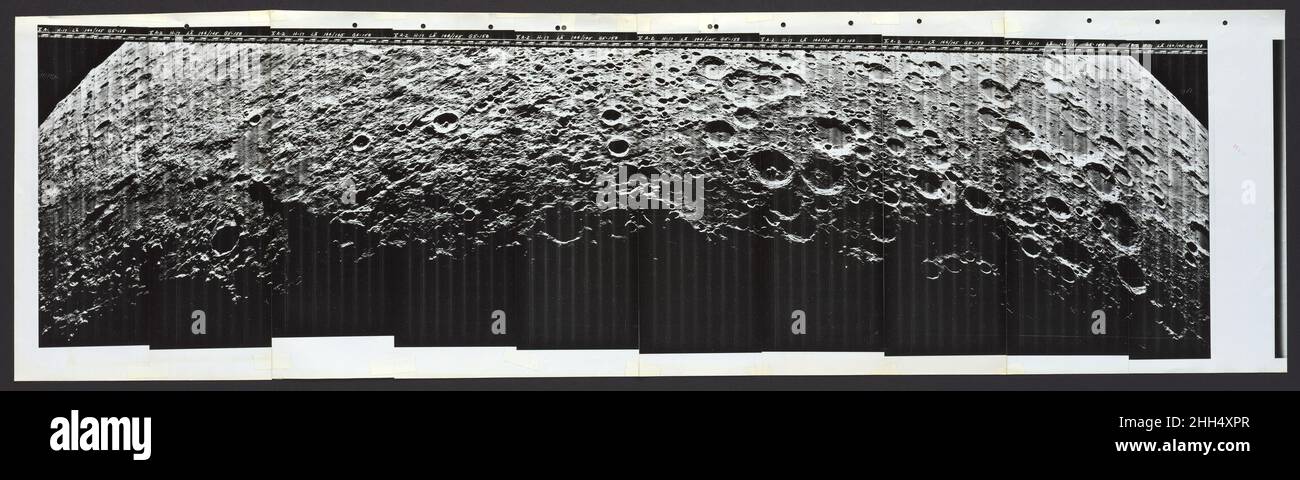 Lunar Panorama #158 1967 National Aeronautics and Space Administration (NASA) NASA's Lunar Orbiter program of 1966-67 was the agency's final and most successful photographic project before the crewed lunar landings of the Apollo program. Over the course of one year, five probes systematically photographed 99 percent of the lunar surface. The Orbiters investigated potential landing site, revealing features as small as one foot in diameter. The program used a film-based robotic imaging system designed by the Eastman Kodak Company. The images were captured on 70 mm film with a dual-lens camera, c Stock Photohttps://www.alamy.com/image-license-details/?v=1https://www.alamy.com/lunar-panorama-158-1967-national-aeronautics-and-space-administration-nasa-nasas-lunar-orbiter-program-of-1966-67-was-the-agencys-final-and-most-successful-photographic-project-before-the-crewed-lunar-landings-of-the-apollo-program-over-the-course-of-one-year-five-probes-systematically-photographed-99-percent-of-the-lunar-surface-the-orbiters-investigated-potential-landing-site-revealing-features-as-small-as-one-foot-in-diameter-the-program-used-a-film-based-robotic-imaging-system-designed-by-the-eastman-kodak-company-the-images-were-captured-on-70-mm-film-with-a-dual-lens-camera-c-image458027551.html
Lunar Panorama #158 1967 National Aeronautics and Space Administration (NASA) NASA's Lunar Orbiter program of 1966-67 was the agency's final and most successful photographic project before the crewed lunar landings of the Apollo program. Over the course of one year, five probes systematically photographed 99 percent of the lunar surface. The Orbiters investigated potential landing site, revealing features as small as one foot in diameter. The program used a film-based robotic imaging system designed by the Eastman Kodak Company. The images were captured on 70 mm film with a dual-lens camera, c Stock Photohttps://www.alamy.com/image-license-details/?v=1https://www.alamy.com/lunar-panorama-158-1967-national-aeronautics-and-space-administration-nasa-nasas-lunar-orbiter-program-of-1966-67-was-the-agencys-final-and-most-successful-photographic-project-before-the-crewed-lunar-landings-of-the-apollo-program-over-the-course-of-one-year-five-probes-systematically-photographed-99-percent-of-the-lunar-surface-the-orbiters-investigated-potential-landing-site-revealing-features-as-small-as-one-foot-in-diameter-the-program-used-a-film-based-robotic-imaging-system-designed-by-the-eastman-kodak-company-the-images-were-captured-on-70-mm-film-with-a-dual-lens-camera-c-image458027551.htmlRM2HH4XPR–Lunar Panorama #158 1967 National Aeronautics and Space Administration (NASA) NASA's Lunar Orbiter program of 1966-67 was the agency's final and most successful photographic project before the crewed lunar landings of the Apollo program. Over the course of one year, five probes systematically photographed 99 percent of the lunar surface. The Orbiters investigated potential landing site, revealing features as small as one foot in diameter. The program used a film-based robotic imaging system designed by the Eastman Kodak Company. The images were captured on 70 mm film with a dual-lens camera, c
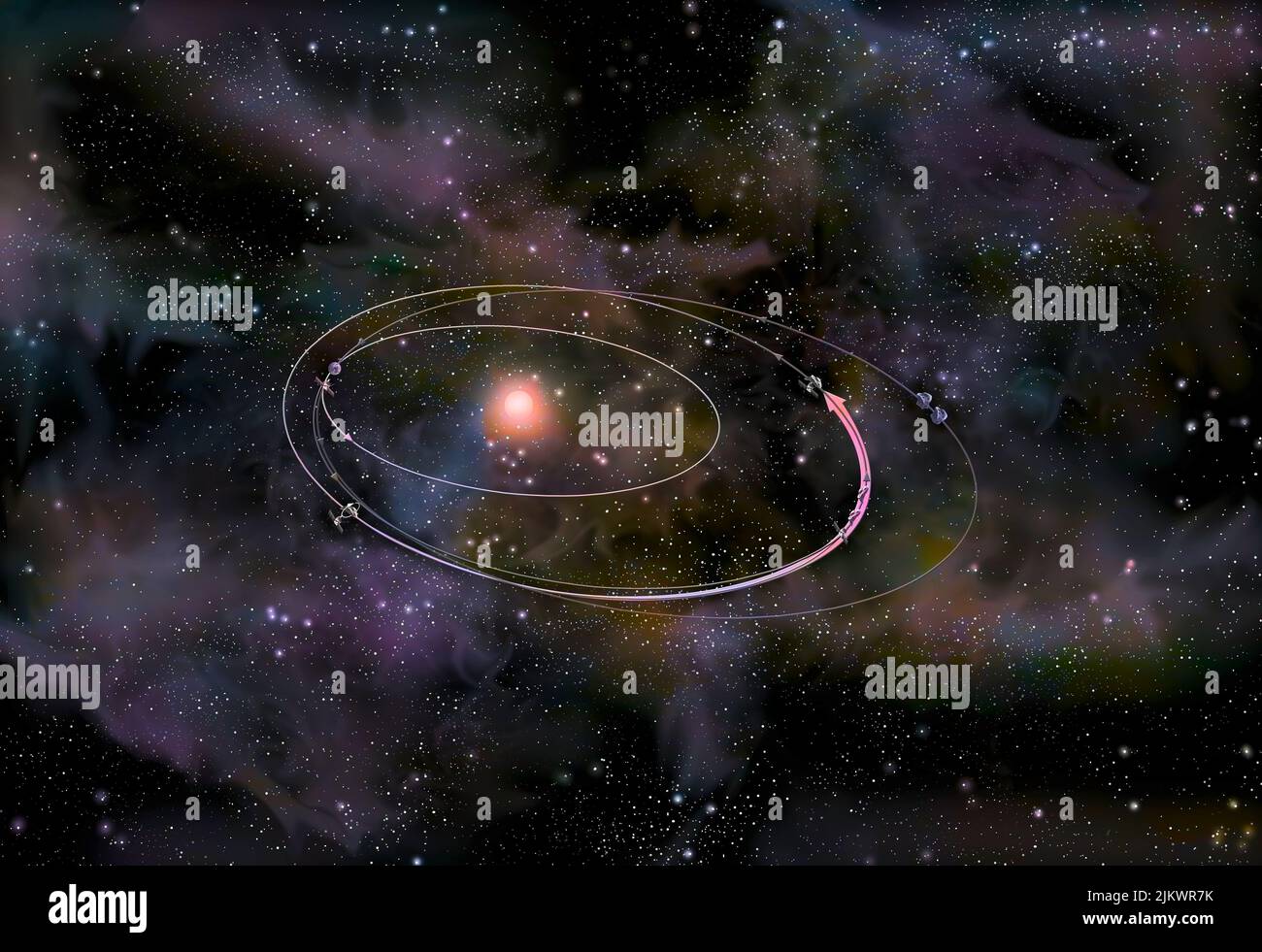 The asteroid Eros: sending the American probe Near into space for observations. Stock Photohttps://www.alamy.com/image-license-details/?v=1https://www.alamy.com/the-asteroid-eros-sending-the-american-probe-near-into-space-for-observations-image476925447.html
The asteroid Eros: sending the American probe Near into space for observations. Stock Photohttps://www.alamy.com/image-license-details/?v=1https://www.alamy.com/the-asteroid-eros-sending-the-american-probe-near-into-space-for-observations-image476925447.htmlRF2JKWR7K–The asteroid Eros: sending the American probe Near into space for observations.
RM2RKNPCH–Bildnummer: 57372781 Datum: 12.03.2012 Copyright: imago/Xinhua (120312) -- SHANGHAI, March 12, 2012 (Xinhua) -- Photo taken on March 12, 2012 shows the radio telescope under construction in Shanghai, east China. The 65-meter-diameter telescope, a form of directional radio antenna used in radio astronomy, will be used in tracking and collecting data from satellites and space probes including Chinese astronomical projects like Chang e lunar probe, YH-1 Mars exploration and other deep space explorations. The antenna structure of the telescope is scheduled to be finished by September 2012 and th
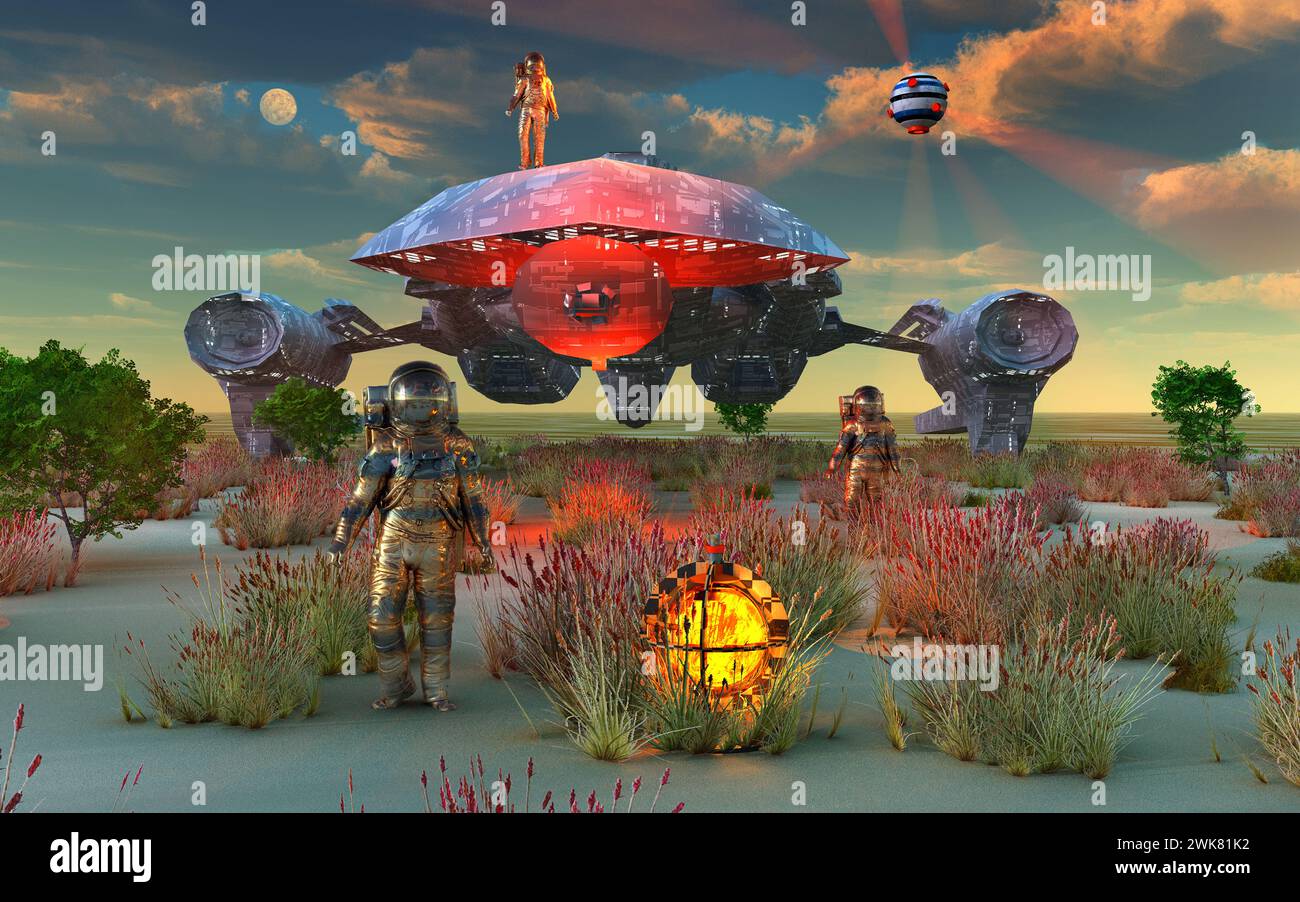 Heavy Space Cruiser Stock Photohttps://www.alamy.com/image-license-details/?v=1https://www.alamy.com/heavy-space-cruiser-image597007910.html
Heavy Space Cruiser Stock Photohttps://www.alamy.com/image-license-details/?v=1https://www.alamy.com/heavy-space-cruiser-image597007910.htmlRM2WK81K2–Heavy Space Cruiser
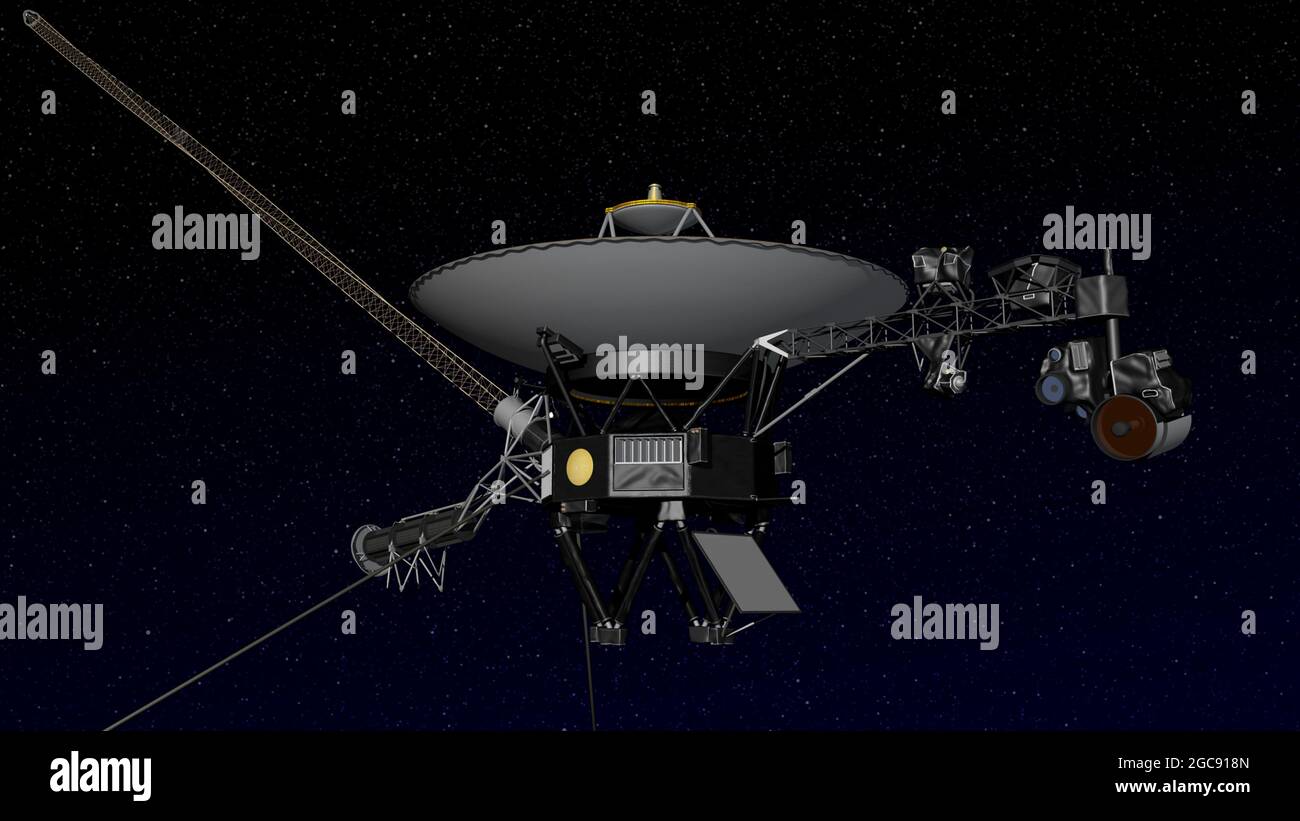 Voyager space probe shown in a computer generated graphic - Photo: Geopix/NASA Stock Photohttps://www.alamy.com/image-license-details/?v=1https://www.alamy.com/voyager-space-probe-shown-in-a-computer-generated-graphic-photo-geopixnasa-image437833669.html
Voyager space probe shown in a computer generated graphic - Photo: Geopix/NASA Stock Photohttps://www.alamy.com/image-license-details/?v=1https://www.alamy.com/voyager-space-probe-shown-in-a-computer-generated-graphic-photo-geopixnasa-image437833669.htmlRM2GC918N–Voyager space probe shown in a computer generated graphic - Photo: Geopix/NASA
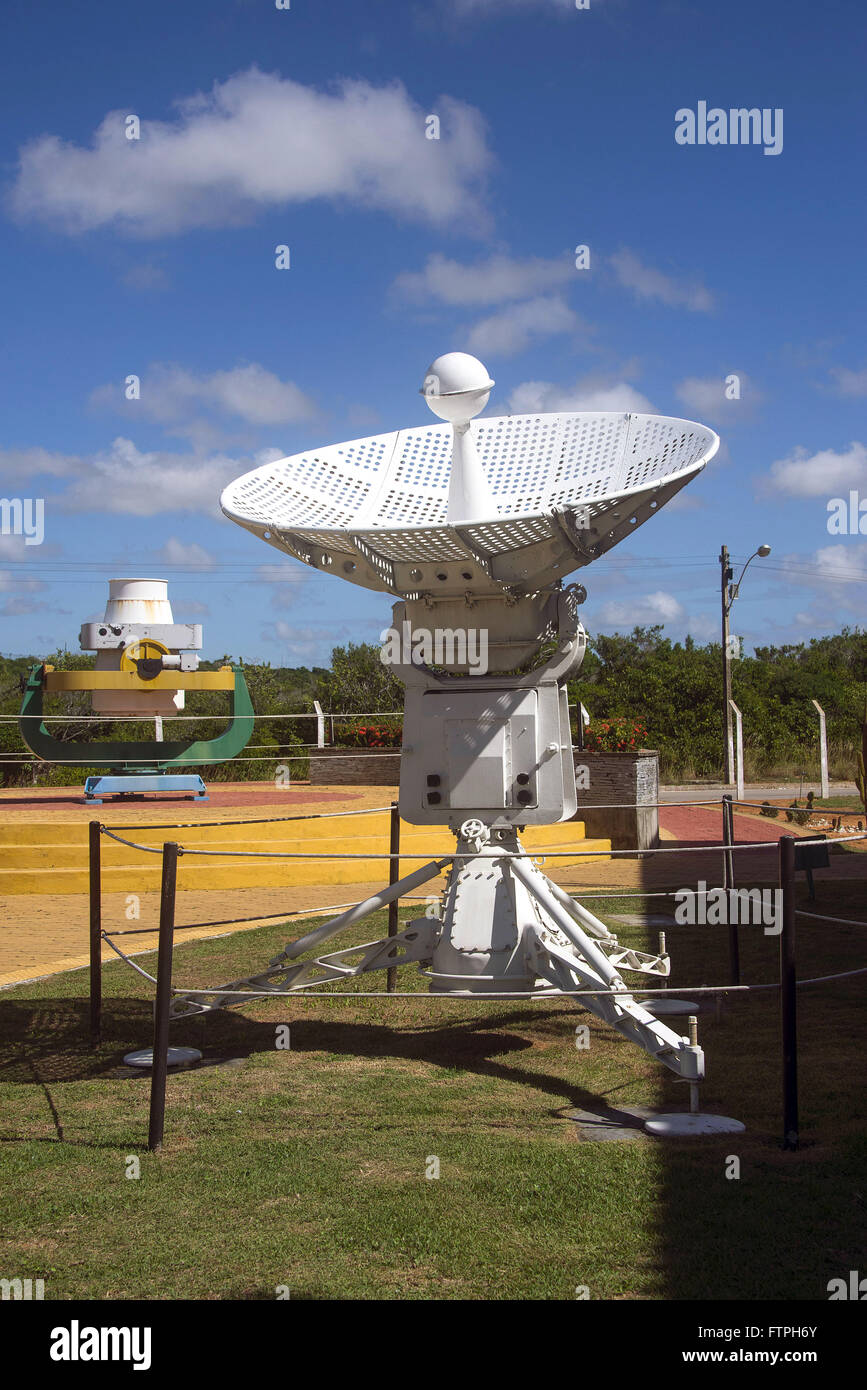 Forecast Station used to track probes Stock Photohttps://www.alamy.com/image-license-details/?v=1https://www.alamy.com/stock-photo-forecast-station-used-to-track-probes-101300051.html
Forecast Station used to track probes Stock Photohttps://www.alamy.com/image-license-details/?v=1https://www.alamy.com/stock-photo-forecast-station-used-to-track-probes-101300051.htmlRMFTPH6Y–Forecast Station used to track probes
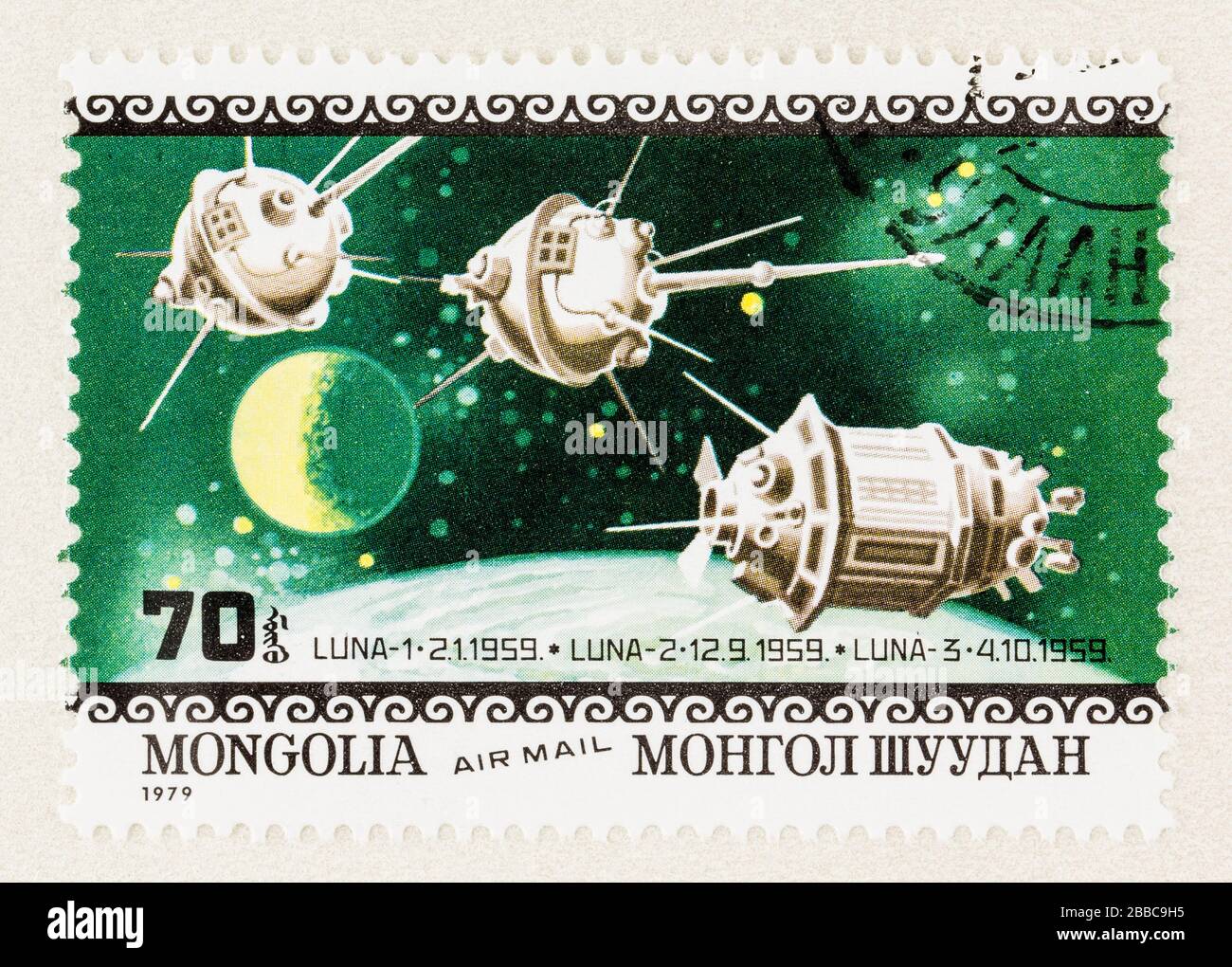 SEATTLE WASHINGTON - March 29, 2020: Close up of postage stamp from Mongolia commemorating the launch of lunar space probes Luna 1, 2 and 3 in 1959. Stock Photohttps://www.alamy.com/image-license-details/?v=1https://www.alamy.com/seattle-washington-march-29-2020-close-up-of-postage-stamp-from-mongolia-commemorating-the-launch-of-lunar-space-probes-luna-1-2-and-3-in-1959-image351239537.html
SEATTLE WASHINGTON - March 29, 2020: Close up of postage stamp from Mongolia commemorating the launch of lunar space probes Luna 1, 2 and 3 in 1959. Stock Photohttps://www.alamy.com/image-license-details/?v=1https://www.alamy.com/seattle-washington-march-29-2020-close-up-of-postage-stamp-from-mongolia-commemorating-the-launch-of-lunar-space-probes-luna-1-2-and-3-in-1959-image351239537.htmlRF2BBC9H5–SEATTLE WASHINGTON - March 29, 2020: Close up of postage stamp from Mongolia commemorating the launch of lunar space probes Luna 1, 2 and 3 in 1959.
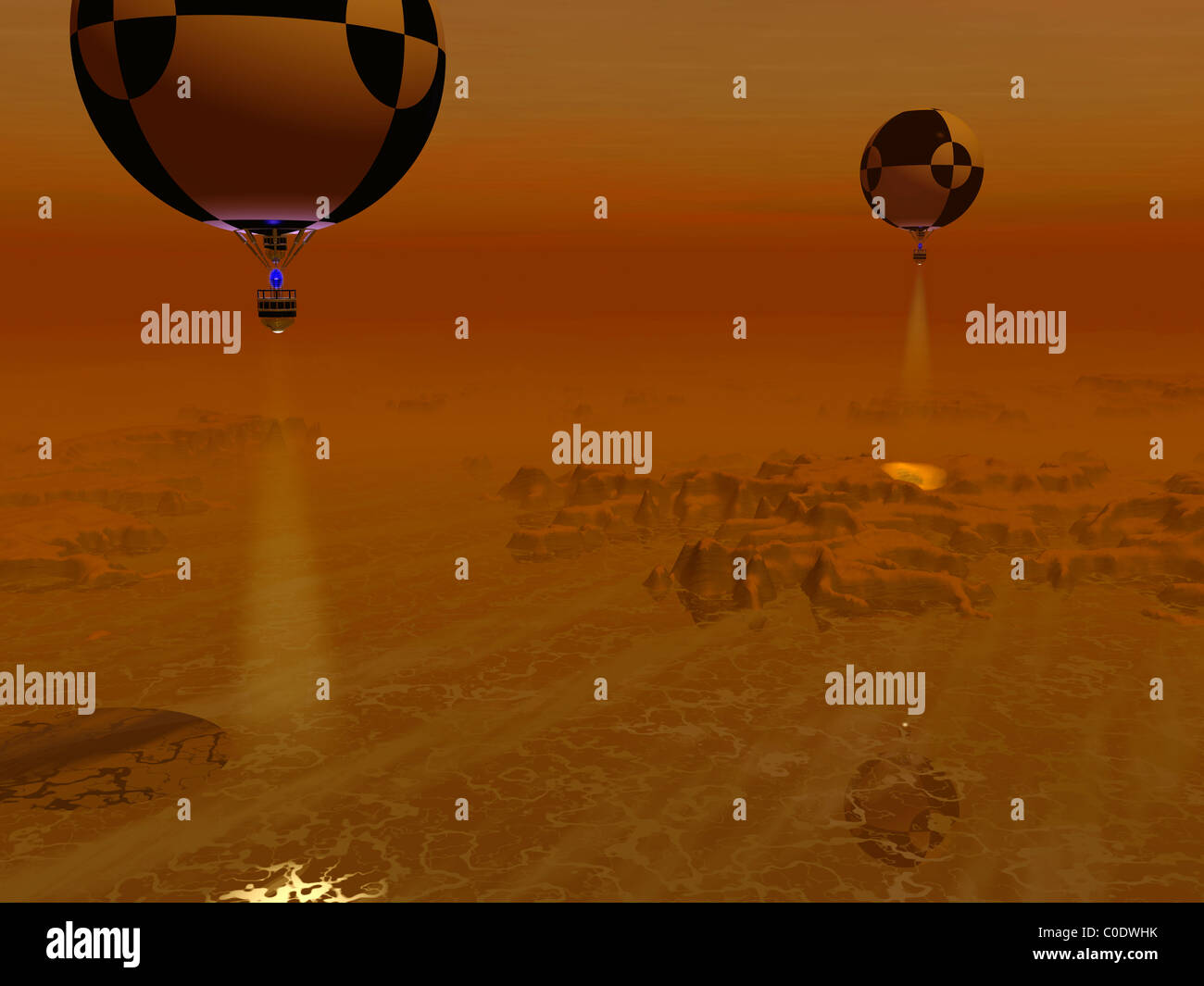 A pair of balloon-borne probes leisurely survey the surface of Titan. Stock Photohttps://www.alamy.com/image-license-details/?v=1https://www.alamy.com/stock-photo-a-pair-of-balloon-borne-probes-leisurely-survey-the-surface-of-titan-34726207.html
A pair of balloon-borne probes leisurely survey the surface of Titan. Stock Photohttps://www.alamy.com/image-license-details/?v=1https://www.alamy.com/stock-photo-a-pair-of-balloon-borne-probes-leisurely-survey-the-surface-of-titan-34726207.htmlRFC0DWHK–A pair of balloon-borne probes leisurely survey the surface of Titan.
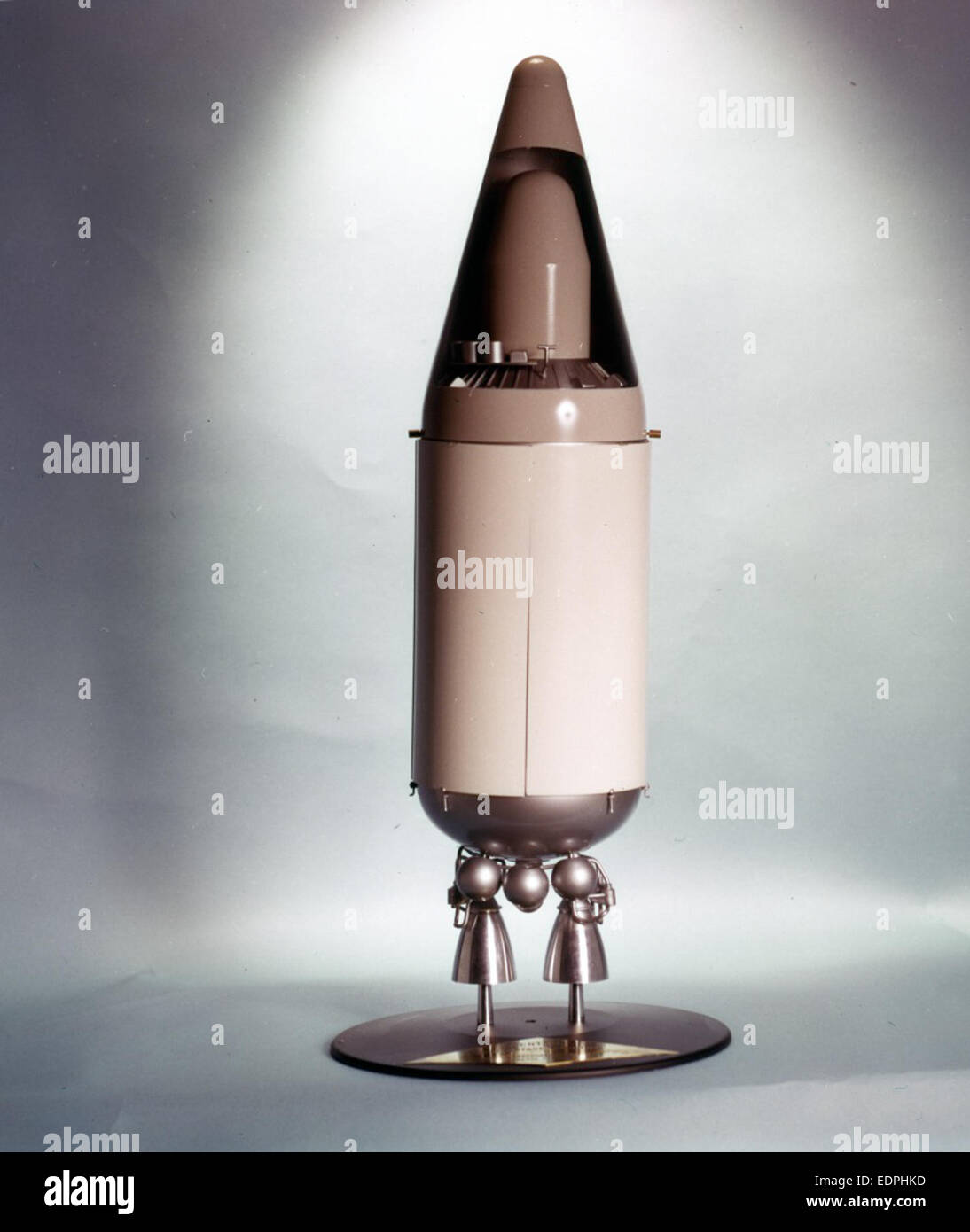 This image features the Centaur upper stage, designated as 14 001358 3, used in a variety of space missions. The Centaur has been a key component in launching satellites and space probes, known for its reliable and efficient propulsion capabilities. Stock Photohttps://www.alamy.com/image-license-details/?v=1https://www.alamy.com/stock-photo-this-image-features-the-centaur-upper-stage-designated-as-14-001358-77328817.html
This image features the Centaur upper stage, designated as 14 001358 3, used in a variety of space missions. The Centaur has been a key component in launching satellites and space probes, known for its reliable and efficient propulsion capabilities. Stock Photohttps://www.alamy.com/image-license-details/?v=1https://www.alamy.com/stock-photo-this-image-features-the-centaur-upper-stage-designated-as-14-001358-77328817.htmlRMEDPHKD–This image features the Centaur upper stage, designated as 14 001358 3, used in a variety of space missions. The Centaur has been a key component in launching satellites and space probes, known for its reliable and efficient propulsion capabilities.
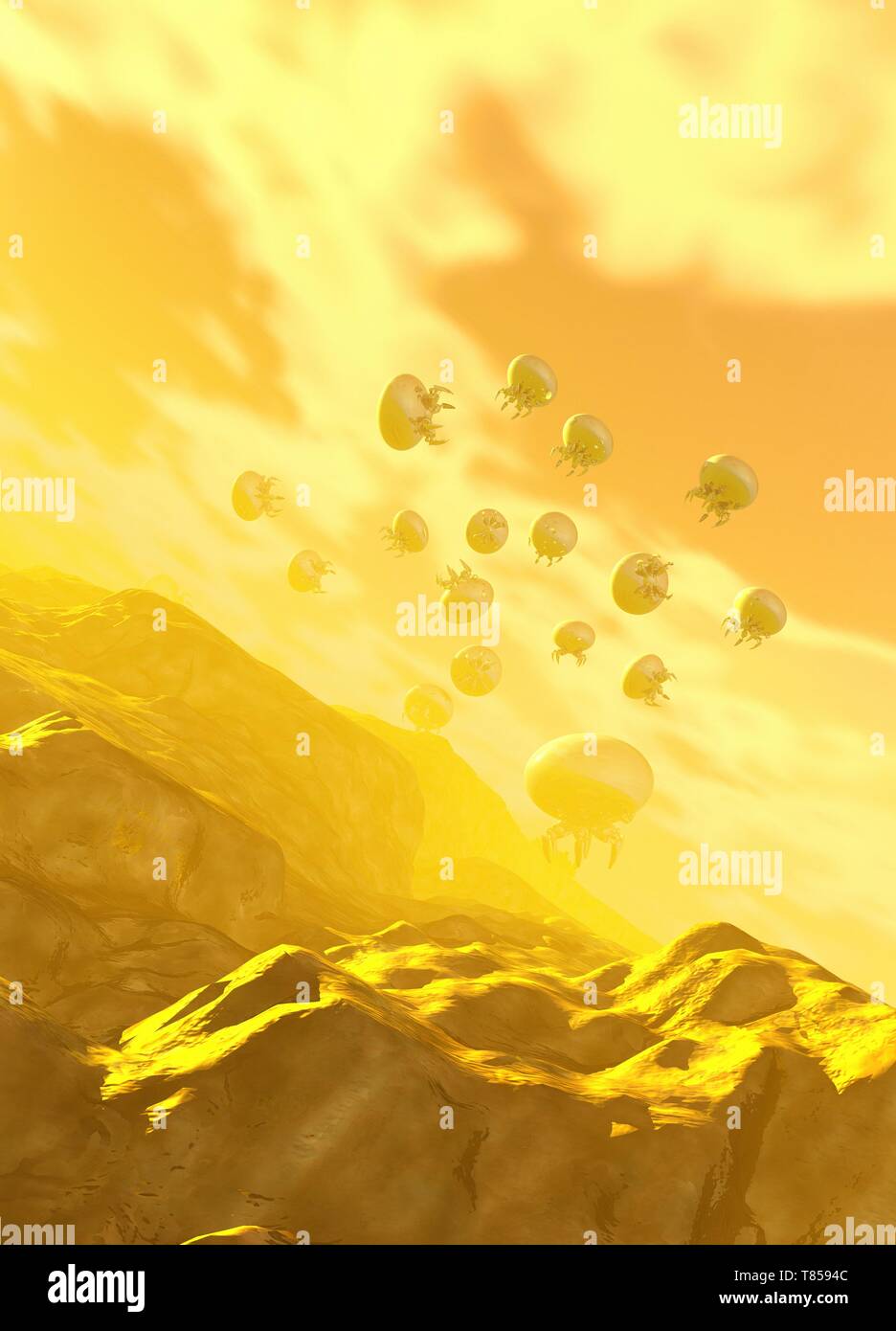 Probes over Venus, illustration Stock Photohttps://www.alamy.com/image-license-details/?v=1https://www.alamy.com/probes-over-venus-illustration-image245979340.html
Probes over Venus, illustration Stock Photohttps://www.alamy.com/image-license-details/?v=1https://www.alamy.com/probes-over-venus-illustration-image245979340.htmlRFT8594C–Probes over Venus, illustration
 Spaceships traveling into deep space, exploring galaxies and Universe. Space probes passing through stars and nebulae towards another planet. Stock Photohttps://www.alamy.com/image-license-details/?v=1https://www.alamy.com/spaceships-traveling-into-deep-space-exploring-galaxies-and-universe-space-probes-passing-through-stars-and-nebulae-towards-another-planet-image443958130.html
Spaceships traveling into deep space, exploring galaxies and Universe. Space probes passing through stars and nebulae towards another planet. Stock Photohttps://www.alamy.com/image-license-details/?v=1https://www.alamy.com/spaceships-traveling-into-deep-space-exploring-galaxies-and-universe-space-probes-passing-through-stars-and-nebulae-towards-another-planet-image443958130.htmlRF2GP813E–Spaceships traveling into deep space, exploring galaxies and Universe. Space probes passing through stars and nebulae towards another planet.
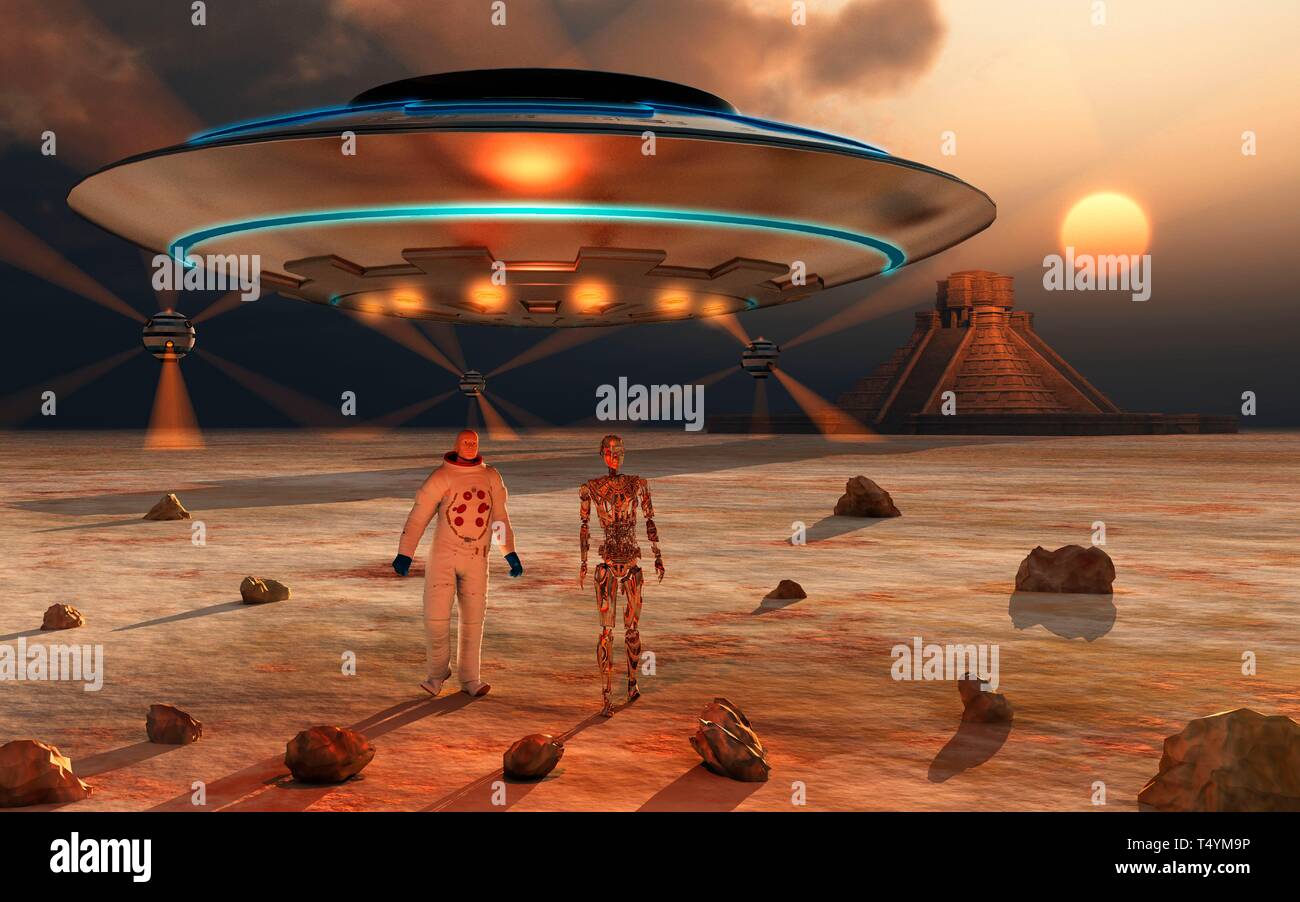 Advanced Humanity Travelling Through Time & Space Stock Photohttps://www.alamy.com/image-license-details/?v=1https://www.alamy.com/advanced-humanity-travelling-through-time-space-image244012434.html
Advanced Humanity Travelling Through Time & Space Stock Photohttps://www.alamy.com/image-license-details/?v=1https://www.alamy.com/advanced-humanity-travelling-through-time-space-image244012434.htmlRFT4YM9P–Advanced Humanity Travelling Through Time & Space
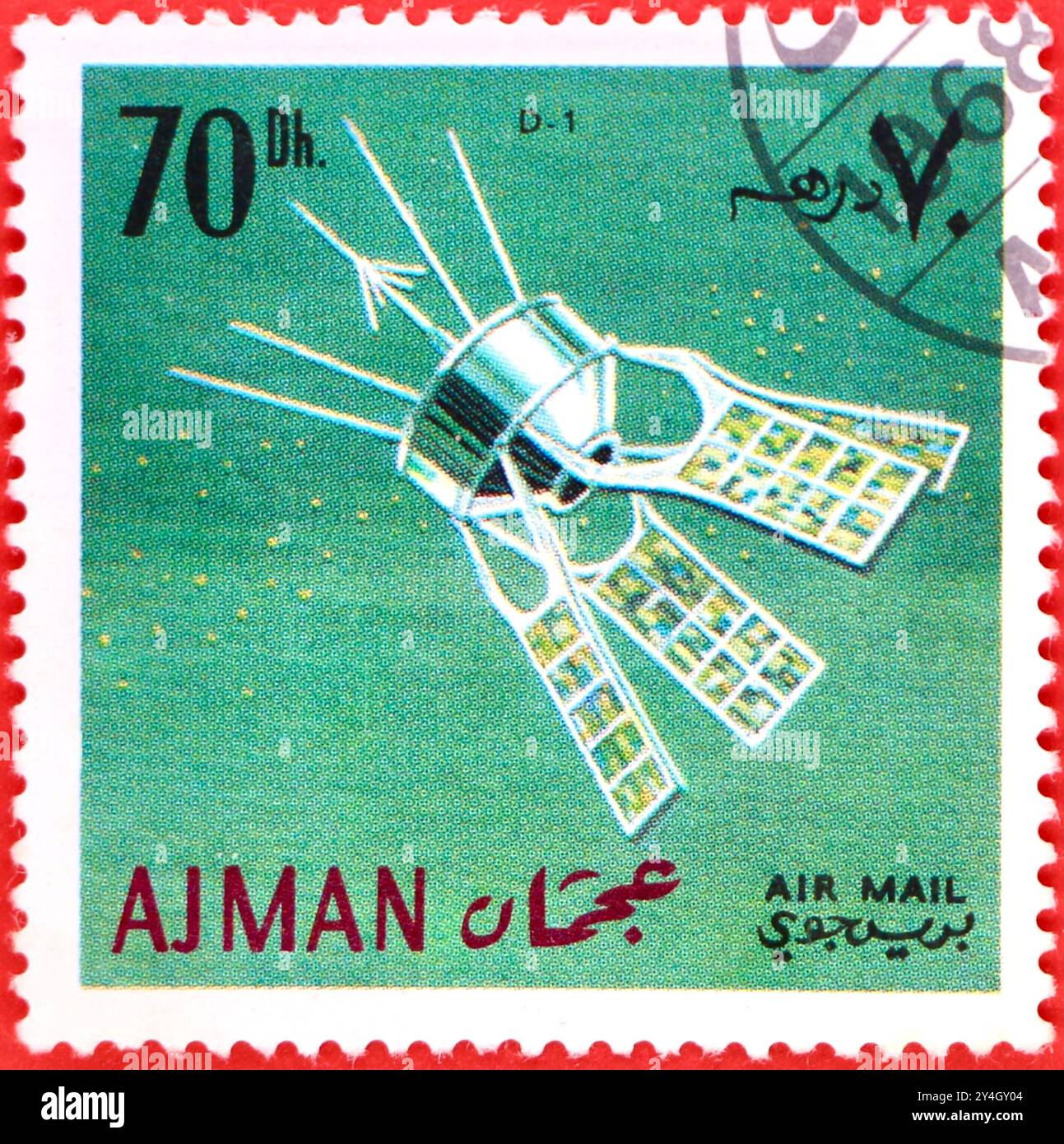 Photo of a 1968 postage stamp from the Emirate of Ajman with an image of the French D 1 geodetic satellite Stock Photohttps://www.alamy.com/image-license-details/?v=1https://www.alamy.com/photo-of-a-1968-postage-stamp-from-the-emirate-of-ajman-with-an-image-of-the-french-d-1-geodetic-satellite-image622404276.html
Photo of a 1968 postage stamp from the Emirate of Ajman with an image of the French D 1 geodetic satellite Stock Photohttps://www.alamy.com/image-license-details/?v=1https://www.alamy.com/photo-of-a-1968-postage-stamp-from-the-emirate-of-ajman-with-an-image-of-the-french-d-1-geodetic-satellite-image622404276.htmlRM2Y4GY04–Photo of a 1968 postage stamp from the Emirate of Ajman with an image of the French D 1 geodetic satellite
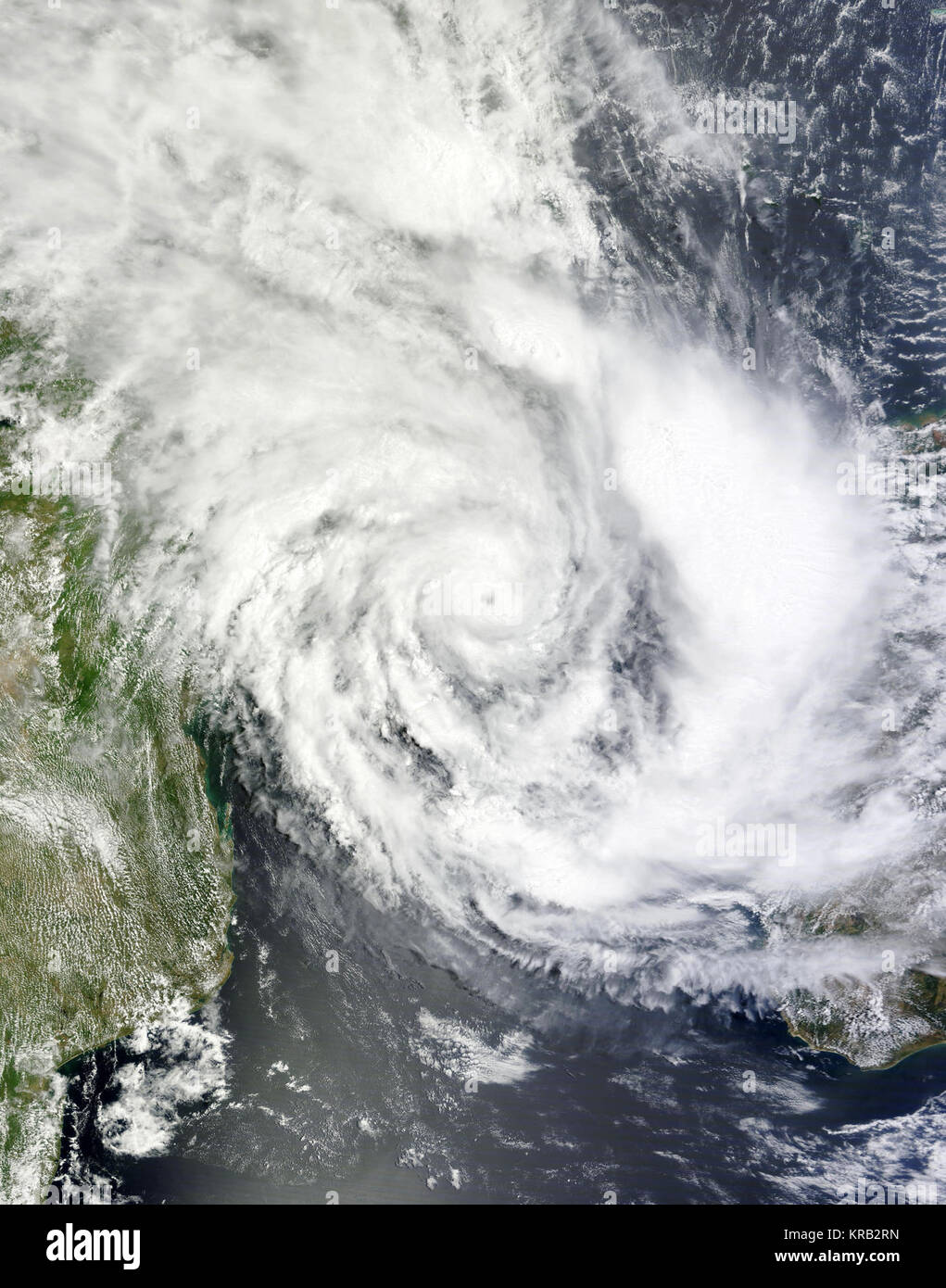 Funso Jan 23 2012 0750Z Stock Photohttps://www.alamy.com/image-license-details/?v=1https://www.alamy.com/stock-image-funso-jan-23-2012-0750z-169274105.html
Funso Jan 23 2012 0750Z Stock Photohttps://www.alamy.com/image-license-details/?v=1https://www.alamy.com/stock-image-funso-jan-23-2012-0750z-169274105.htmlRMKRB2RN–Funso Jan 23 2012 0750Z
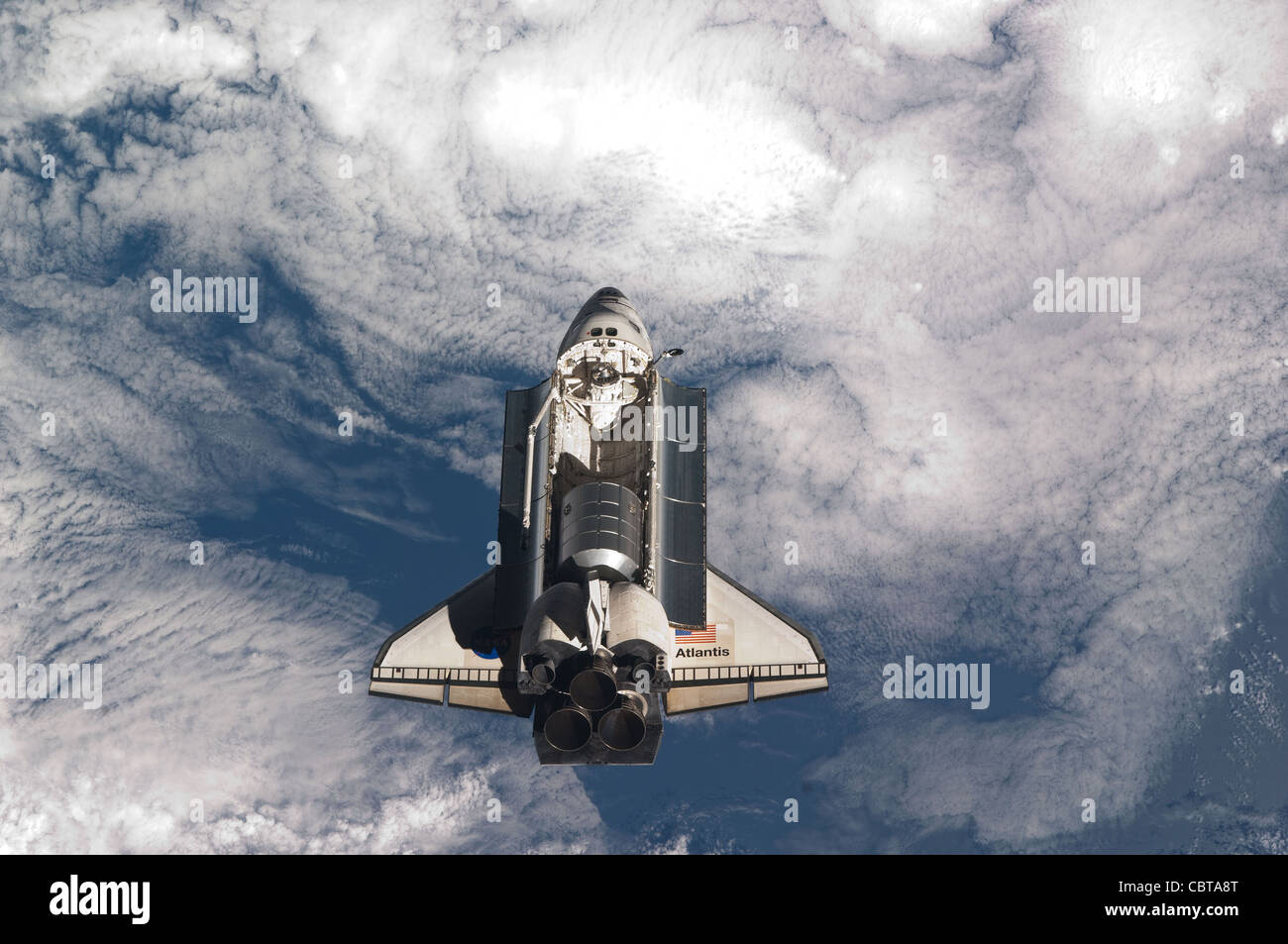 Space Shuttle Atlantis July 2011 Stock Photohttps://www.alamy.com/image-license-details/?v=1https://www.alamy.com/stock-photo-space-shuttle-atlantis-july-2011-41716888.html
Space Shuttle Atlantis July 2011 Stock Photohttps://www.alamy.com/image-license-details/?v=1https://www.alamy.com/stock-photo-space-shuttle-atlantis-july-2011-41716888.htmlRFCBTA8T–Space Shuttle Atlantis July 2011
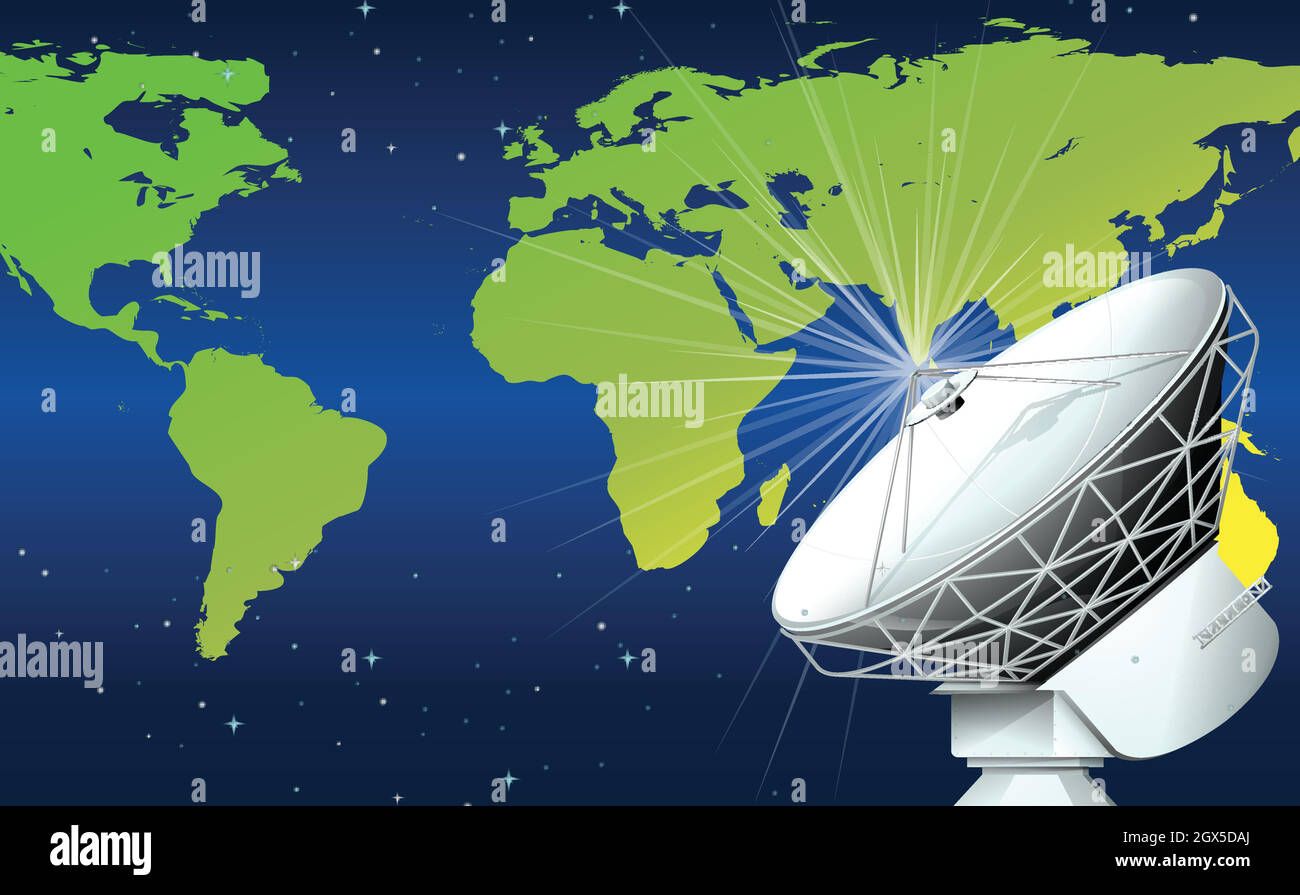 A satellite in the space Stock Vectorhttps://www.alamy.com/image-license-details/?v=1https://www.alamy.com/a-satellite-in-the-space-image446360506.html
A satellite in the space Stock Vectorhttps://www.alamy.com/image-license-details/?v=1https://www.alamy.com/a-satellite-in-the-space-image446360506.htmlRF2GX5DAJ–A satellite in the space
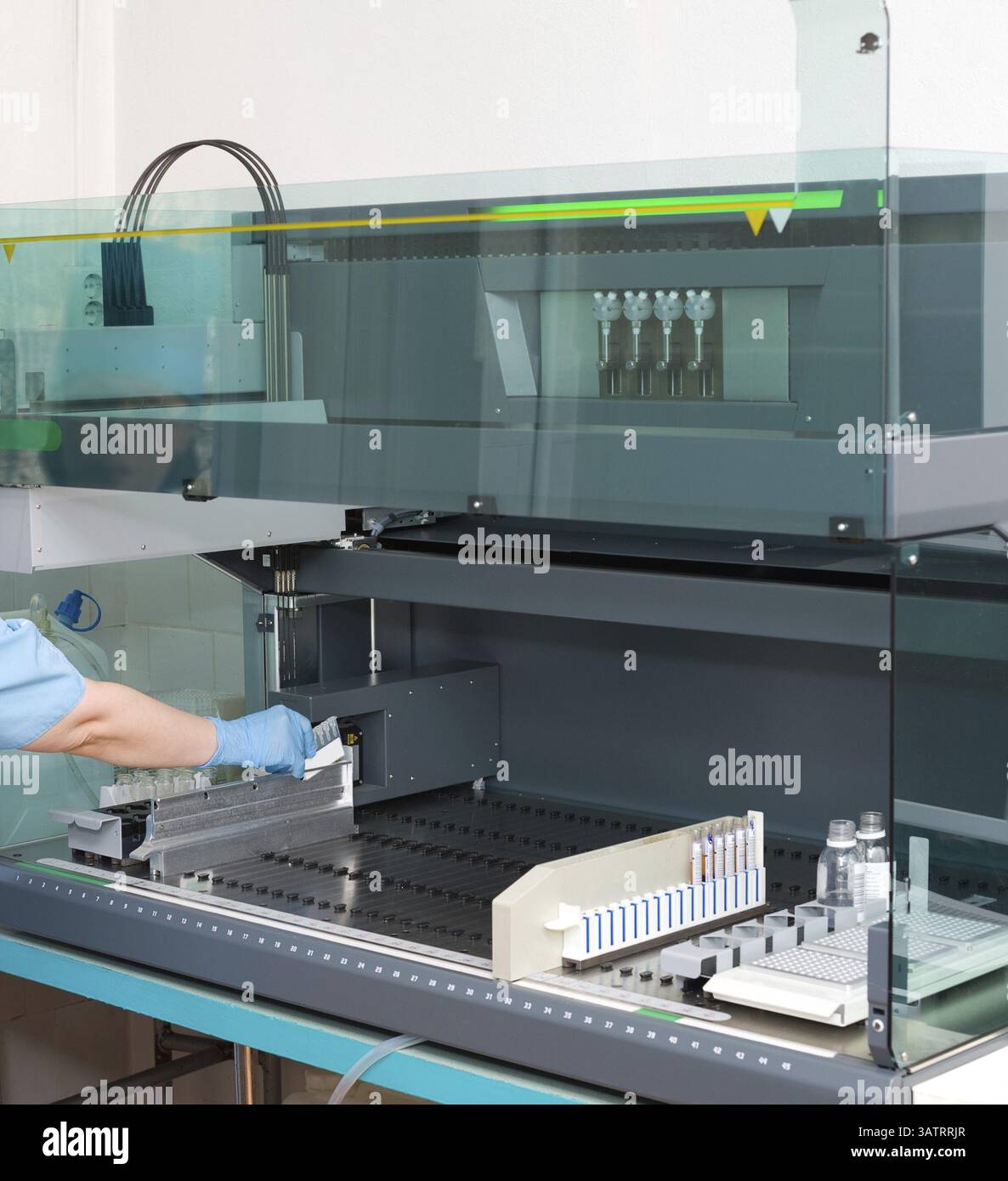 A nurse makes analysis at a laboratory Stock Photohttps://www.alamy.com/image-license-details/?v=1https://www.alamy.com/a-nurse-makes-analysis-at-a-laboratory-image669269183.html
A nurse makes analysis at a laboratory Stock Photohttps://www.alamy.com/image-license-details/?v=1https://www.alamy.com/a-nurse-makes-analysis-at-a-laboratory-image669269183.htmlRF3ATRRJR–A nurse makes analysis at a laboratory
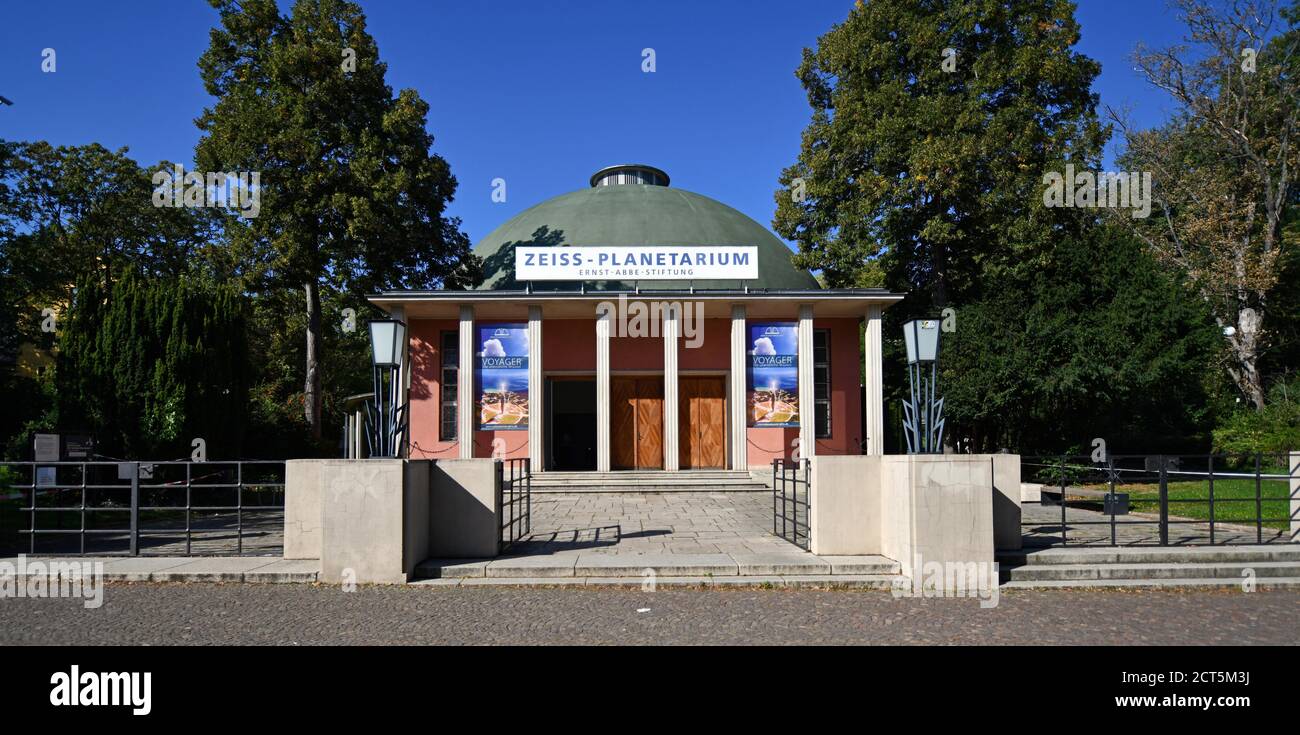 Jena, Germany. 21st Sep, 2020. The gate is open at the Zeiss Planetarium Jena. From 23 September, the new programme 'Voyager - The Infinite Mission' will offer visitors images of the outermost planets of the solar system and their moons taken by the US space probes Voyager 1 and 2. The planetarium had to close for almost three months in spring because of the Corona pandemic. It has only been receiving visitors again since 9 June. Credit: Martin Schutt/dpa-Zentralbild/dpa/Alamy Live News Stock Photohttps://www.alamy.com/image-license-details/?v=1https://www.alamy.com/jena-germany-21st-sep-2020-the-gate-is-open-at-the-zeiss-planetarium-jena-from-23-september-the-new-programme-voyager-the-infinite-mission-will-offer-visitors-images-of-the-outermost-planets-of-the-solar-system-and-their-moons-taken-by-the-us-space-probes-voyager-1-and-2-the-planetarium-had-to-close-for-almost-three-months-in-spring-because-of-the-corona-pandemic-it-has-only-been-receiving-visitors-again-since-9-june-credit-martin-schuttdpa-zentralbilddpaalamy-live-news-image376295014.html
Jena, Germany. 21st Sep, 2020. The gate is open at the Zeiss Planetarium Jena. From 23 September, the new programme 'Voyager - The Infinite Mission' will offer visitors images of the outermost planets of the solar system and their moons taken by the US space probes Voyager 1 and 2. The planetarium had to close for almost three months in spring because of the Corona pandemic. It has only been receiving visitors again since 9 June. Credit: Martin Schutt/dpa-Zentralbild/dpa/Alamy Live News Stock Photohttps://www.alamy.com/image-license-details/?v=1https://www.alamy.com/jena-germany-21st-sep-2020-the-gate-is-open-at-the-zeiss-planetarium-jena-from-23-september-the-new-programme-voyager-the-infinite-mission-will-offer-visitors-images-of-the-outermost-planets-of-the-solar-system-and-their-moons-taken-by-the-us-space-probes-voyager-1-and-2-the-planetarium-had-to-close-for-almost-three-months-in-spring-because-of-the-corona-pandemic-it-has-only-been-receiving-visitors-again-since-9-june-credit-martin-schuttdpa-zentralbilddpaalamy-live-news-image376295014.htmlRM2CT5M3J–Jena, Germany. 21st Sep, 2020. The gate is open at the Zeiss Planetarium Jena. From 23 September, the new programme 'Voyager - The Infinite Mission' will offer visitors images of the outermost planets of the solar system and their moons taken by the US space probes Voyager 1 and 2. The planetarium had to close for almost three months in spring because of the Corona pandemic. It has only been receiving visitors again since 9 June. Credit: Martin Schutt/dpa-Zentralbild/dpa/Alamy Live News
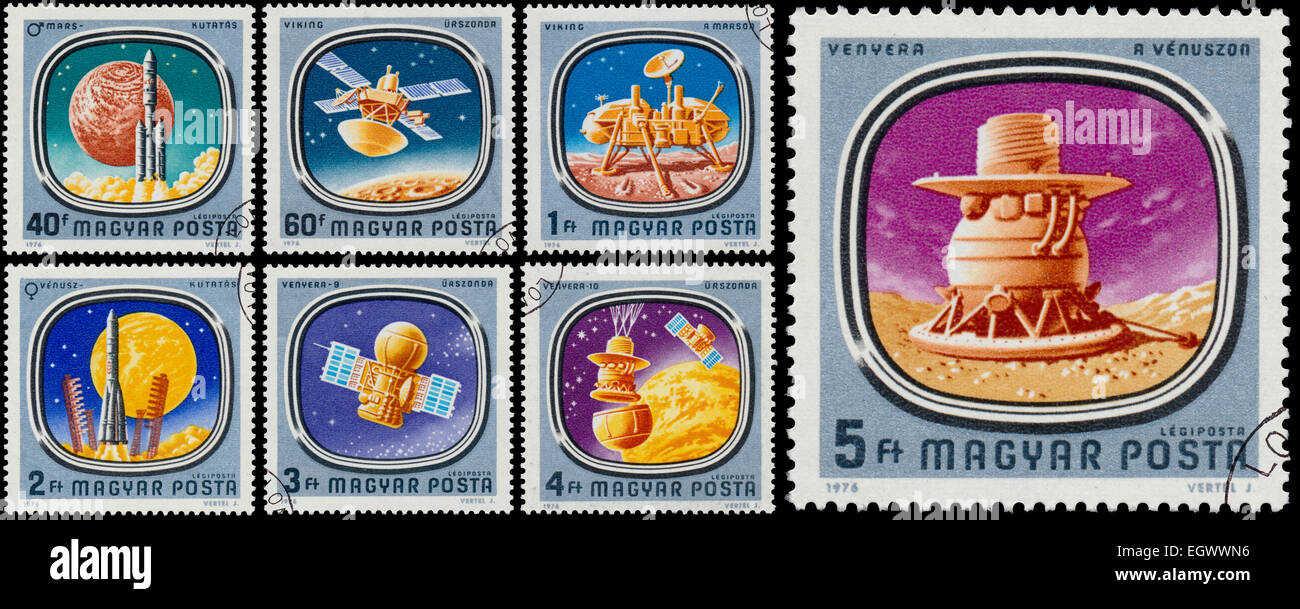 HUNGARY - CIRCA 1976: Stamps printed in Hungary shows Objects, with the same inscription, from the series 'Space Probes to Mars Stock Photohttps://www.alamy.com/image-license-details/?v=1https://www.alamy.com/stock-photo-hungary-circa-1976-stamps-printed-in-hungary-shows-objects-with-the-79244962.html
HUNGARY - CIRCA 1976: Stamps printed in Hungary shows Objects, with the same inscription, from the series 'Space Probes to Mars Stock Photohttps://www.alamy.com/image-license-details/?v=1https://www.alamy.com/stock-photo-hungary-circa-1976-stamps-printed-in-hungary-shows-objects-with-the-79244962.htmlRFEGWWN6–HUNGARY - CIRCA 1976: Stamps printed in Hungary shows Objects, with the same inscription, from the series 'Space Probes to Mars
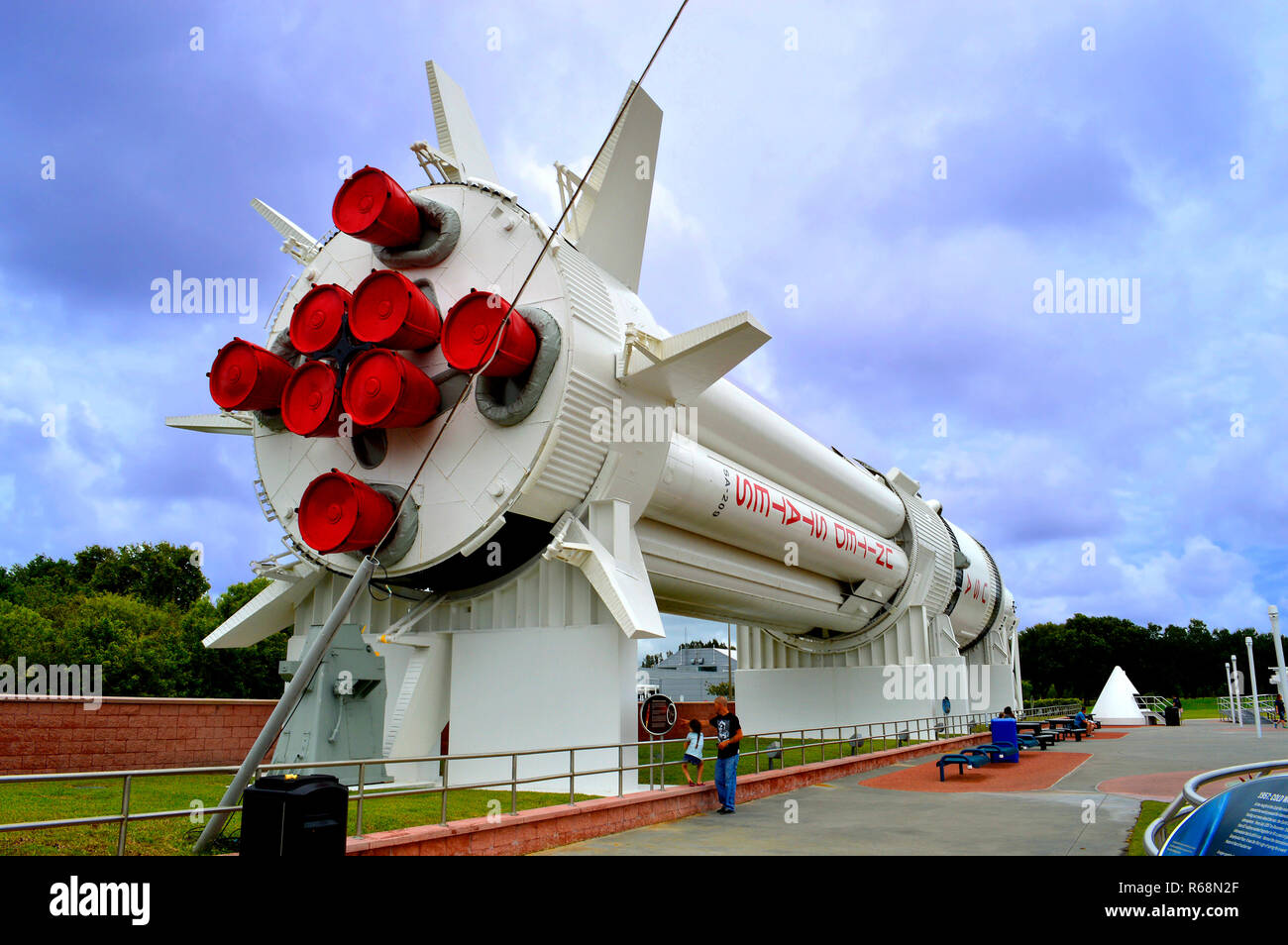 Mercury-Redstone rocket on display at Kennedy Space Centre Stock Photohttps://www.alamy.com/image-license-details/?v=1https://www.alamy.com/mercury-redstone-rocket-on-display-at-kennedy-space-centre-image227614871.html
Mercury-Redstone rocket on display at Kennedy Space Centre Stock Photohttps://www.alamy.com/image-license-details/?v=1https://www.alamy.com/mercury-redstone-rocket-on-display-at-kennedy-space-centre-image227614871.htmlRFR68N2F–Mercury-Redstone rocket on display at Kennedy Space Centre
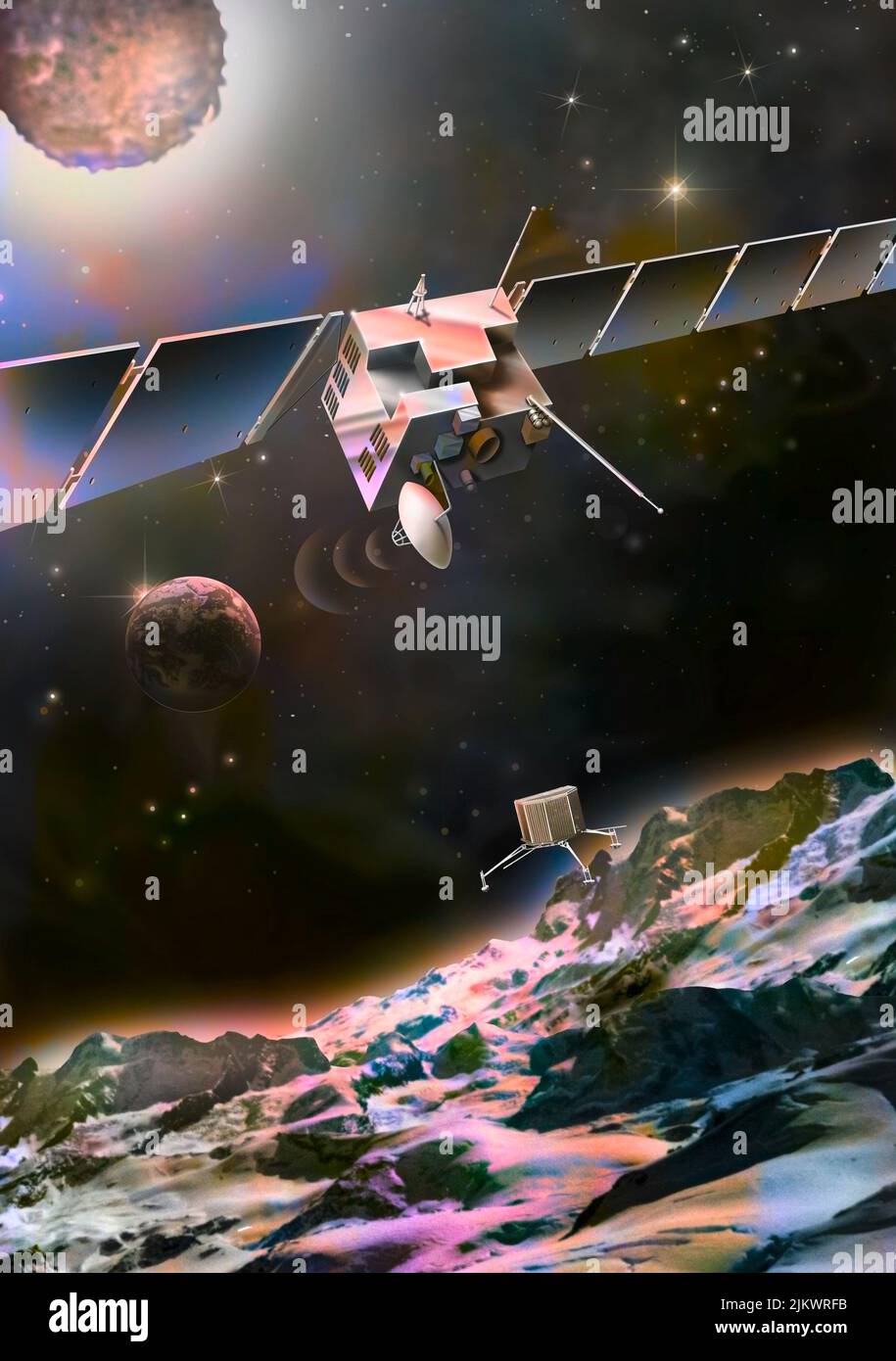 Sending the Rosetta probe to the surface of comet Wirtanen. Stock Photohttps://www.alamy.com/image-license-details/?v=1https://www.alamy.com/sending-the-rosetta-probe-to-the-surface-of-comet-wirtanen-image476925663.html
Sending the Rosetta probe to the surface of comet Wirtanen. Stock Photohttps://www.alamy.com/image-license-details/?v=1https://www.alamy.com/sending-the-rosetta-probe-to-the-surface-of-comet-wirtanen-image476925663.htmlRF2JKWRFB–Sending the Rosetta probe to the surface of comet Wirtanen.
RM2RKNPCX–Bildnummer: 57372780 Datum: 12.03.2012 Copyright: imago/Xinhua (120312) -- SHANGHAI, March 12, 2012 (Xinhua) -- Photo taken on March 12, 2012 shows the radio telescope under construction in Shanghai, east China. The 65-meter-diameter telescope, a form of directional radio antenna used in radio astronomy, will be used in tracking and collecting data from satellites and space probes including Chinese astronomical projects like Chang e lunar probe, YH-1 Mars exploration and other deep space explorations. The antenna structure of the telescope is scheduled to be finished by September 2012 and th
 Heavy Space Cruiser Stock Photohttps://www.alamy.com/image-license-details/?v=1https://www.alamy.com/heavy-space-cruiser-image596928265.html
Heavy Space Cruiser Stock Photohttps://www.alamy.com/image-license-details/?v=1https://www.alamy.com/heavy-space-cruiser-image596928265.htmlRM2WK4C2H–Heavy Space Cruiser
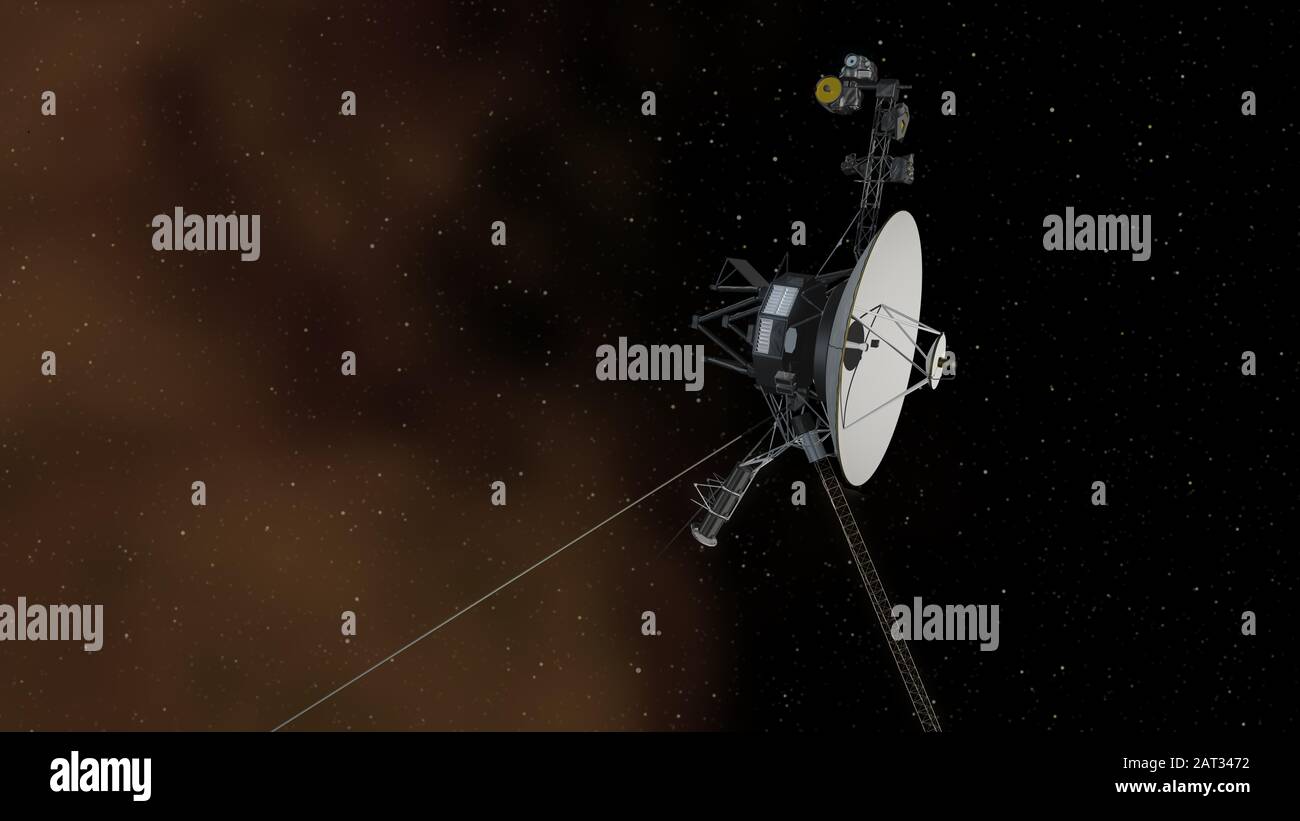 This artist's concept depicts one of NASA's Voyager spacecraft entering interstellar space, or the space between stars. Interstellar space is dominate Stock Photohttps://www.alamy.com/image-license-details/?v=1https://www.alamy.com/this-artists-concept-depicts-one-of-nasas-voyager-spacecraft-entering-interstellar-space-or-the-space-between-stars-interstellar-space-is-dominate-image341817926.html
This artist's concept depicts one of NASA's Voyager spacecraft entering interstellar space, or the space between stars. Interstellar space is dominate Stock Photohttps://www.alamy.com/image-license-details/?v=1https://www.alamy.com/this-artists-concept-depicts-one-of-nasas-voyager-spacecraft-entering-interstellar-space-or-the-space-between-stars-interstellar-space-is-dominate-image341817926.htmlRM2AT3472–This artist's concept depicts one of NASA's Voyager spacecraft entering interstellar space, or the space between stars. Interstellar space is dominate
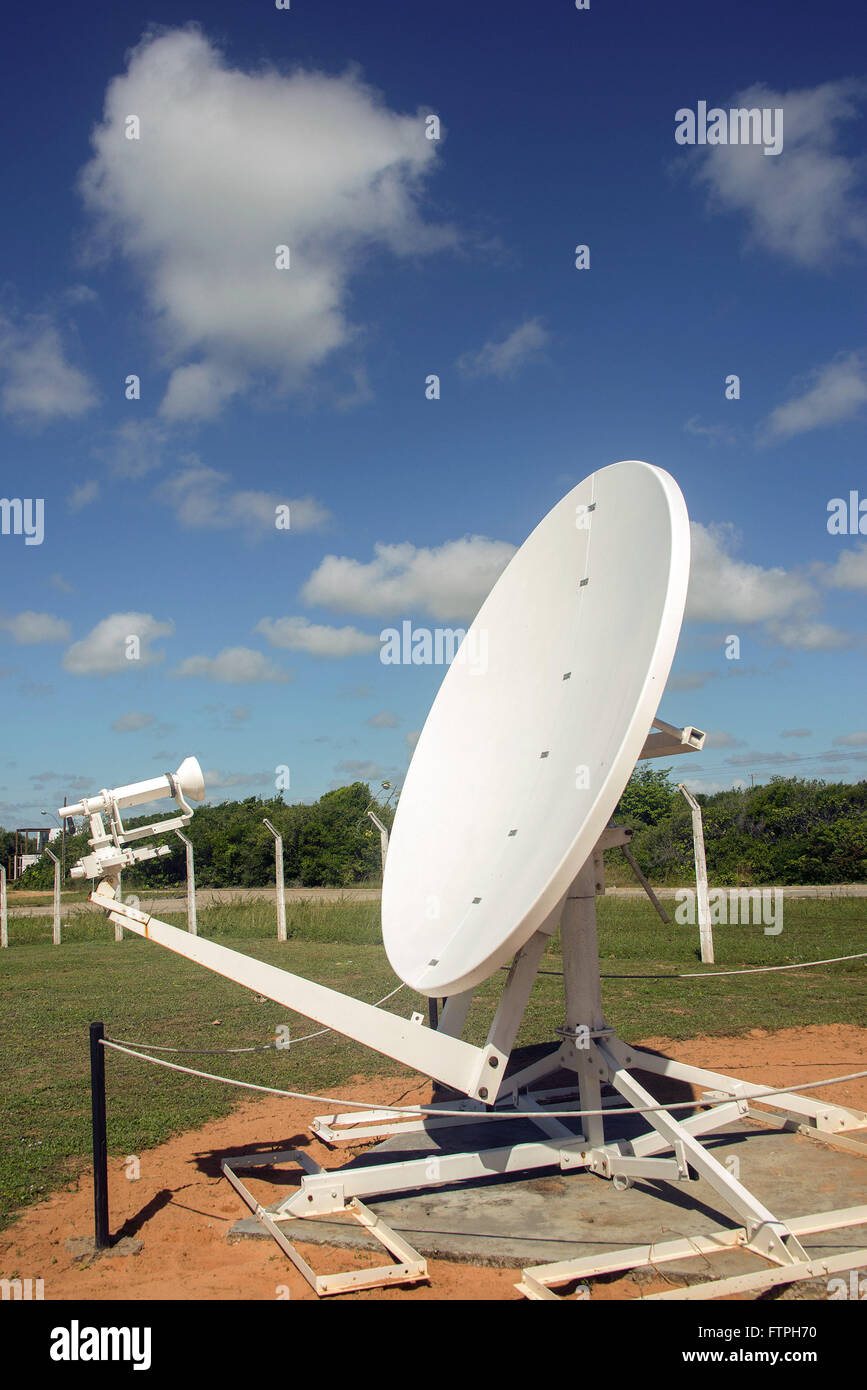 Forecast Station used to track probes Stock Photohttps://www.alamy.com/image-license-details/?v=1https://www.alamy.com/stock-photo-forecast-station-used-to-track-probes-101300052.html
Forecast Station used to track probes Stock Photohttps://www.alamy.com/image-license-details/?v=1https://www.alamy.com/stock-photo-forecast-station-used-to-track-probes-101300052.htmlRMFTPH70–Forecast Station used to track probes
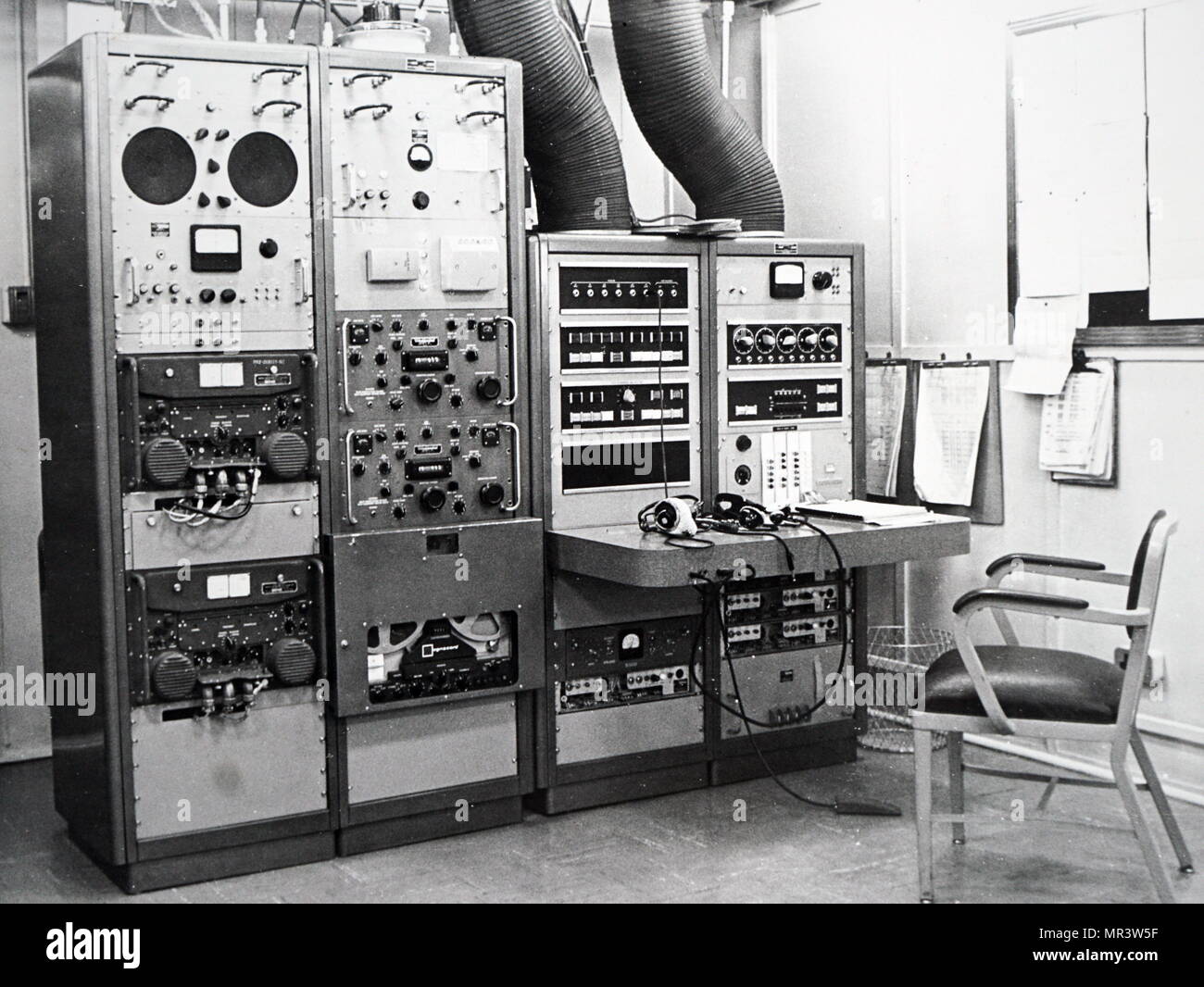 Photograph of part of radio transmitting and receiving equipment for manned space probes. This microwave station is operated by the Americans for all their Gemini flights and is just north of Kano, Nigeria. Dated 20th century Stock Photohttps://www.alamy.com/image-license-details/?v=1https://www.alamy.com/photograph-of-part-of-radio-transmitting-and-receiving-equipment-for-manned-space-probes-this-microwave-station-is-operated-by-the-americans-for-all-their-gemini-flights-and-is-just-north-of-kano-nigeria-dated-20th-century-image186326379.html
Photograph of part of radio transmitting and receiving equipment for manned space probes. This microwave station is operated by the Americans for all their Gemini flights and is just north of Kano, Nigeria. Dated 20th century Stock Photohttps://www.alamy.com/image-license-details/?v=1https://www.alamy.com/photograph-of-part-of-radio-transmitting-and-receiving-equipment-for-manned-space-probes-this-microwave-station-is-operated-by-the-americans-for-all-their-gemini-flights-and-is-just-north-of-kano-nigeria-dated-20th-century-image186326379.htmlRMMR3W5F–Photograph of part of radio transmitting and receiving equipment for manned space probes. This microwave station is operated by the Americans for all their Gemini flights and is just north of Kano, Nigeria. Dated 20th century
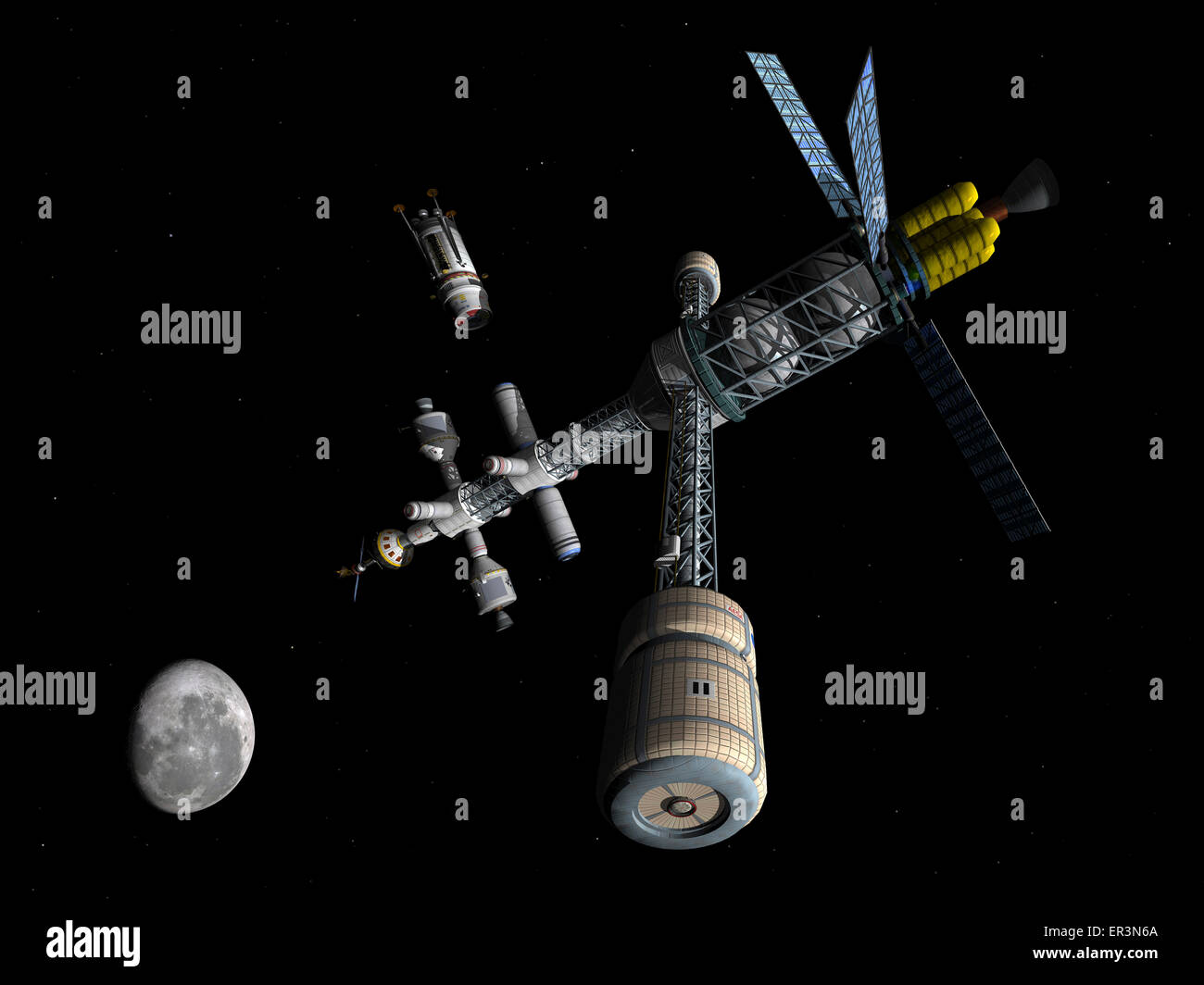 A living quarters module, secured to the end of a centrifuge boom, swings into the foreground while an unmanned cargo ship prepa Stock Photohttps://www.alamy.com/image-license-details/?v=1https://www.alamy.com/stock-photo-a-living-quarters-module-secured-to-the-end-of-a-centrifuge-boom-swings-83061058.html
A living quarters module, secured to the end of a centrifuge boom, swings into the foreground while an unmanned cargo ship prepa Stock Photohttps://www.alamy.com/image-license-details/?v=1https://www.alamy.com/stock-photo-a-living-quarters-module-secured-to-the-end-of-a-centrifuge-boom-swings-83061058.htmlRFER3N6A–A living quarters module, secured to the end of a centrifuge boom, swings into the foreground while an unmanned cargo ship prepa
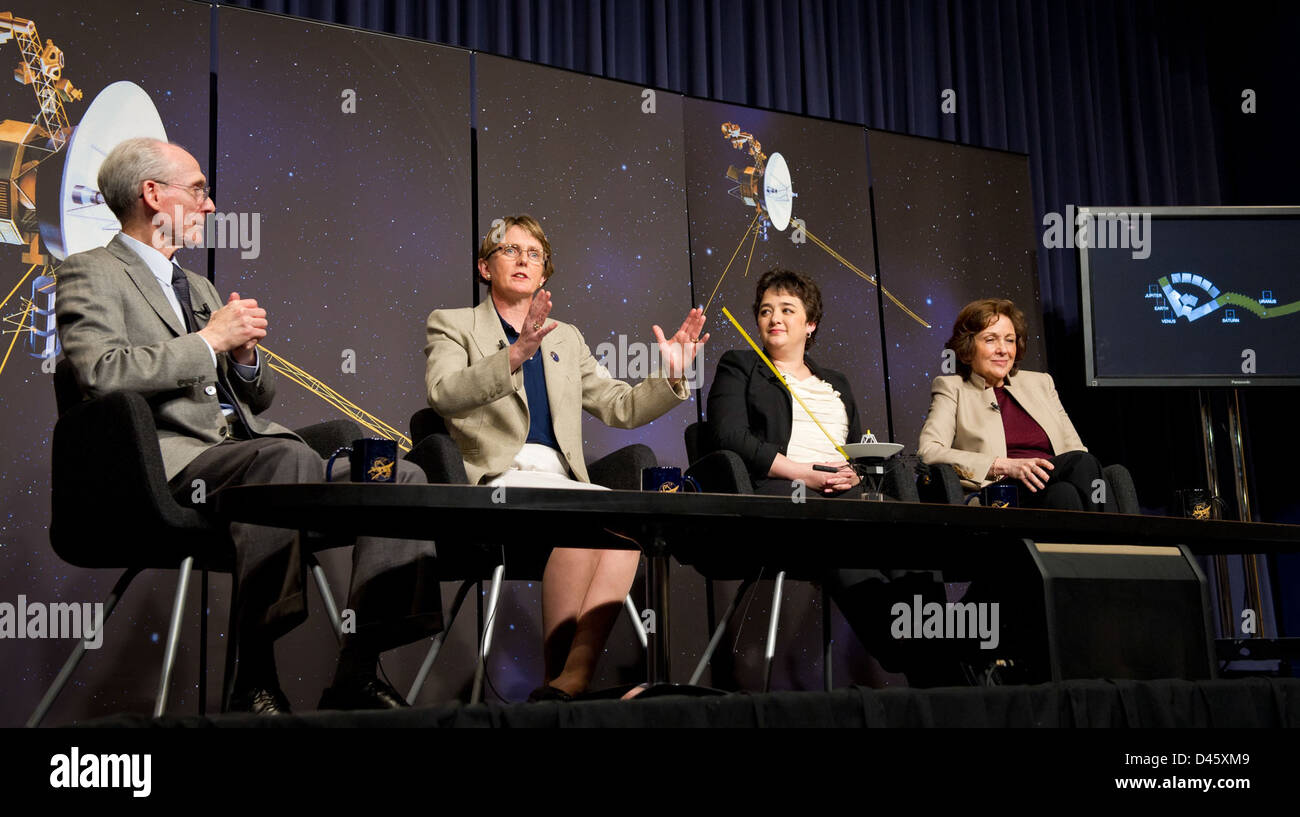 NASA’s Voyager spacecraft mission update highlights the Voyager I and II probes’ journey beyond the solar system. Ann Druyan and Ed Stone provide insights into the mission’s findings and milestones. Stock Photohttps://www.alamy.com/image-license-details/?v=1https://www.alamy.com/stock-photo-nasas-voyager-spacecraft-mission-update-highlights-the-voyager-i-and-54220441.html
NASA’s Voyager spacecraft mission update highlights the Voyager I and II probes’ journey beyond the solar system. Ann Druyan and Ed Stone provide insights into the mission’s findings and milestones. Stock Photohttps://www.alamy.com/image-license-details/?v=1https://www.alamy.com/stock-photo-nasas-voyager-spacecraft-mission-update-highlights-the-voyager-i-and-54220441.htmlRMD45XM9–NASA’s Voyager spacecraft mission update highlights the Voyager I and II probes’ journey beyond the solar system. Ann Druyan and Ed Stone provide insights into the mission’s findings and milestones.
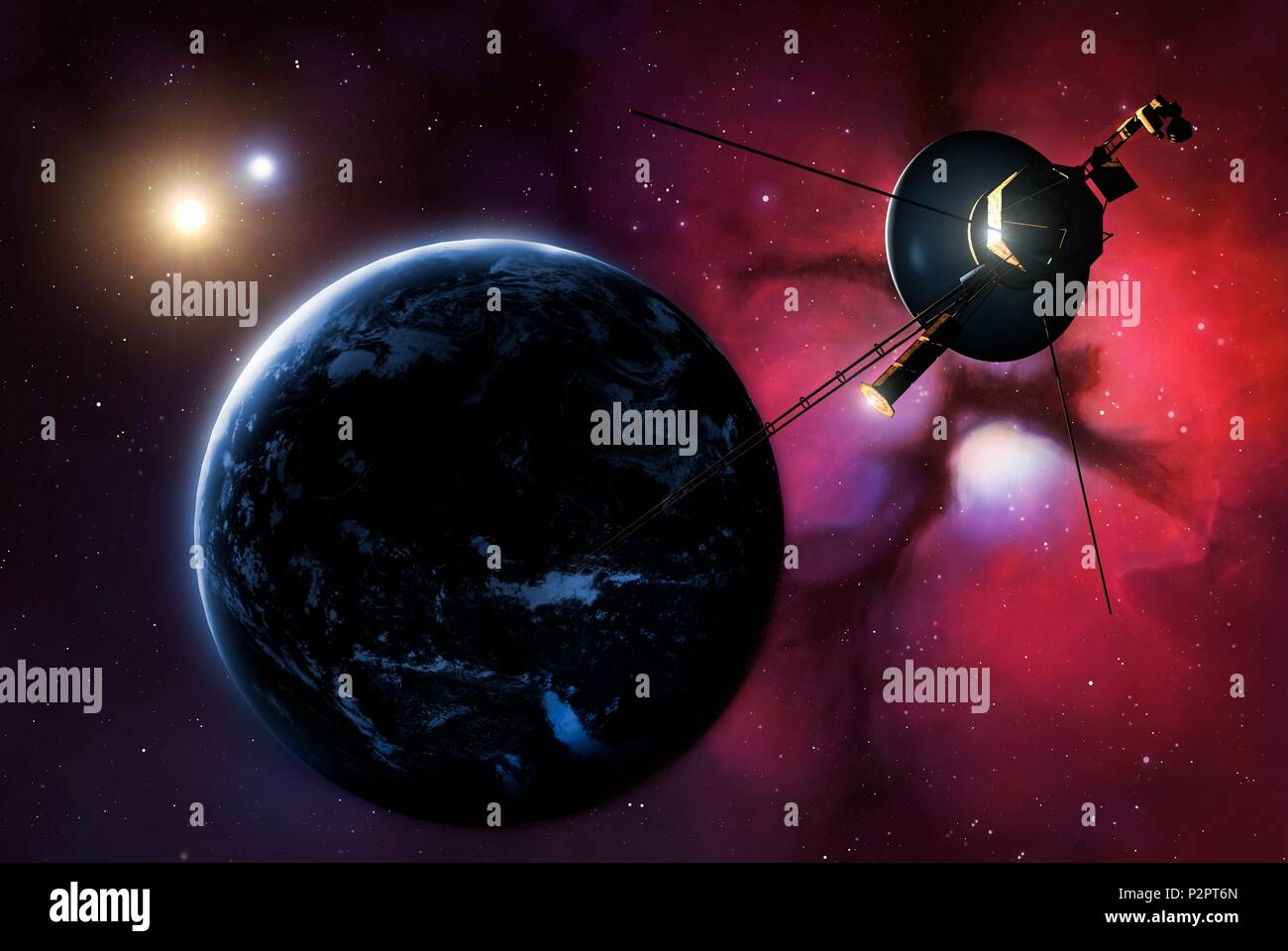 Illustration of one of the Voyager probes passing an earthlike planet orbiting a binary star system in the distant future. A nebula is seen in the background. The two Voyager probes were launched in the late 1970s. Voyager 1 has now passed into interstellar space - beyond the influence of the Sun's magnetic field - and Voyager 2 is set to do so in the early 2020s. Stock Photohttps://www.alamy.com/image-license-details/?v=1https://www.alamy.com/illustration-of-one-of-the-voyager-probes-passing-an-earthlike-planet-orbiting-a-binary-star-system-in-the-distant-future-a-nebula-is-seen-in-the-background-the-two-voyager-probes-were-launched-in-the-late-1970s-voyager-1-has-now-passed-into-interstellar-space-beyond-the-influence-of-the-suns-magnetic-field-and-voyager-2-is-set-to-do-so-in-the-early-2020s-image208255677.html
Illustration of one of the Voyager probes passing an earthlike planet orbiting a binary star system in the distant future. A nebula is seen in the background. The two Voyager probes were launched in the late 1970s. Voyager 1 has now passed into interstellar space - beyond the influence of the Sun's magnetic field - and Voyager 2 is set to do so in the early 2020s. Stock Photohttps://www.alamy.com/image-license-details/?v=1https://www.alamy.com/illustration-of-one-of-the-voyager-probes-passing-an-earthlike-planet-orbiting-a-binary-star-system-in-the-distant-future-a-nebula-is-seen-in-the-background-the-two-voyager-probes-were-launched-in-the-late-1970s-voyager-1-has-now-passed-into-interstellar-space-beyond-the-influence-of-the-suns-magnetic-field-and-voyager-2-is-set-to-do-so-in-the-early-2020s-image208255677.htmlRFP2PT6N–Illustration of one of the Voyager probes passing an earthlike planet orbiting a binary star system in the distant future. A nebula is seen in the background. The two Voyager probes were launched in the late 1970s. Voyager 1 has now passed into interstellar space - beyond the influence of the Sun's magnetic field - and Voyager 2 is set to do so in the early 2020s.
 Spaceships traveling through galaxy, space probes passing through stars and nebulae, returning home, Western Europe, sun rising behind. Stock Photohttps://www.alamy.com/image-license-details/?v=1https://www.alamy.com/spaceships-traveling-through-galaxy-space-probes-passing-through-stars-and-nebulae-returning-home-western-europe-sun-rising-behind-image473985730.html
Spaceships traveling through galaxy, space probes passing through stars and nebulae, returning home, Western Europe, sun rising behind. Stock Photohttps://www.alamy.com/image-license-details/?v=1https://www.alamy.com/spaceships-traveling-through-galaxy-space-probes-passing-through-stars-and-nebulae-returning-home-western-europe-sun-rising-behind-image473985730.htmlRF2JF3WHP–Spaceships traveling through galaxy, space probes passing through stars and nebulae, returning home, Western Europe, sun rising behind.
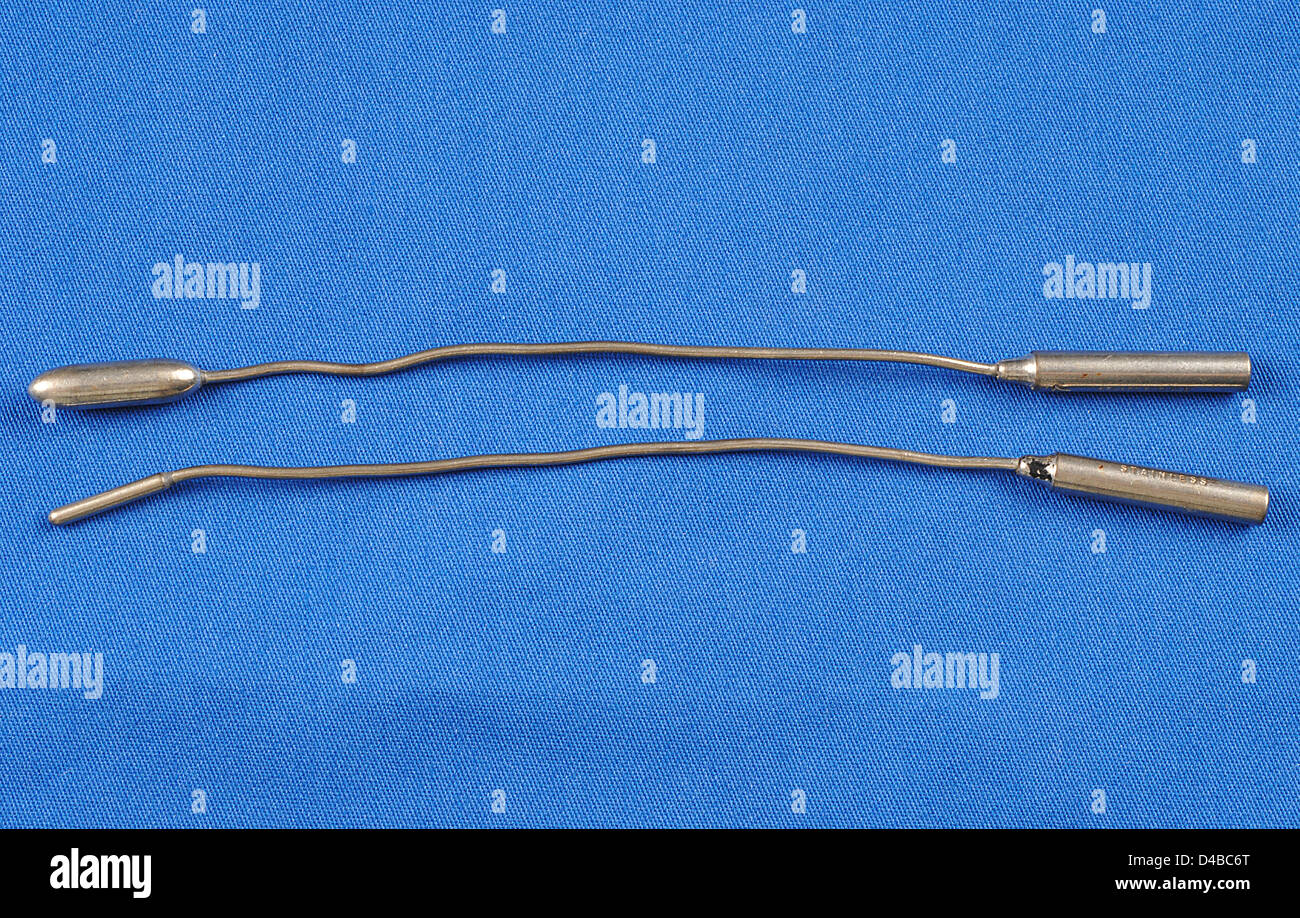 Two different sized probes used to gauge the depth of a cavity or sinus during surgery. Stock Photohttps://www.alamy.com/image-license-details/?v=1https://www.alamy.com/stock-photo-two-different-sized-probes-used-to-gauge-the-depth-of-a-cavity-or-54340800.html
Two different sized probes used to gauge the depth of a cavity or sinus during surgery. Stock Photohttps://www.alamy.com/image-license-details/?v=1https://www.alamy.com/stock-photo-two-different-sized-probes-used-to-gauge-the-depth-of-a-cavity-or-54340800.htmlRMD4BC6T–Two different sized probes used to gauge the depth of a cavity or sinus during surgery.
RF3BKYF56–Displaying dental tray with handpieces, probes and mirror in exam room with icons, copy space
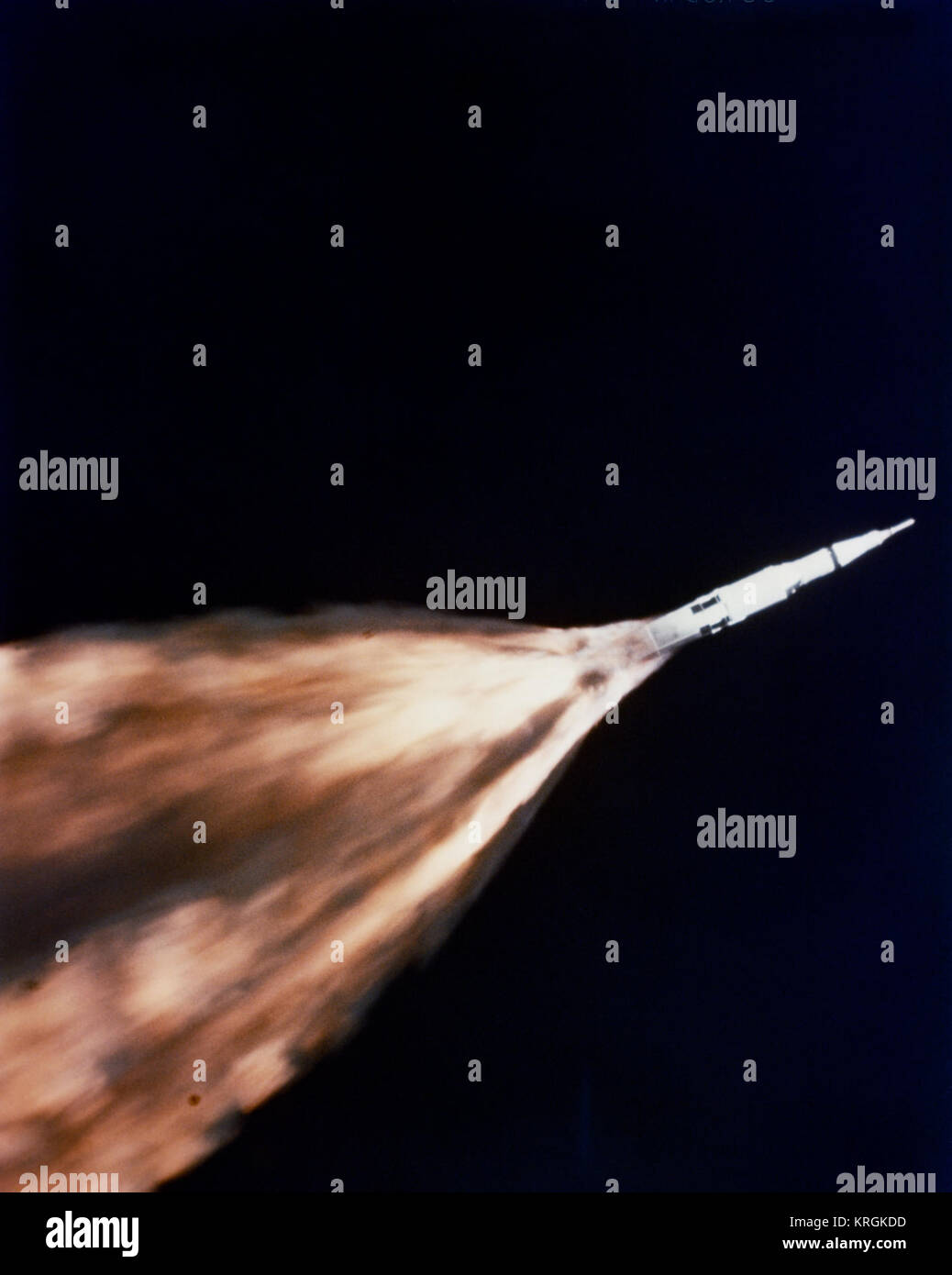 S68-27365 Stock Photohttps://www.alamy.com/image-license-details/?v=1https://www.alamy.com/stock-image-s68-27365-169396905.html
S68-27365 Stock Photohttps://www.alamy.com/image-license-details/?v=1https://www.alamy.com/stock-image-s68-27365-169396905.htmlRMKRGKDD–S68-27365
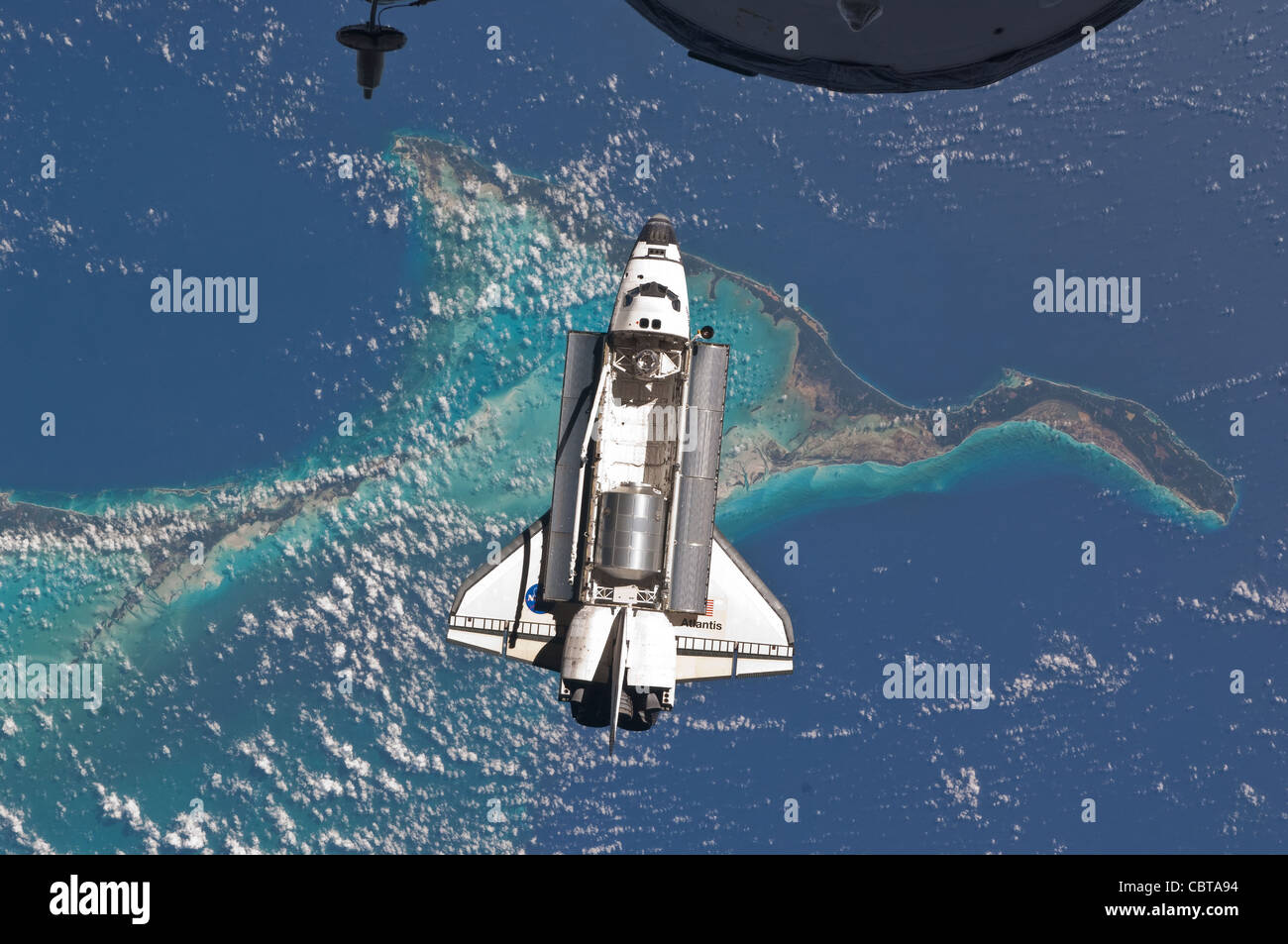 Space Shuttle Atlantis over Bahamas July 10, 2011 Stock Photohttps://www.alamy.com/image-license-details/?v=1https://www.alamy.com/stock-photo-space-shuttle-atlantis-over-bahamas-july-10-2011-41716896.html
Space Shuttle Atlantis over Bahamas July 10, 2011 Stock Photohttps://www.alamy.com/image-license-details/?v=1https://www.alamy.com/stock-photo-space-shuttle-atlantis-over-bahamas-july-10-2011-41716896.htmlRFCBTA94–Space Shuttle Atlantis over Bahamas July 10, 2011
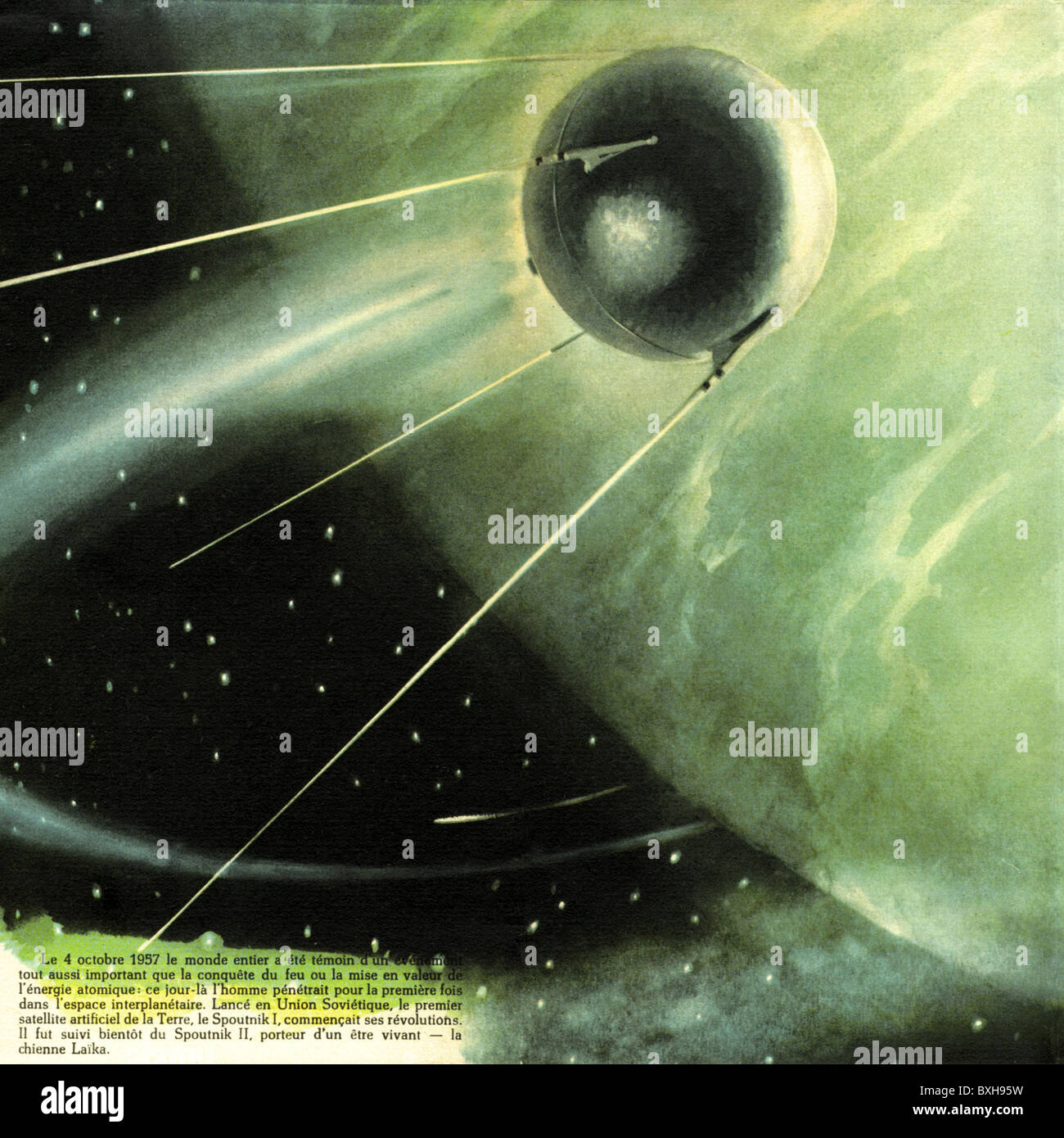 astronautics, space probes, Sputnik I, first space travel, USSR, 4.10.1957, Additional-Rights-Clearences-Not Available Stock Photohttps://www.alamy.com/image-license-details/?v=1https://www.alamy.com/stock-photo-astronautics-space-probes-sputnik-i-first-space-travel-ussr-4101957-33571829.html
astronautics, space probes, Sputnik I, first space travel, USSR, 4.10.1957, Additional-Rights-Clearences-Not Available Stock Photohttps://www.alamy.com/image-license-details/?v=1https://www.alamy.com/stock-photo-astronautics-space-probes-sputnik-i-first-space-travel-ussr-4101957-33571829.htmlRMBXH95W–astronautics, space probes, Sputnik I, first space travel, USSR, 4.10.1957, Additional-Rights-Clearences-Not Available
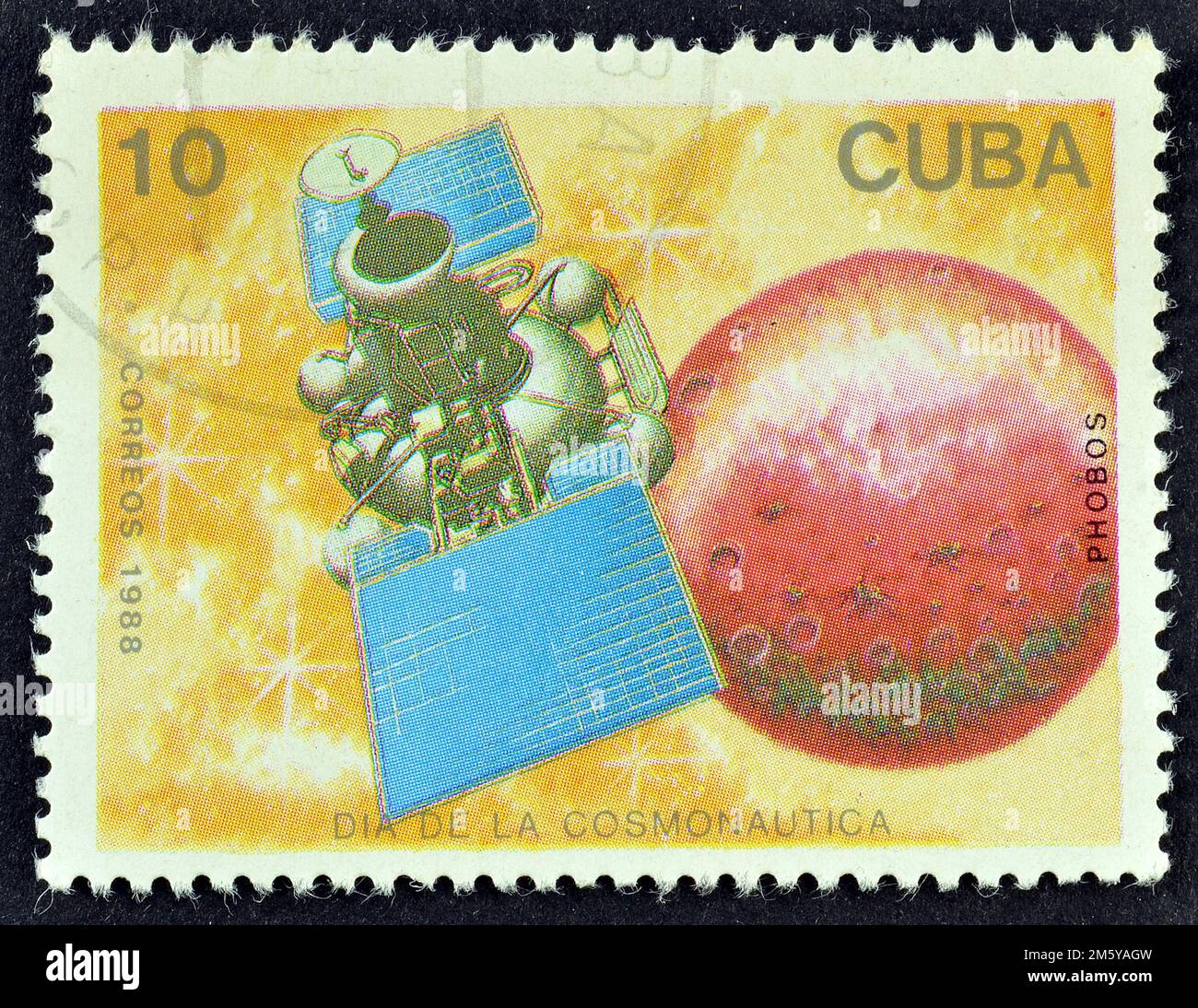 Cancelled postage stamp printed by Cuba, that shows Phobos, Satellites and Space Probes, circa 1988. Stock Photohttps://www.alamy.com/image-license-details/?v=1https://www.alamy.com/cancelled-postage-stamp-printed-by-cuba-that-shows-phobos-satellites-and-space-probes-circa-1988-image502774969.html
Cancelled postage stamp printed by Cuba, that shows Phobos, Satellites and Space Probes, circa 1988. Stock Photohttps://www.alamy.com/image-license-details/?v=1https://www.alamy.com/cancelled-postage-stamp-printed-by-cuba-that-shows-phobos-satellites-and-space-probes-circa-1988-image502774969.htmlRM2M5YAGW–Cancelled postage stamp printed by Cuba, that shows Phobos, Satellites and Space Probes, circa 1988.
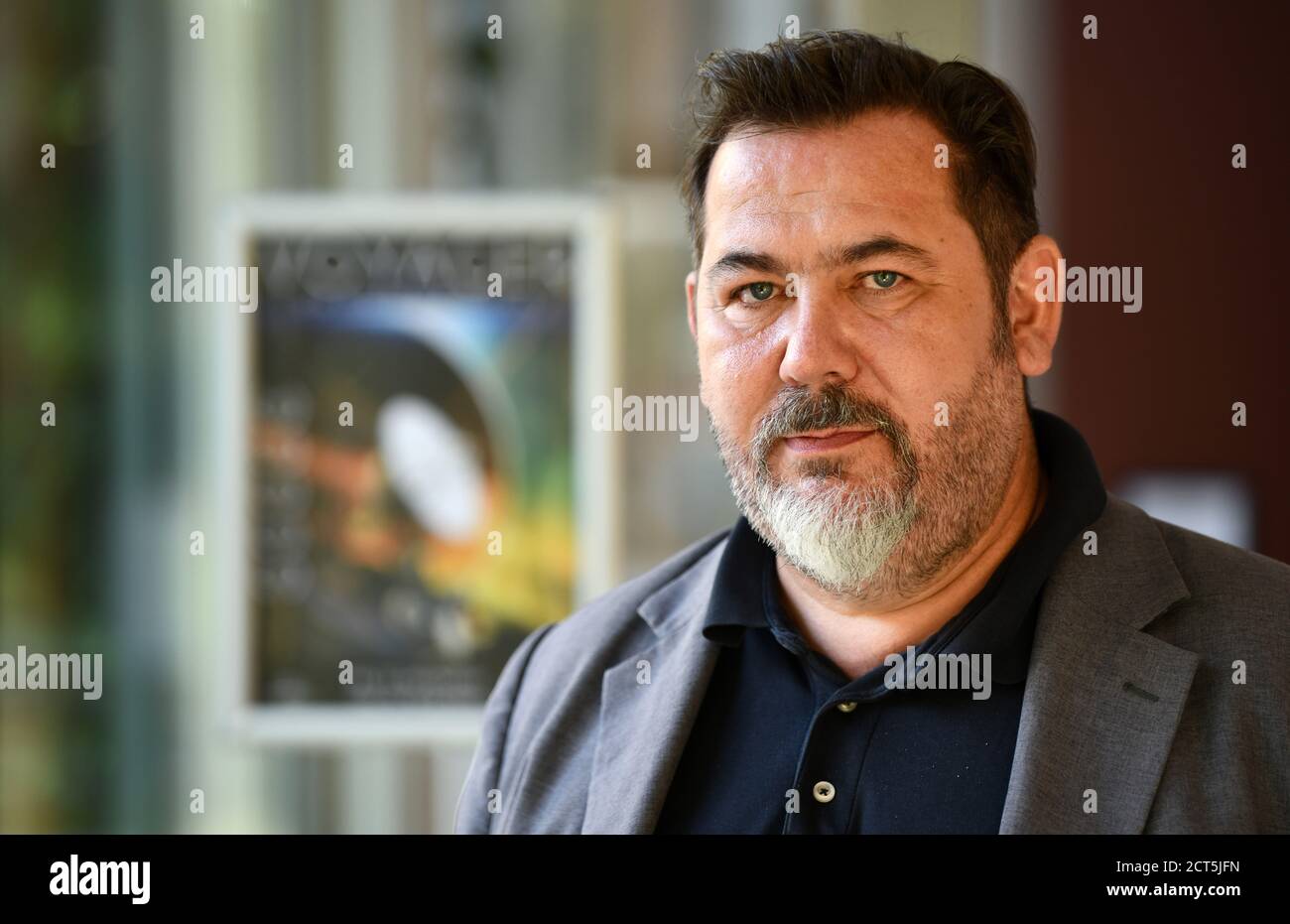 Jena, Germany. 21st Sep, 2020. Jörg Hühn, managing director of the Zeiss-Planetarium Jena. From 23 September, the new programme 'Voyager - The Infinite Mission' will offer visitors images of the outermost planets of the solar system and their moons, taken by the US space probes Voyager 1 and 2. The planetarium had to close for almost three months in spring because of the Corona pandemic. It has only been receiving visitors again since 9 June. Credit: Martin Schutt/dpa-Zentralbild/dpa/Alamy Live News Stock Photohttps://www.alamy.com/image-license-details/?v=1https://www.alamy.com/jena-germany-21st-sep-2020-jrg-hhn-managing-director-of-the-zeiss-planetarium-jena-from-23-september-the-new-programme-voyager-the-infinite-mission-will-offer-visitors-images-of-the-outermost-planets-of-the-solar-system-and-their-moons-taken-by-the-us-space-probes-voyager-1-and-2-the-planetarium-had-to-close-for-almost-three-months-in-spring-because-of-the-corona-pandemic-it-has-only-been-receiving-visitors-again-since-9-june-credit-martin-schuttdpa-zentralbilddpaalamy-live-news-image376293785.html
Jena, Germany. 21st Sep, 2020. Jörg Hühn, managing director of the Zeiss-Planetarium Jena. From 23 September, the new programme 'Voyager - The Infinite Mission' will offer visitors images of the outermost planets of the solar system and their moons, taken by the US space probes Voyager 1 and 2. The planetarium had to close for almost three months in spring because of the Corona pandemic. It has only been receiving visitors again since 9 June. Credit: Martin Schutt/dpa-Zentralbild/dpa/Alamy Live News Stock Photohttps://www.alamy.com/image-license-details/?v=1https://www.alamy.com/jena-germany-21st-sep-2020-jrg-hhn-managing-director-of-the-zeiss-planetarium-jena-from-23-september-the-new-programme-voyager-the-infinite-mission-will-offer-visitors-images-of-the-outermost-planets-of-the-solar-system-and-their-moons-taken-by-the-us-space-probes-voyager-1-and-2-the-planetarium-had-to-close-for-almost-three-months-in-spring-because-of-the-corona-pandemic-it-has-only-been-receiving-visitors-again-since-9-june-credit-martin-schuttdpa-zentralbilddpaalamy-live-news-image376293785.htmlRM2CT5JFN–Jena, Germany. 21st Sep, 2020. Jörg Hühn, managing director of the Zeiss-Planetarium Jena. From 23 September, the new programme 'Voyager - The Infinite Mission' will offer visitors images of the outermost planets of the solar system and their moons, taken by the US space probes Voyager 1 and 2. The planetarium had to close for almost three months in spring because of the Corona pandemic. It has only been receiving visitors again since 9 June. Credit: Martin Schutt/dpa-Zentralbild/dpa/Alamy Live News
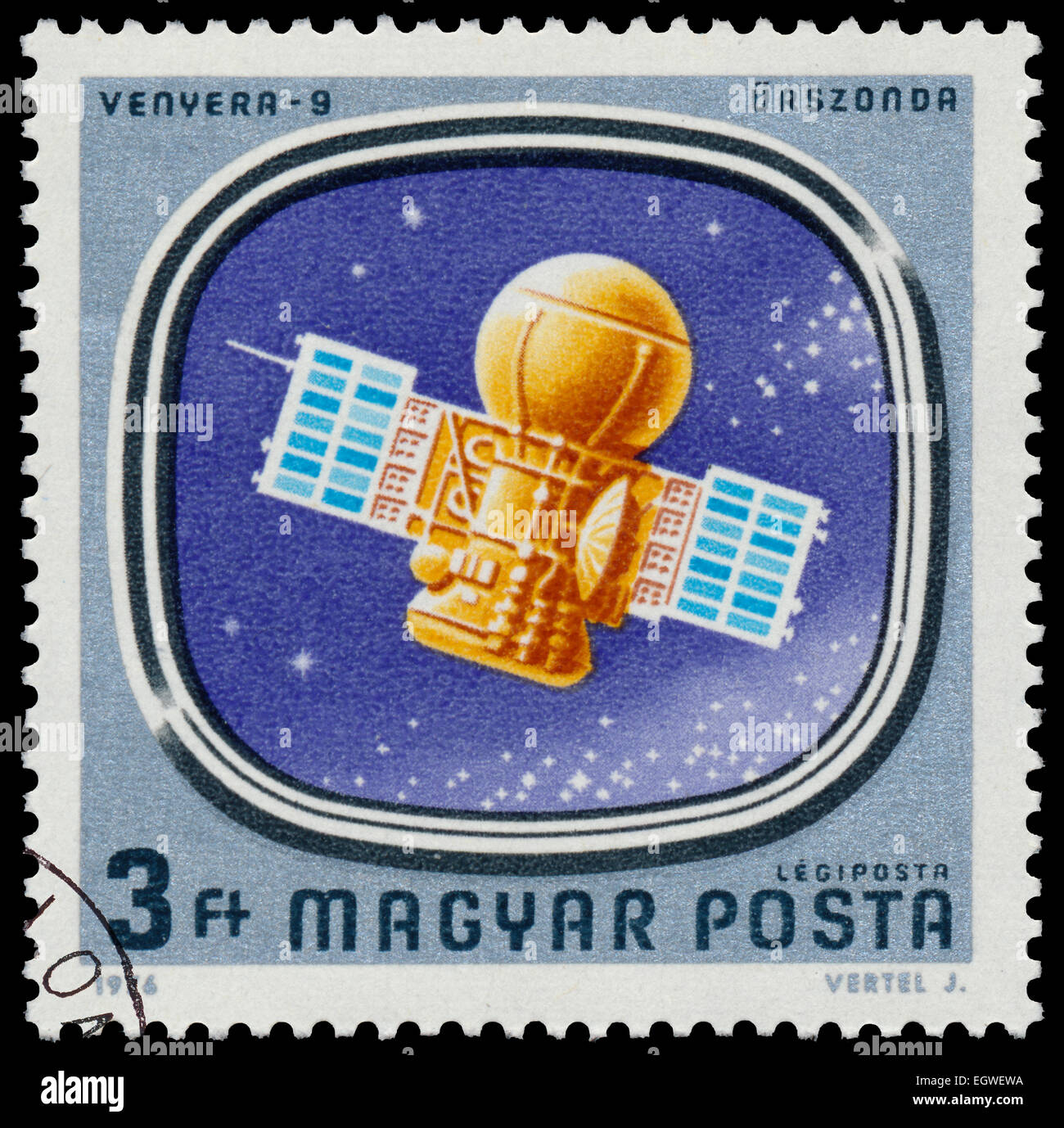 HUNGARY - CIRCA 1976: Stamp printed in Hungary shows Venera, with the same inscription, from the series 'Space Probes to Mars an Stock Photohttps://www.alamy.com/image-license-details/?v=1https://www.alamy.com/stock-photo-hungary-circa-1976-stamp-printed-in-hungary-shows-venera-with-the-79236454.html
HUNGARY - CIRCA 1976: Stamp printed in Hungary shows Venera, with the same inscription, from the series 'Space Probes to Mars an Stock Photohttps://www.alamy.com/image-license-details/?v=1https://www.alamy.com/stock-photo-hungary-circa-1976-stamp-printed-in-hungary-shows-venera-with-the-79236454.htmlRFEGWEWA–HUNGARY - CIRCA 1976: Stamp printed in Hungary shows Venera, with the same inscription, from the series 'Space Probes to Mars an
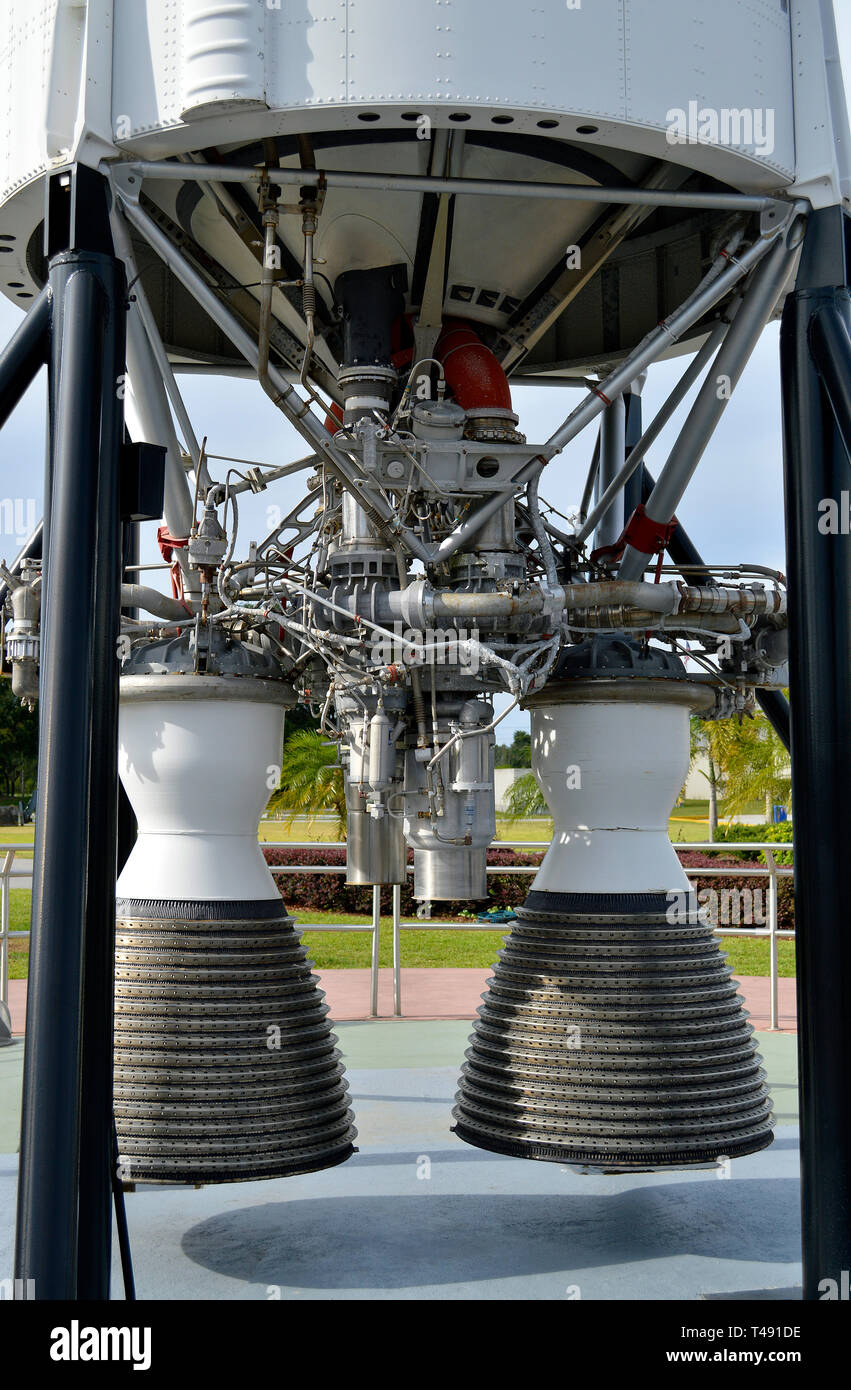 Apollo F1 Engine on display at Kennedy Space Centre in Florida Stock Photohttps://www.alamy.com/image-license-details/?v=1https://www.alamy.com/apollo-f1-engine-on-display-at-kennedy-space-centre-in-florida-image243602506.html
Apollo F1 Engine on display at Kennedy Space Centre in Florida Stock Photohttps://www.alamy.com/image-license-details/?v=1https://www.alamy.com/apollo-f1-engine-on-display-at-kennedy-space-centre-in-florida-image243602506.htmlRFT491DE–Apollo F1 Engine on display at Kennedy Space Centre in Florida
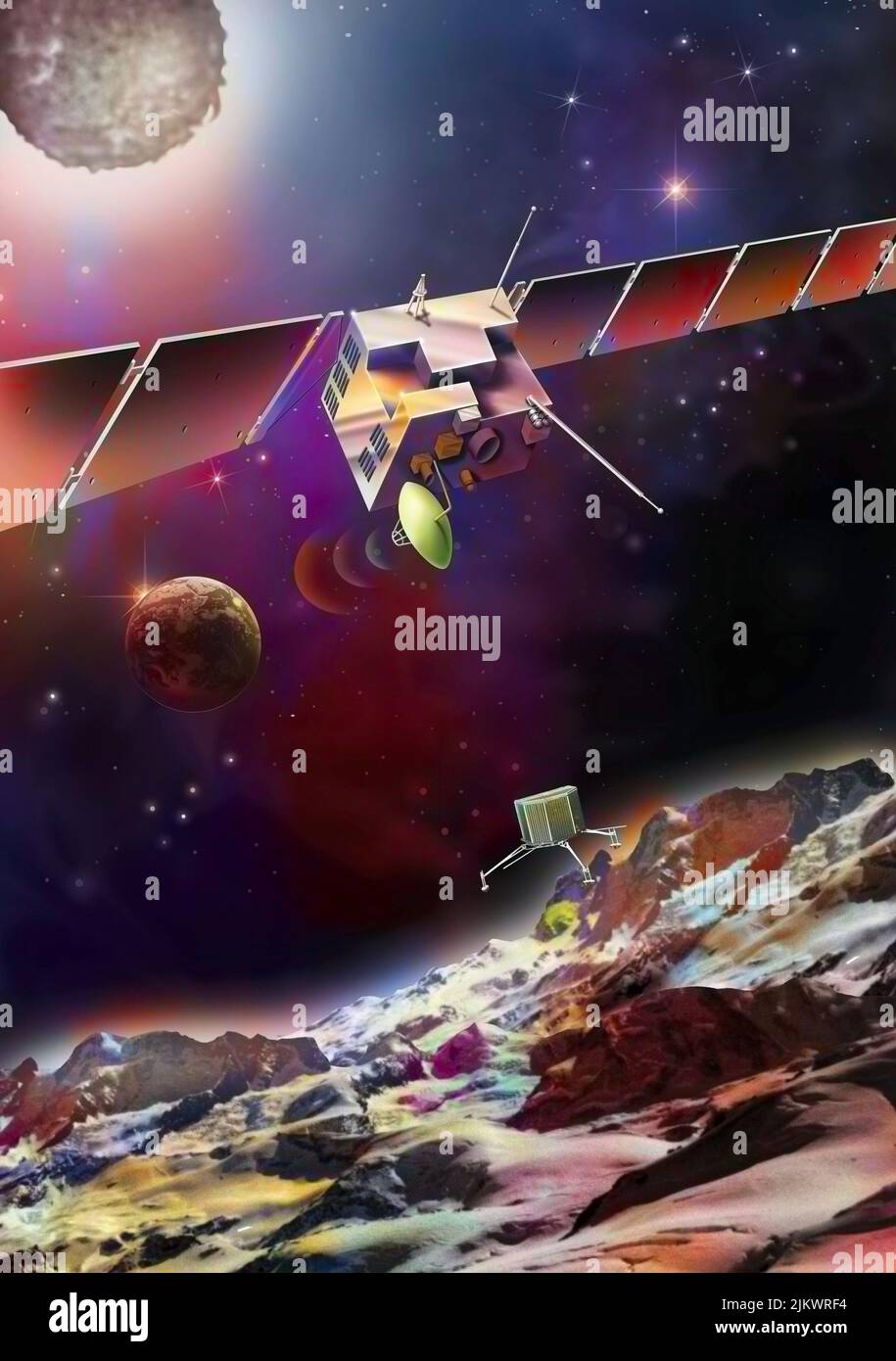 Sending the Rosetta probe to the surface of comet Wirtanen. Stock Photohttps://www.alamy.com/image-license-details/?v=1https://www.alamy.com/sending-the-rosetta-probe-to-the-surface-of-comet-wirtanen-image476925656.html
Sending the Rosetta probe to the surface of comet Wirtanen. Stock Photohttps://www.alamy.com/image-license-details/?v=1https://www.alamy.com/sending-the-rosetta-probe-to-the-surface-of-comet-wirtanen-image476925656.htmlRF2JKWRF4–Sending the Rosetta probe to the surface of comet Wirtanen.
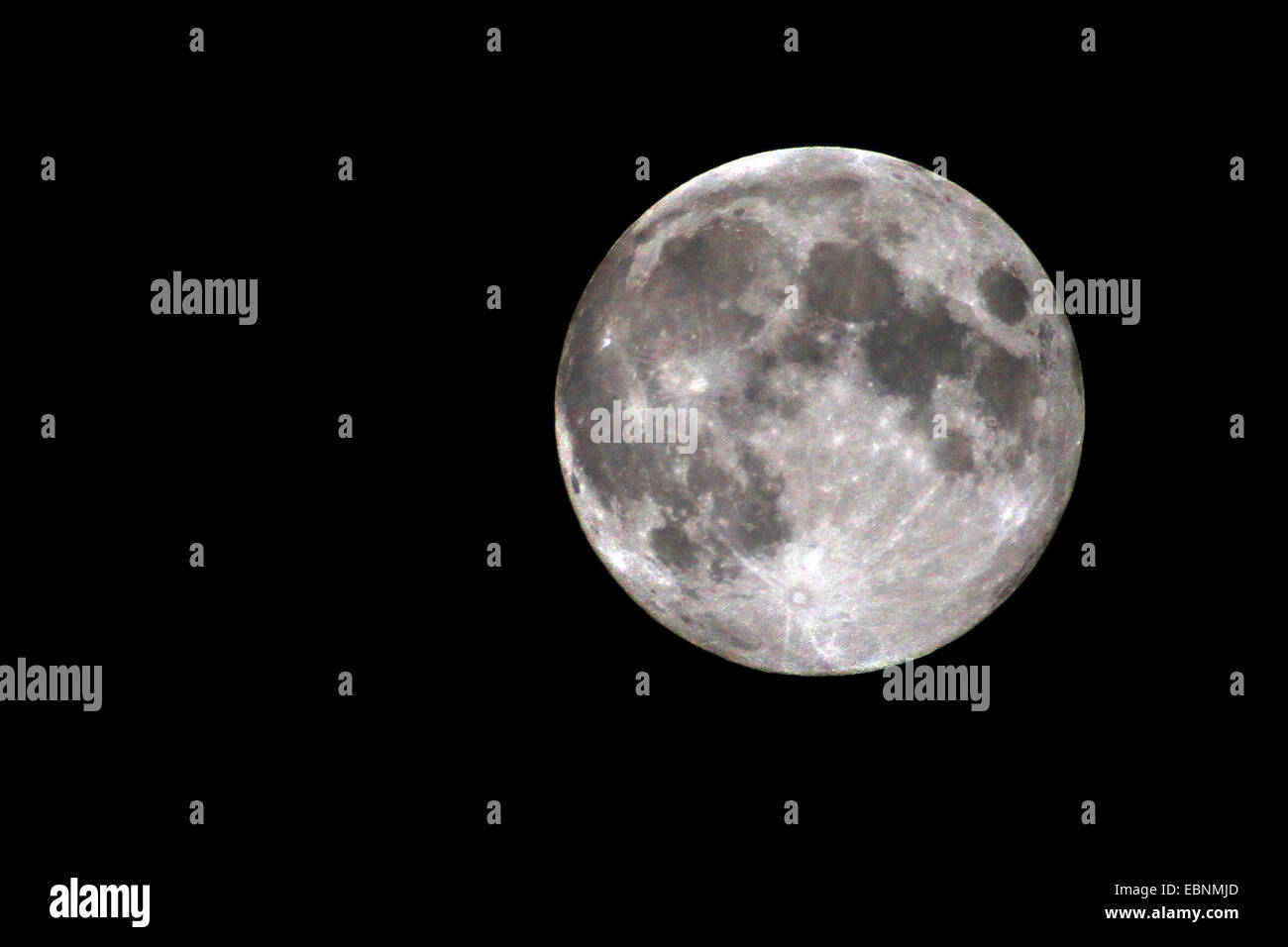 full moon, at the top on the right the Mare Imbrium where the chinese space probe ChangÆe-3 landed on 14.12.2013 Stock Photohttps://www.alamy.com/image-license-details/?v=1https://www.alamy.com/stock-photo-full-moon-at-the-top-on-the-right-the-mare-imbrium-where-the-chinese-76079877.html
full moon, at the top on the right the Mare Imbrium where the chinese space probe ChangÆe-3 landed on 14.12.2013 Stock Photohttps://www.alamy.com/image-license-details/?v=1https://www.alamy.com/stock-photo-full-moon-at-the-top-on-the-right-the-mare-imbrium-where-the-chinese-76079877.htmlRMEBNMJD–full moon, at the top on the right the Mare Imbrium where the chinese space probe ChangÆe-3 landed on 14.12.2013
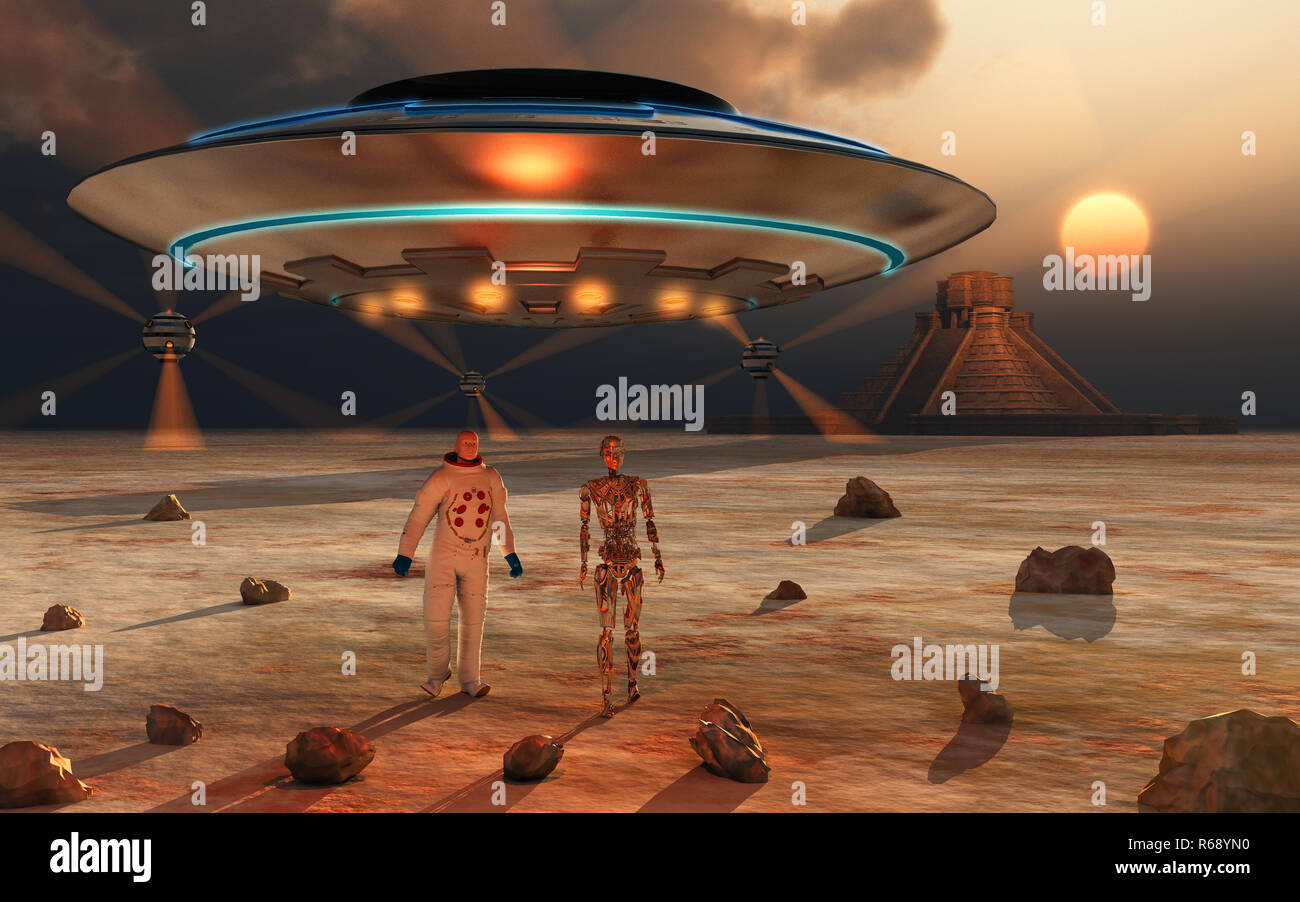 Time & Space Travellers Stock Photohttps://www.alamy.com/image-license-details/?v=1https://www.alamy.com/time-space-travellers-image227620092.html
Time & Space Travellers Stock Photohttps://www.alamy.com/image-license-details/?v=1https://www.alamy.com/time-space-travellers-image227620092.htmlRMR68YN0–Time & Space Travellers
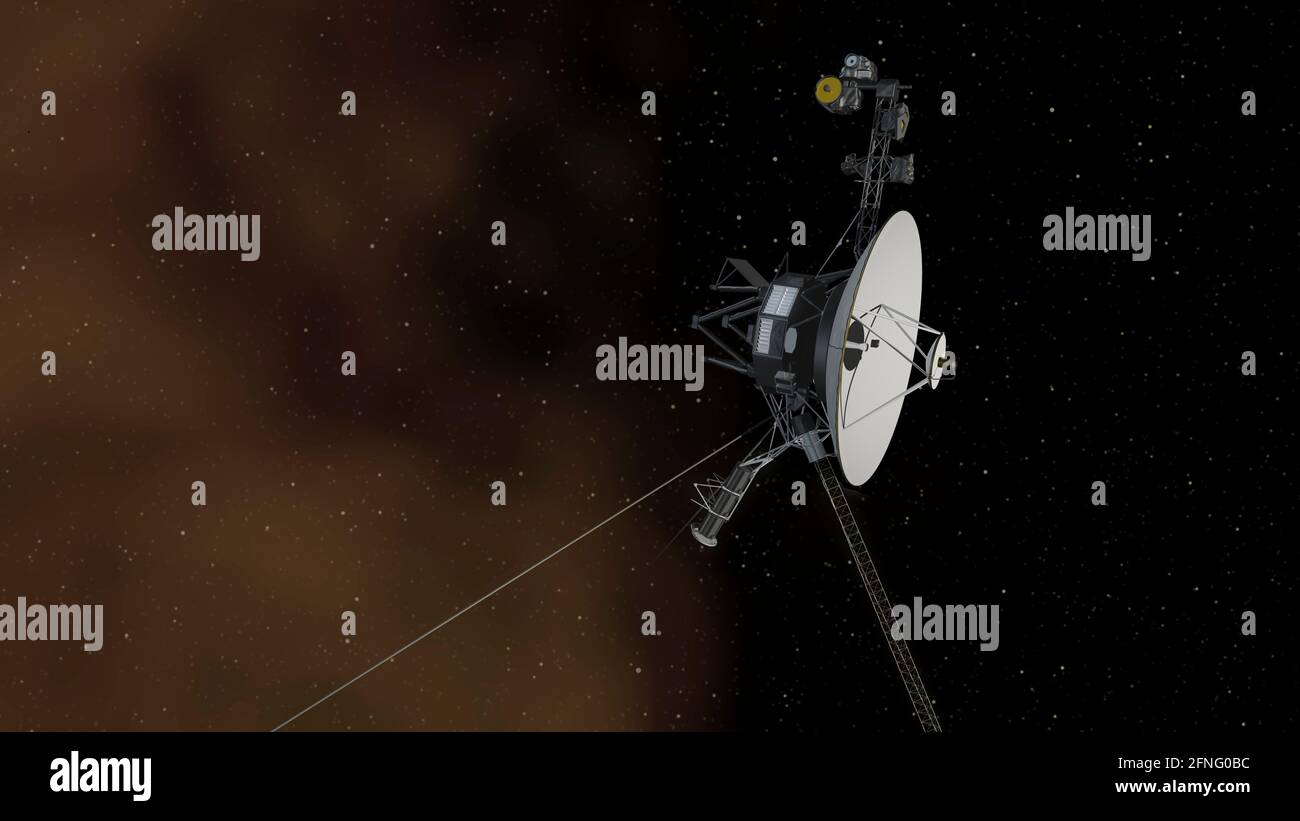 This artist's concept depicts NASA's Voyager 1 spacecraft entering interstellar space, or the space between stars. Interstellar space is dominated by Stock Photohttps://www.alamy.com/image-license-details/?v=1https://www.alamy.com/this-artists-concept-depicts-nasas-voyager-1-spacecraft-entering-interstellar-space-or-the-space-between-stars-interstellar-space-is-dominated-by-image426308160.html
This artist's concept depicts NASA's Voyager 1 spacecraft entering interstellar space, or the space between stars. Interstellar space is dominated by Stock Photohttps://www.alamy.com/image-license-details/?v=1https://www.alamy.com/this-artists-concept-depicts-nasas-voyager-1-spacecraft-entering-interstellar-space-or-the-space-between-stars-interstellar-space-is-dominated-by-image426308160.htmlRF2FNG0BC–This artist's concept depicts NASA's Voyager 1 spacecraft entering interstellar space, or the space between stars. Interstellar space is dominated by
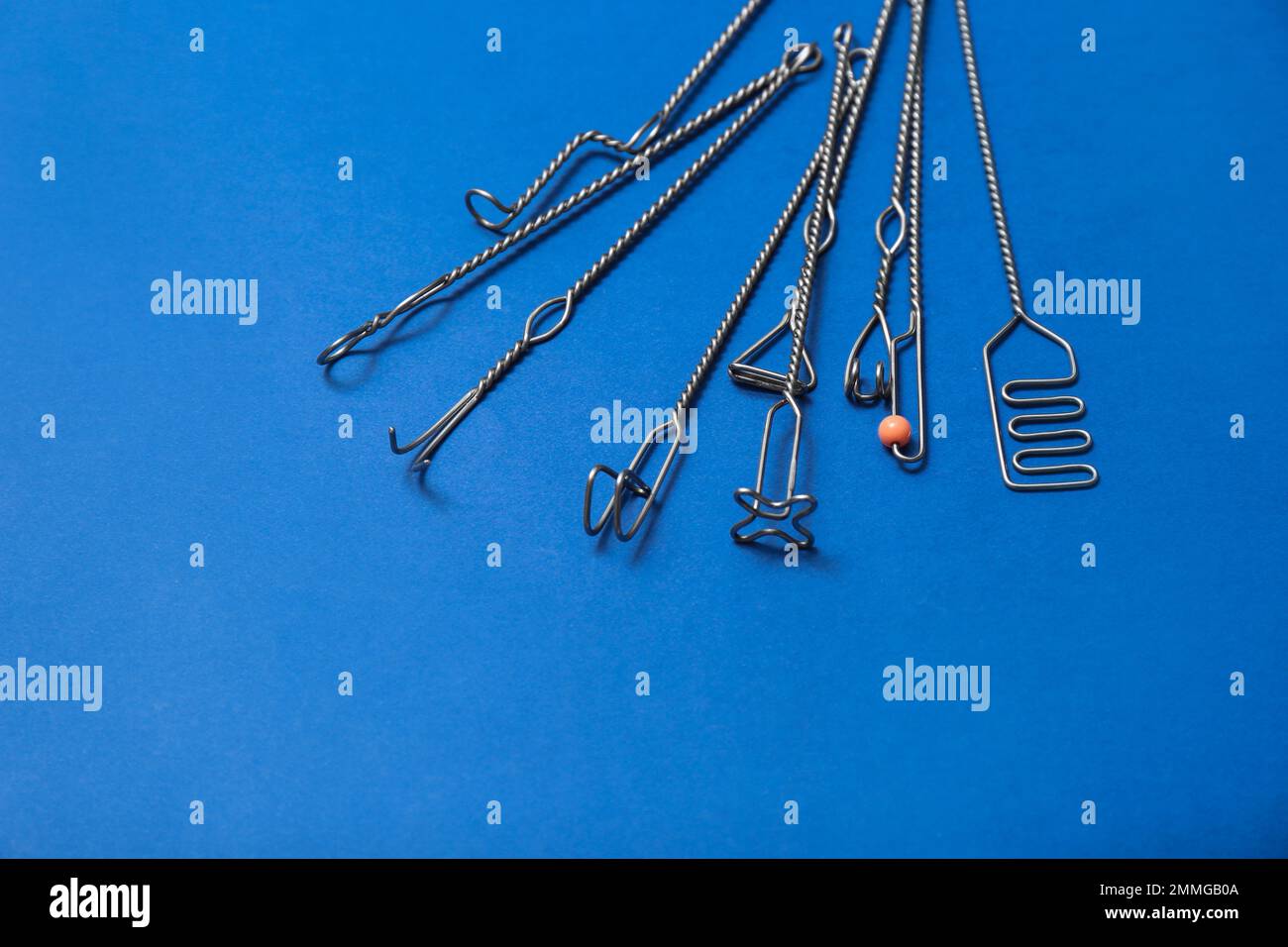 Set of logopedic probes for speech therapy on blue background. Space for text Stock Photohttps://www.alamy.com/image-license-details/?v=1https://www.alamy.com/set-of-logopedic-probes-for-speech-therapy-on-blue-background-space-for-text-image511753658.html
Set of logopedic probes for speech therapy on blue background. Space for text Stock Photohttps://www.alamy.com/image-license-details/?v=1https://www.alamy.com/set-of-logopedic-probes-for-speech-therapy-on-blue-background-space-for-text-image511753658.htmlRF2MMGB0A–Set of logopedic probes for speech therapy on blue background. Space for text
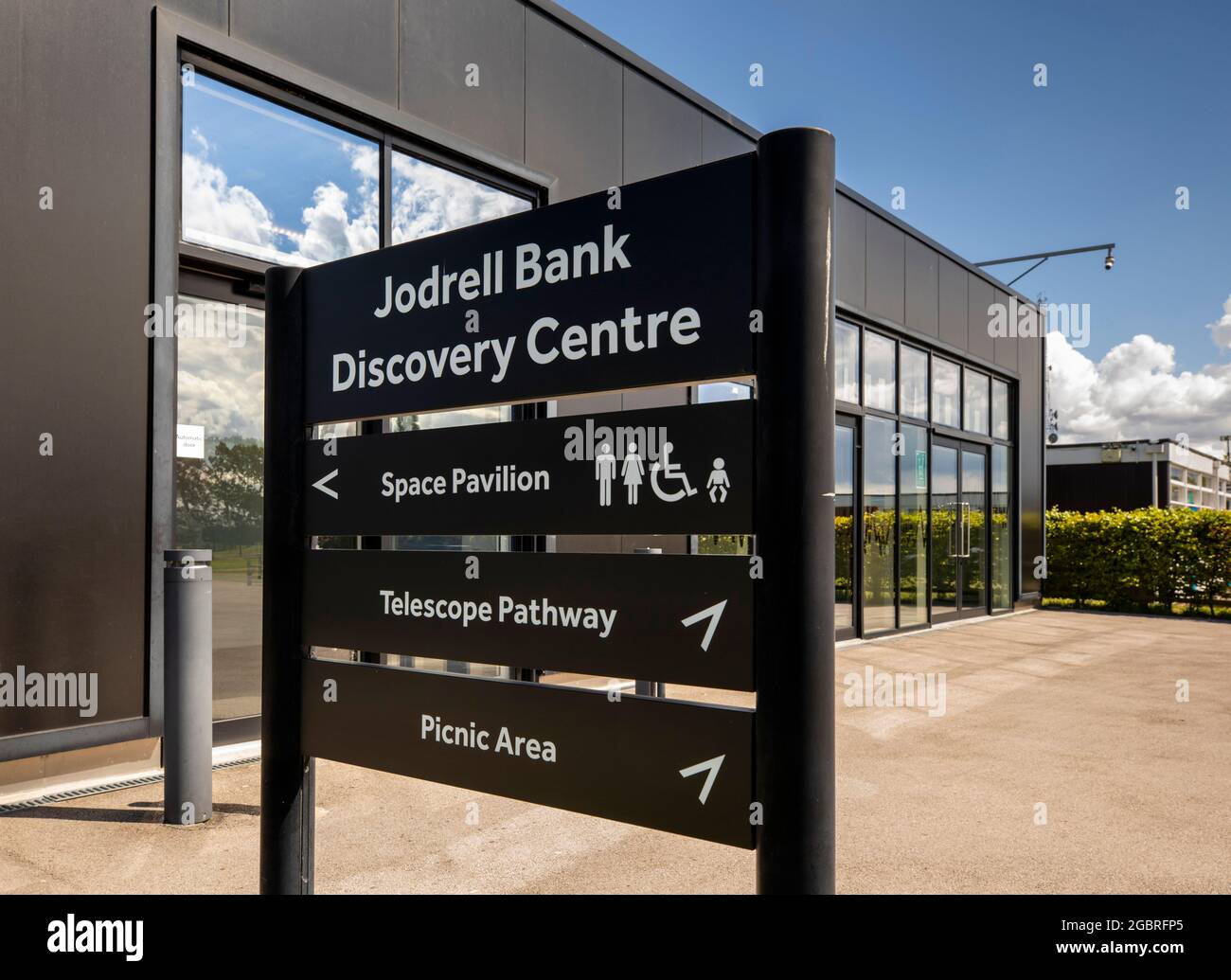 UK, England, Cheshire, Goostrey, University of Manchester, Jodrell Bank, Space Pavilion Stock Photohttps://www.alamy.com/image-license-details/?v=1https://www.alamy.com/uk-england-cheshire-goostrey-university-of-manchester-jodrell-bank-space-pavilion-image437537693.html
UK, England, Cheshire, Goostrey, University of Manchester, Jodrell Bank, Space Pavilion Stock Photohttps://www.alamy.com/image-license-details/?v=1https://www.alamy.com/uk-england-cheshire-goostrey-university-of-manchester-jodrell-bank-space-pavilion-image437537693.htmlRM2GBRFP5–UK, England, Cheshire, Goostrey, University of Manchester, Jodrell Bank, Space Pavilion
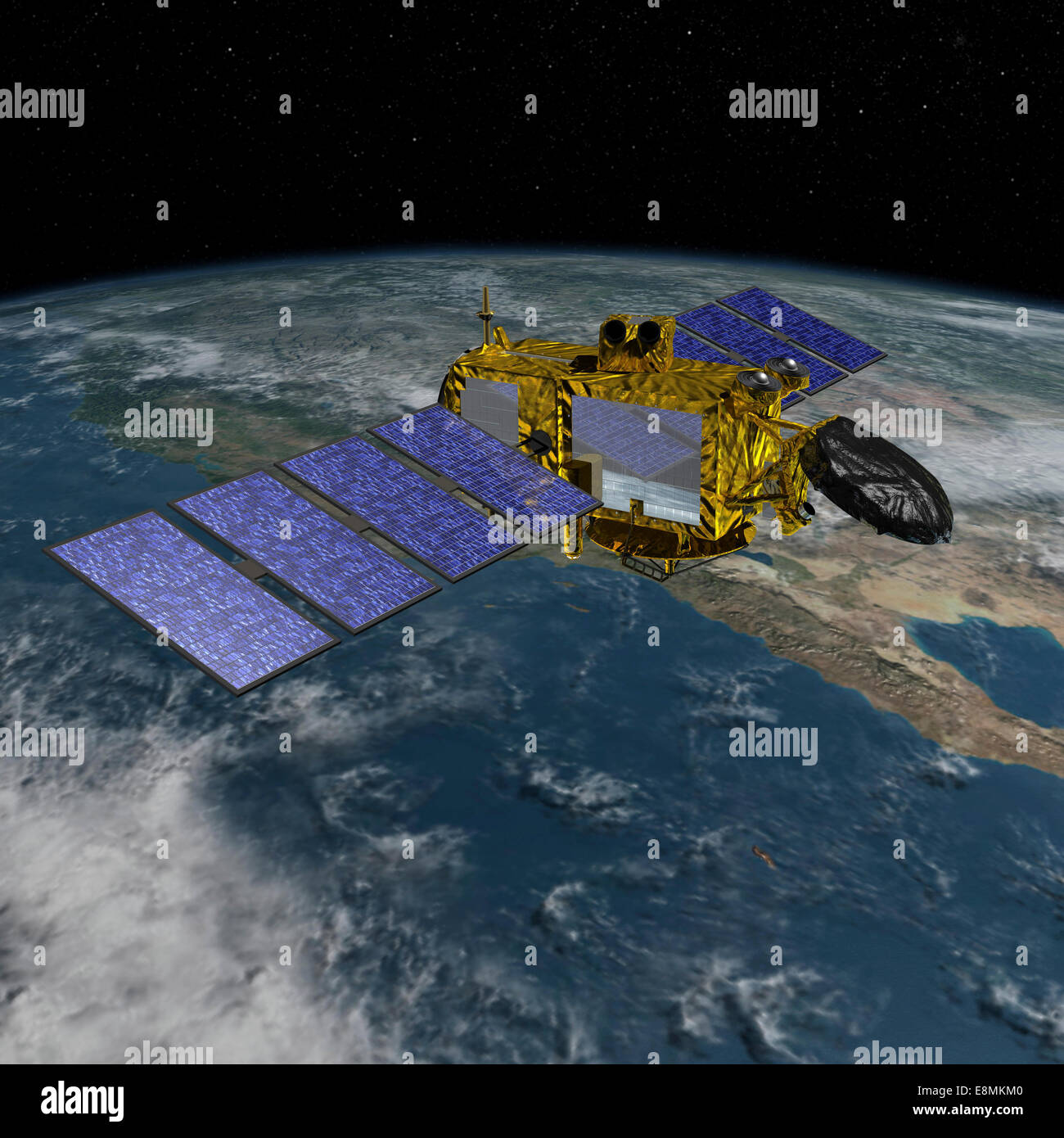 Artist's concept of the U.S./European Jason-3 spacecraft over the California coast. Jason-3 is the fourth mission in U.S.-Europ Stock Photohttps://www.alamy.com/image-license-details/?v=1https://www.alamy.com/stock-photo-artists-concept-of-the-useuropean-jason-3-spacecraft-over-the-california-74213216.html
Artist's concept of the U.S./European Jason-3 spacecraft over the California coast. Jason-3 is the fourth mission in U.S.-Europ Stock Photohttps://www.alamy.com/image-license-details/?v=1https://www.alamy.com/stock-photo-artists-concept-of-the-useuropean-jason-3-spacecraft-over-the-california-74213216.htmlRFE8MKM0–Artist's concept of the U.S./European Jason-3 spacecraft over the California coast. Jason-3 is the fourth mission in U.S.-Europ
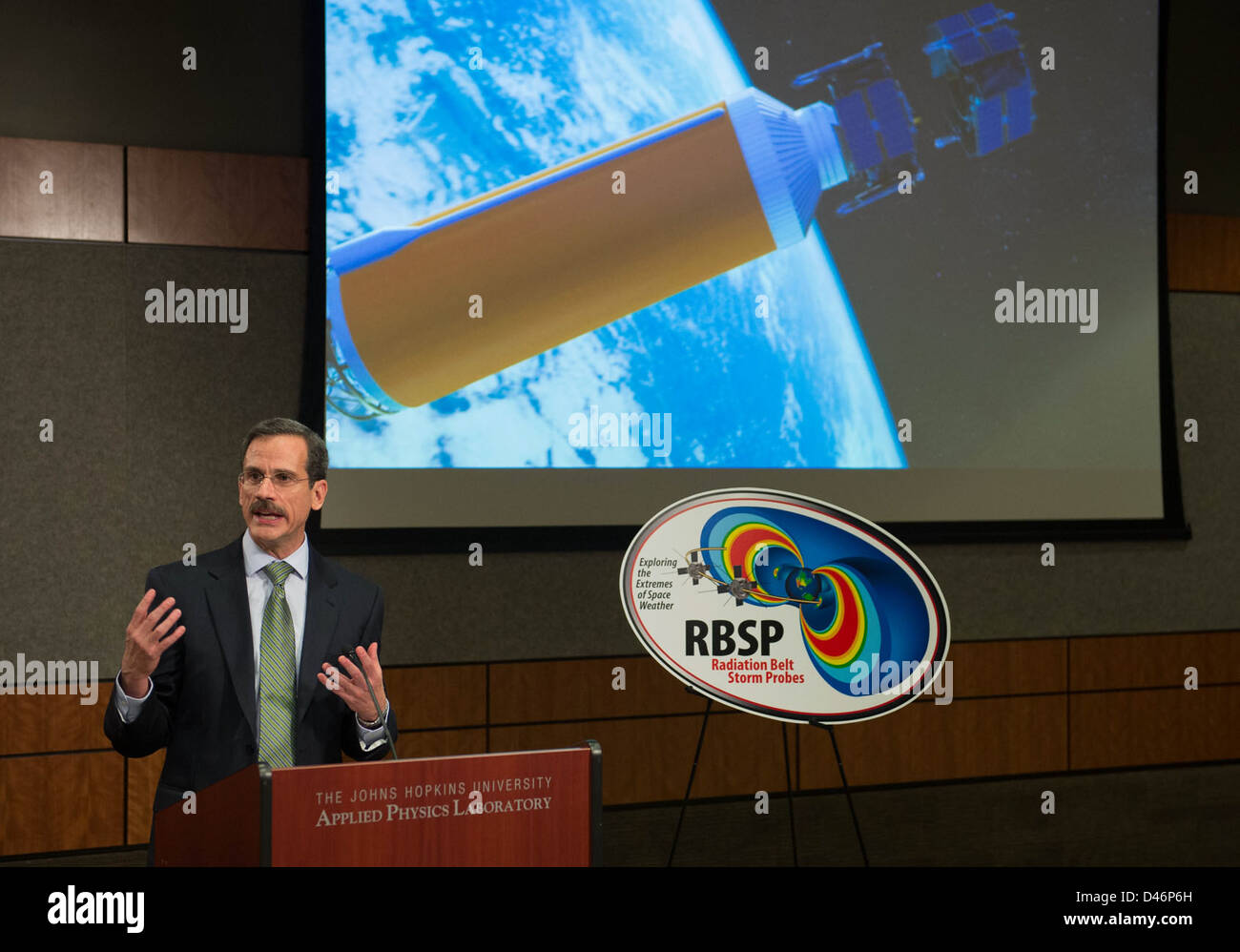 The Van Allen Probes, launched to study Earth's radiation belts, are named in honor of James Van Allen, the scientist who discovered the belts. The mission aims to deepen understanding of space weather and its effects on Earth. Stock Photohttps://www.alamy.com/image-license-details/?v=1https://www.alamy.com/stock-photo-the-van-allen-probes-launched-to-study-earths-radiation-belts-are-54238873.html
The Van Allen Probes, launched to study Earth's radiation belts, are named in honor of James Van Allen, the scientist who discovered the belts. The mission aims to deepen understanding of space weather and its effects on Earth. Stock Photohttps://www.alamy.com/image-license-details/?v=1https://www.alamy.com/stock-photo-the-van-allen-probes-launched-to-study-earths-radiation-belts-are-54238873.htmlRMD46P6H–The Van Allen Probes, launched to study Earth's radiation belts, are named in honor of James Van Allen, the scientist who discovered the belts. The mission aims to deepen understanding of space weather and its effects on Earth.
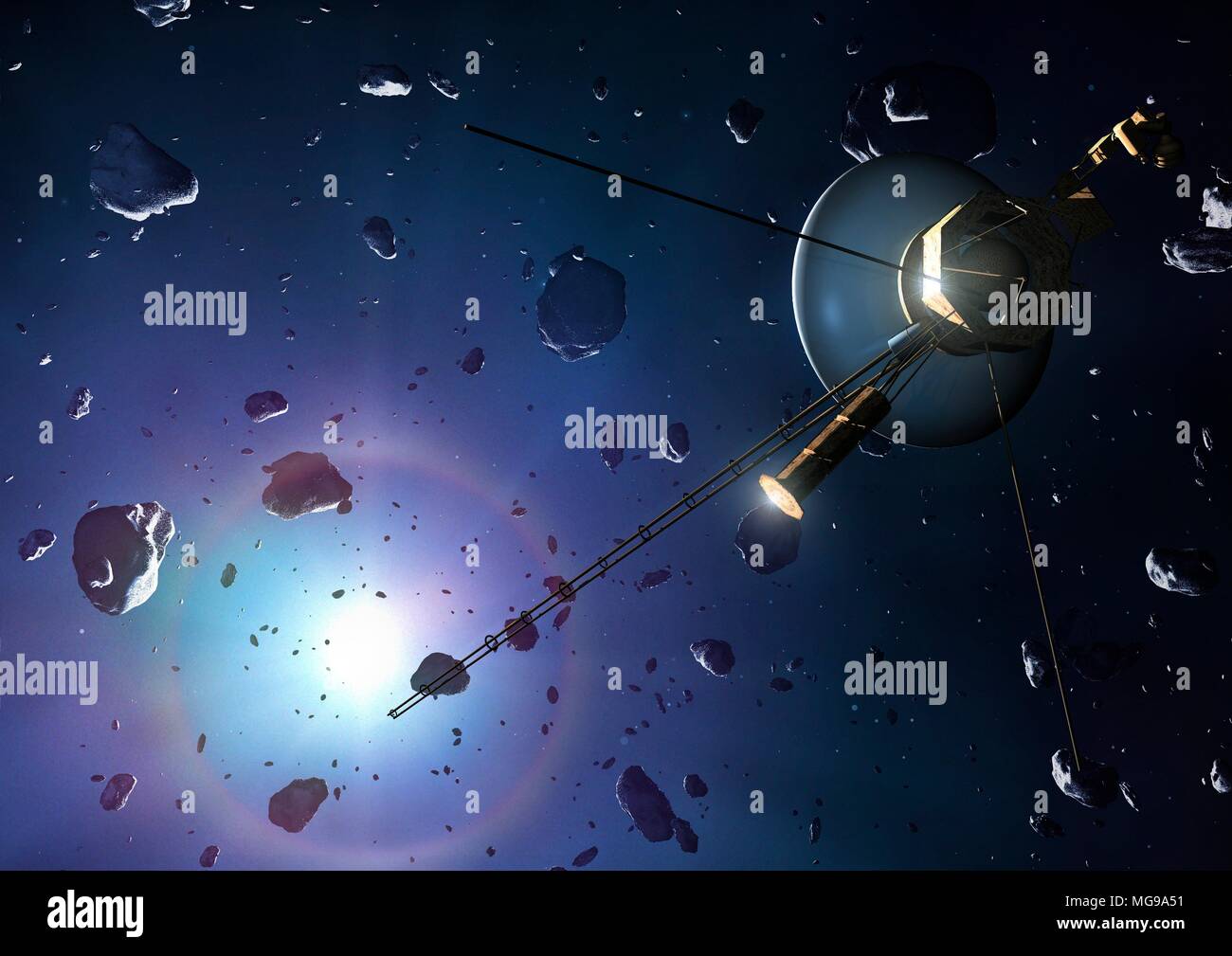 Illustration of a Voyager probe at the Oort cloud. The two Voyager probes were launched in late 1970s. Voyager 1 has now passed into interstellar space - beyond the influence of the Sun's magnetic field - and Voyager 2 is set to do so in the early 2020s. Some 300 years from now, the probes will enter the beginnings of the Oort cloud - a swarm of inert comet nuclei surrounding the Sun up to perhaps 50,000 astronomical units from it. The cloud is so vast that the probes are expected to take around 40,000 years to pass through it into clear space. Stock Photohttps://www.alamy.com/image-license-details/?v=1https://www.alamy.com/illustration-of-a-voyager-probe-at-the-oort-cloud-the-two-voyager-probes-were-launched-in-late-1970s-voyager-1-has-now-passed-into-interstellar-space-beyond-the-influence-of-the-suns-magnetic-field-and-voyager-2-is-set-to-do-so-in-the-early-2020s-some-300-years-from-now-the-probes-will-enter-the-beginnings-of-the-oort-cloud-a-swarm-of-inert-comet-nuclei-surrounding-the-sun-up-to-perhaps-50000-astronomical-units-from-it-the-cloud-is-so-vast-that-the-probes-are-expected-to-take-around-40000-years-to-pass-through-it-into-clear-space-image182143725.html
Illustration of a Voyager probe at the Oort cloud. The two Voyager probes were launched in late 1970s. Voyager 1 has now passed into interstellar space - beyond the influence of the Sun's magnetic field - and Voyager 2 is set to do so in the early 2020s. Some 300 years from now, the probes will enter the beginnings of the Oort cloud - a swarm of inert comet nuclei surrounding the Sun up to perhaps 50,000 astronomical units from it. The cloud is so vast that the probes are expected to take around 40,000 years to pass through it into clear space. Stock Photohttps://www.alamy.com/image-license-details/?v=1https://www.alamy.com/illustration-of-a-voyager-probe-at-the-oort-cloud-the-two-voyager-probes-were-launched-in-late-1970s-voyager-1-has-now-passed-into-interstellar-space-beyond-the-influence-of-the-suns-magnetic-field-and-voyager-2-is-set-to-do-so-in-the-early-2020s-some-300-years-from-now-the-probes-will-enter-the-beginnings-of-the-oort-cloud-a-swarm-of-inert-comet-nuclei-surrounding-the-sun-up-to-perhaps-50000-astronomical-units-from-it-the-cloud-is-so-vast-that-the-probes-are-expected-to-take-around-40000-years-to-pass-through-it-into-clear-space-image182143725.htmlRFMG9A51–Illustration of a Voyager probe at the Oort cloud. The two Voyager probes were launched in late 1970s. Voyager 1 has now passed into interstellar space - beyond the influence of the Sun's magnetic field - and Voyager 2 is set to do so in the early 2020s. Some 300 years from now, the probes will enter the beginnings of the Oort cloud - a swarm of inert comet nuclei surrounding the Sun up to perhaps 50,000 astronomical units from it. The cloud is so vast that the probes are expected to take around 40,000 years to pass through it into clear space.
 Spaceships traveling through galaxy, space probes passing through stars and nebulae, returning home, USA North America, sun rising behind. Stock Photohttps://www.alamy.com/image-license-details/?v=1https://www.alamy.com/spaceships-traveling-through-galaxy-space-probes-passing-through-stars-and-nebulae-returning-home-usa-north-america-sun-rising-behind-image472629165.html
Spaceships traveling through galaxy, space probes passing through stars and nebulae, returning home, USA North America, sun rising behind. Stock Photohttps://www.alamy.com/image-license-details/?v=1https://www.alamy.com/spaceships-traveling-through-galaxy-space-probes-passing-through-stars-and-nebulae-returning-home-usa-north-america-sun-rising-behind-image472629165.htmlRF2JCX391–Spaceships traveling through galaxy, space probes passing through stars and nebulae, returning home, USA North America, sun rising behind.
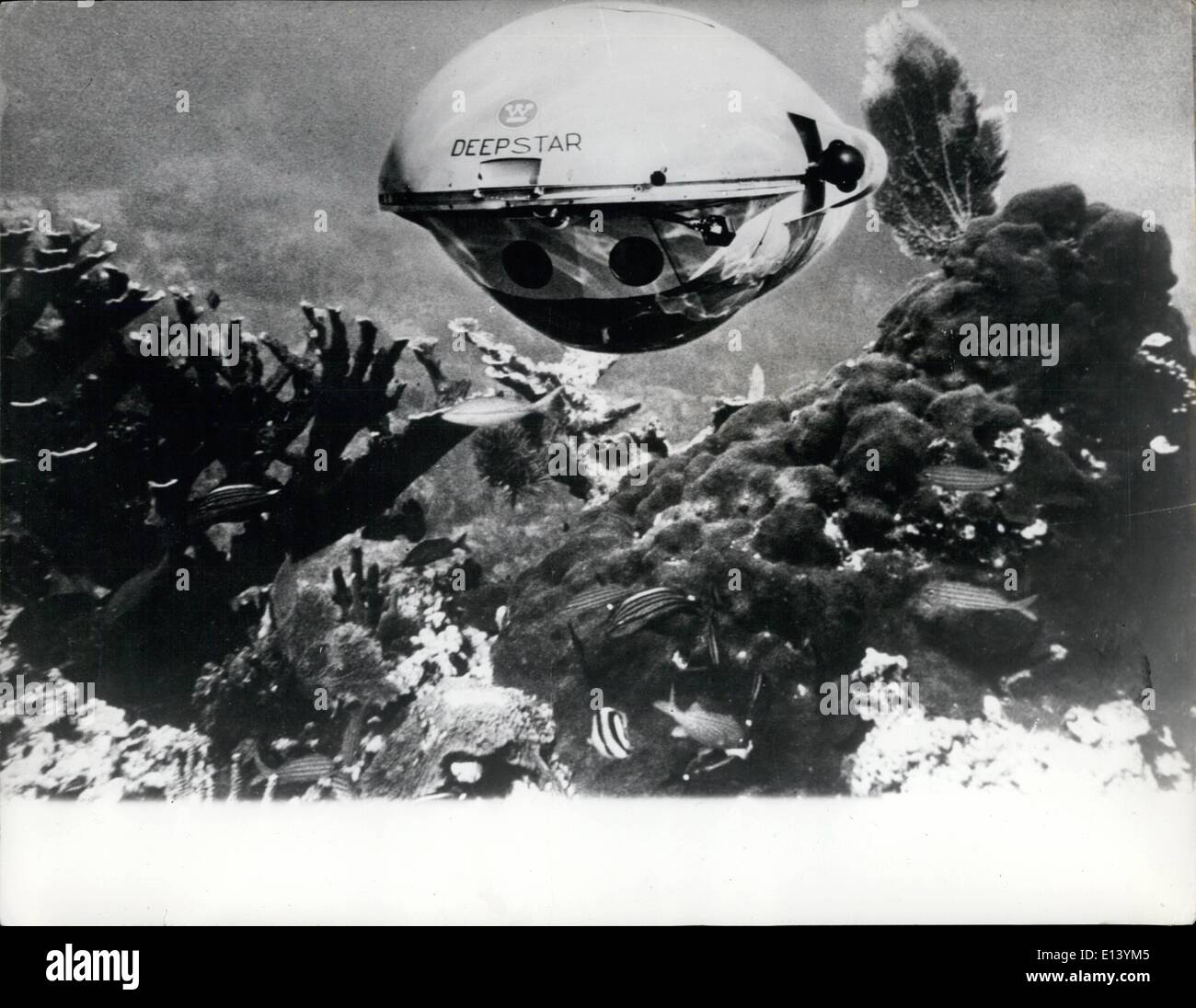 Mar. 27, 2012 - ''Flying Saucer'' For Inner Space: While Astronaut are achieving great progress in outer space - underwater aquanauts are making marked progress with new underwater vehicles. Resembling a flying saucer this submarine called a Westinghouse Deepstar II has been on trials to prove its depth capability of 4,000ft. It is shaped so as to withstand pressures at great depths. Increased emphasis is being placed on the development of more efficient U.S. Underwater vehicles for recover probes such as the submerged H Bomb off the coast of Southren Spain Stock Photohttps://www.alamy.com/image-license-details/?v=1https://www.alamy.com/mar-27-2012-flying-saucer-for-inner-space-while-astronaut-are-achieving-image69543717.html
Mar. 27, 2012 - ''Flying Saucer'' For Inner Space: While Astronaut are achieving great progress in outer space - underwater aquanauts are making marked progress with new underwater vehicles. Resembling a flying saucer this submarine called a Westinghouse Deepstar II has been on trials to prove its depth capability of 4,000ft. It is shaped so as to withstand pressures at great depths. Increased emphasis is being placed on the development of more efficient U.S. Underwater vehicles for recover probes such as the submerged H Bomb off the coast of Southren Spain Stock Photohttps://www.alamy.com/image-license-details/?v=1https://www.alamy.com/mar-27-2012-flying-saucer-for-inner-space-while-astronaut-are-achieving-image69543717.htmlRME13YM5–Mar. 27, 2012 - ''Flying Saucer'' For Inner Space: While Astronaut are achieving great progress in outer space - underwater aquanauts are making marked progress with new underwater vehicles. Resembling a flying saucer this submarine called a Westinghouse Deepstar II has been on trials to prove its depth capability of 4,000ft. It is shaped so as to withstand pressures at great depths. Increased emphasis is being placed on the development of more efficient U.S. Underwater vehicles for recover probes such as the submerged H Bomb off the coast of Southren Spain
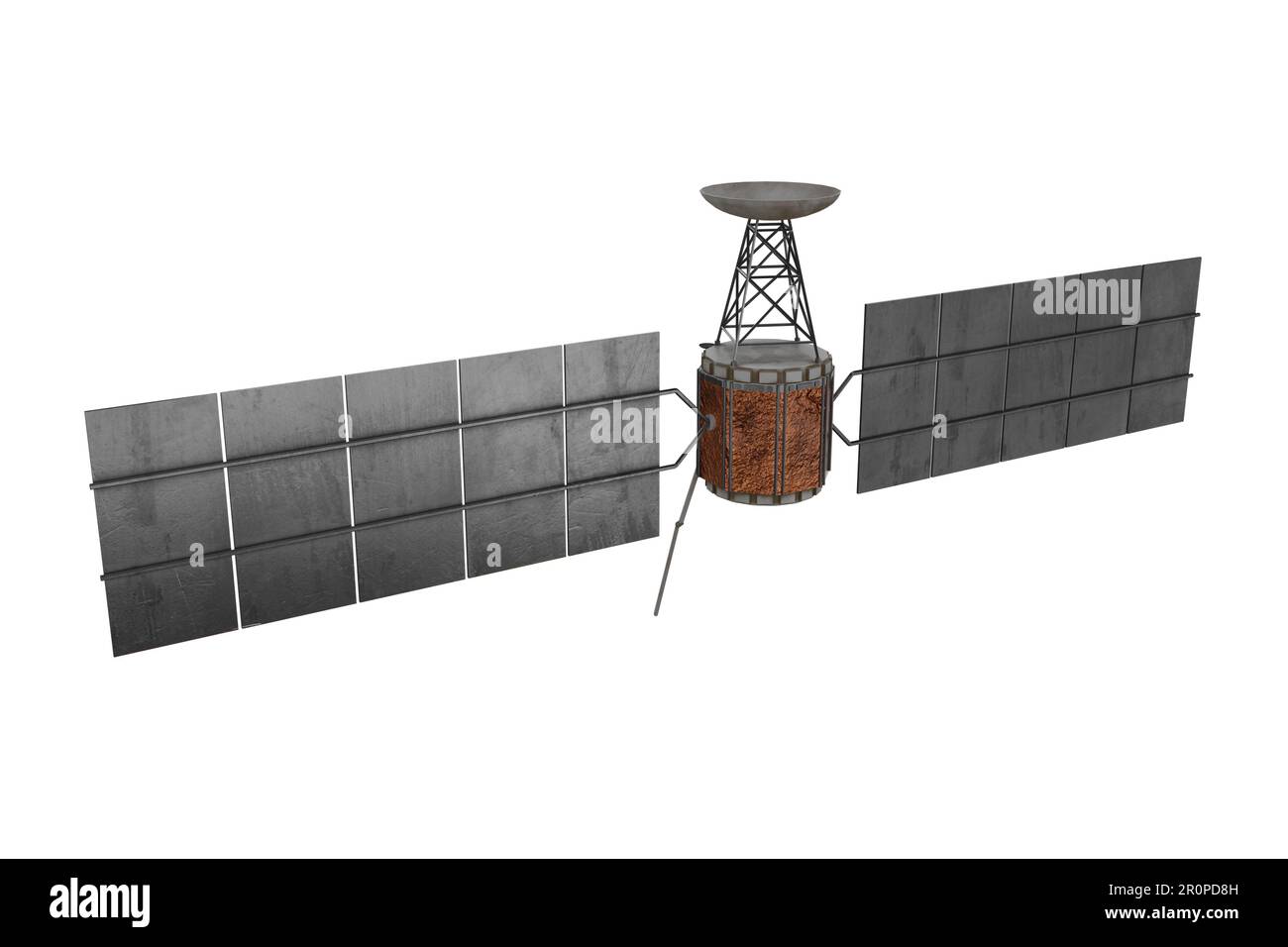 3d rendering space satellite with realistic solar panel Stock Photohttps://www.alamy.com/image-license-details/?v=1https://www.alamy.com/3d-rendering-space-satellite-with-realistic-solar-panel-image551225153.html
3d rendering space satellite with realistic solar panel Stock Photohttps://www.alamy.com/image-license-details/?v=1https://www.alamy.com/3d-rendering-space-satellite-with-realistic-solar-panel-image551225153.htmlRF2R0PD8H–3d rendering space satellite with realistic solar panel
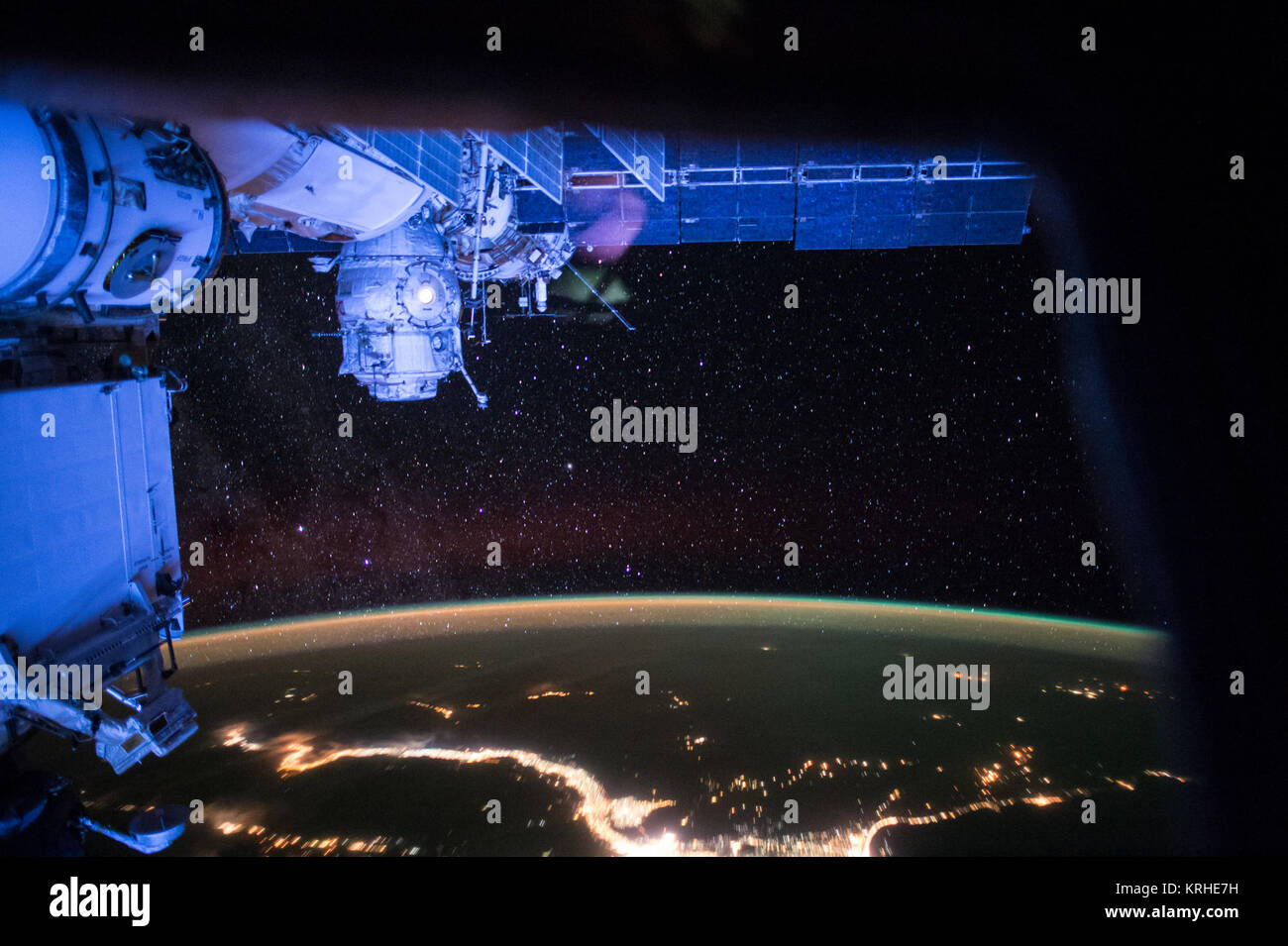 ISS-43 Night view from the International Space Station Stock Photohttps://www.alamy.com/image-license-details/?v=1https://www.alamy.com/stock-image-iss-43-night-view-from-the-international-space-station-169414773.html
ISS-43 Night view from the International Space Station Stock Photohttps://www.alamy.com/image-license-details/?v=1https://www.alamy.com/stock-image-iss-43-night-view-from-the-international-space-station-169414773.htmlRMKRHE7H–ISS-43 Night view from the International Space Station
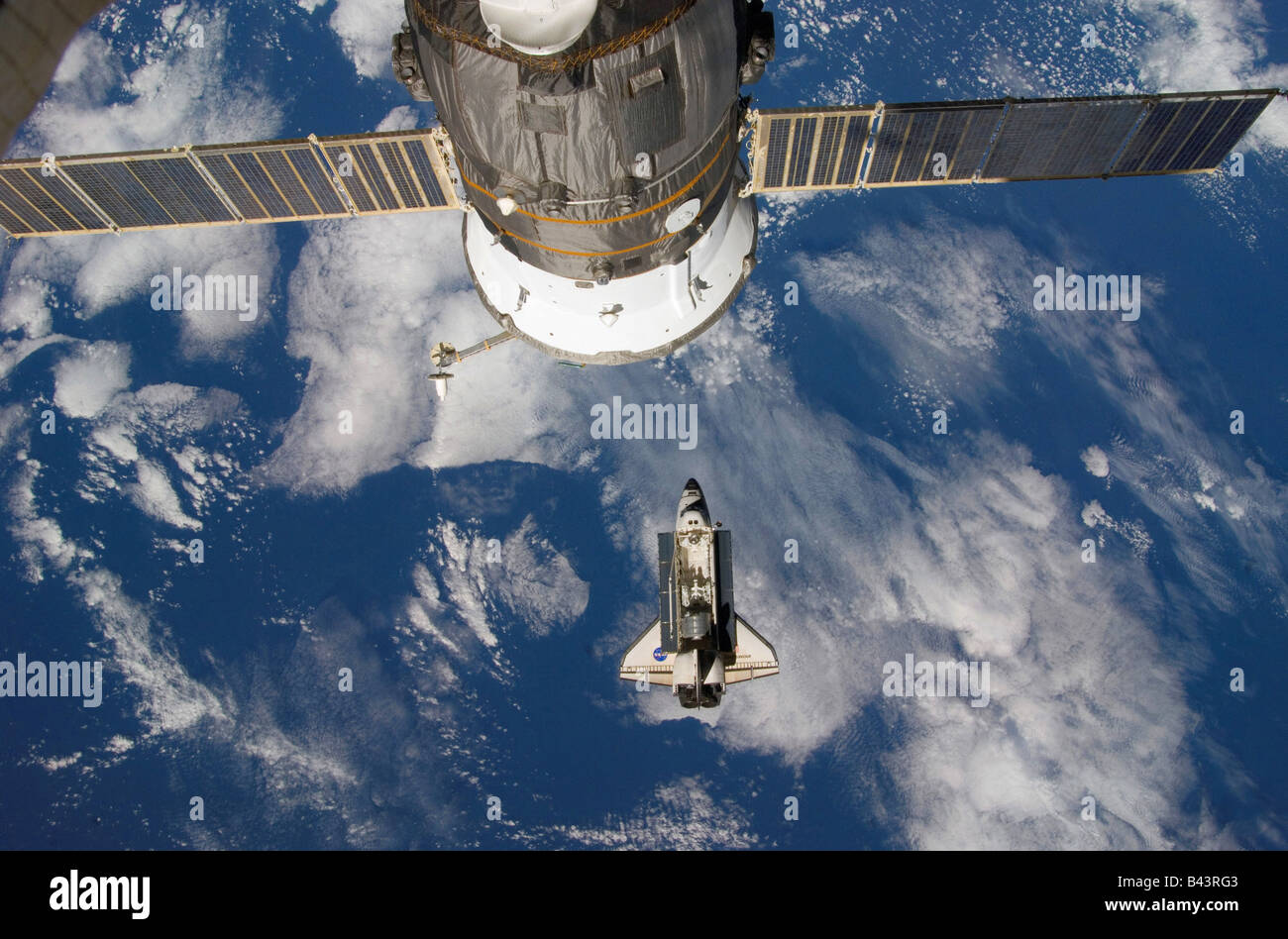 International Space Station 123 Shuttle Endeavor March 12 2008 Stock Photohttps://www.alamy.com/image-license-details/?v=1https://www.alamy.com/stock-photo-international-space-station-123-shuttle-endeavor-march-12-2008-19753331.html
International Space Station 123 Shuttle Endeavor March 12 2008 Stock Photohttps://www.alamy.com/image-license-details/?v=1https://www.alamy.com/stock-photo-international-space-station-123-shuttle-endeavor-march-12-2008-19753331.htmlRFB43RG3–International Space Station 123 Shuttle Endeavor March 12 2008
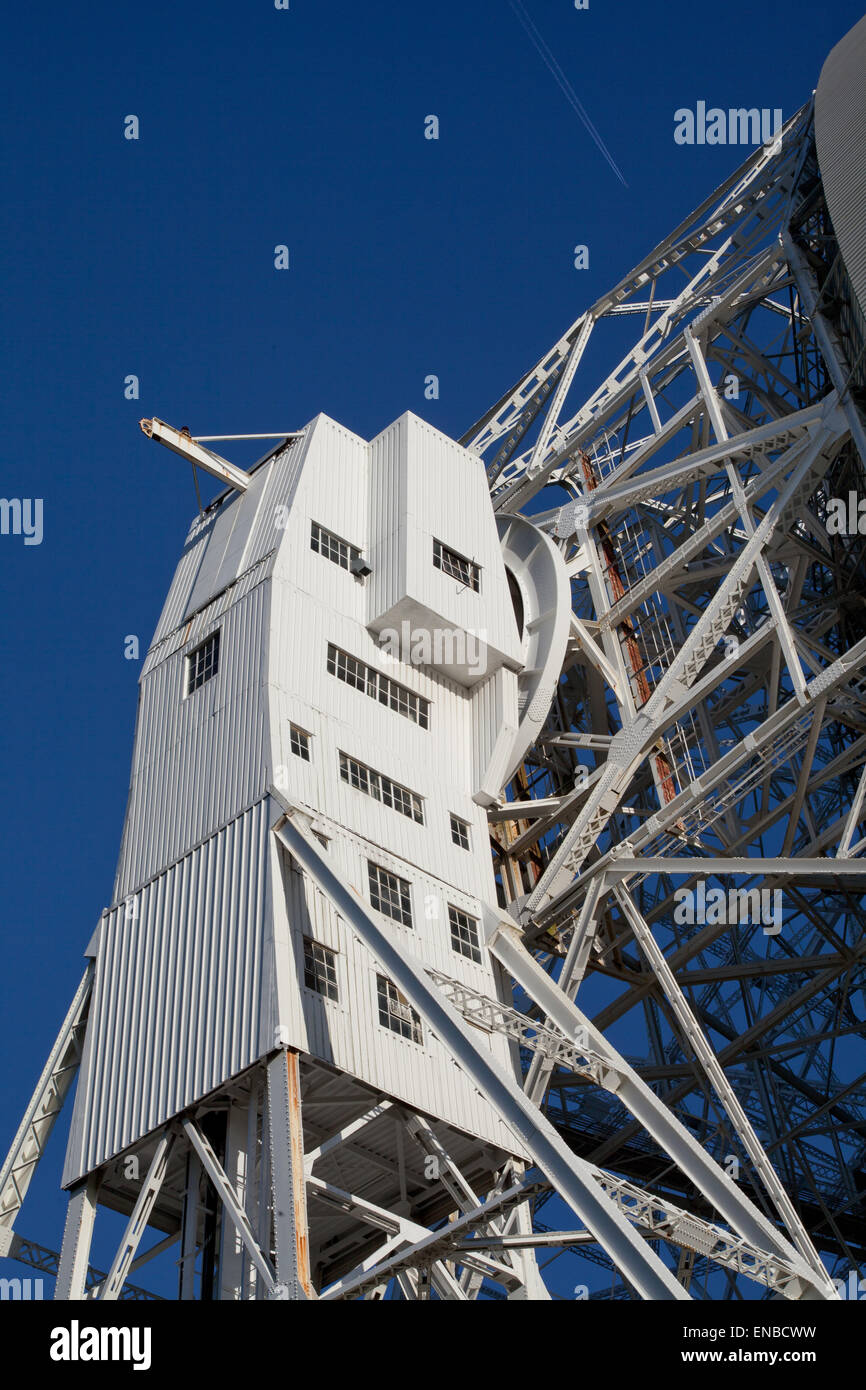 Jodrell Bank Stock Photohttps://www.alamy.com/image-license-details/?v=1https://www.alamy.com/stock-photo-jodrell-bank-82000853.html
Jodrell Bank Stock Photohttps://www.alamy.com/image-license-details/?v=1https://www.alamy.com/stock-photo-jodrell-bank-82000853.htmlRMENBCWW–Jodrell Bank
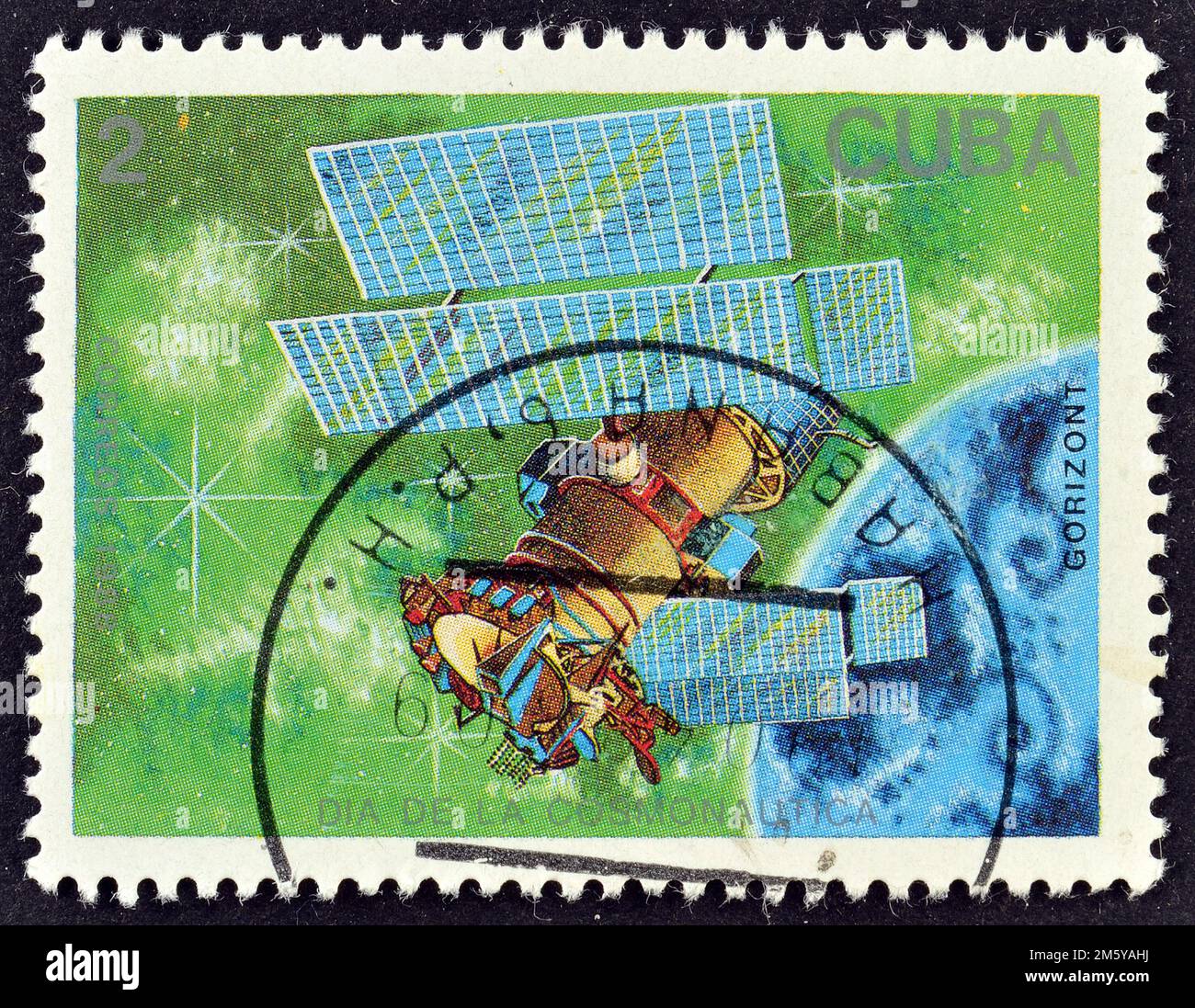 Cancelled postage stamp printed by Cuba, that shows Satellite Horizon, Satellites and Space Probes, circa 1988. Stock Photohttps://www.alamy.com/image-license-details/?v=1https://www.alamy.com/cancelled-postage-stamp-printed-by-cuba-that-shows-satellite-horizon-satellites-and-space-probes-circa-1988-image502774990.html
Cancelled postage stamp printed by Cuba, that shows Satellite Horizon, Satellites and Space Probes, circa 1988. Stock Photohttps://www.alamy.com/image-license-details/?v=1https://www.alamy.com/cancelled-postage-stamp-printed-by-cuba-that-shows-satellite-horizon-satellites-and-space-probes-circa-1988-image502774990.htmlRM2M5YAHJ–Cancelled postage stamp printed by Cuba, that shows Satellite Horizon, Satellites and Space Probes, circa 1988.
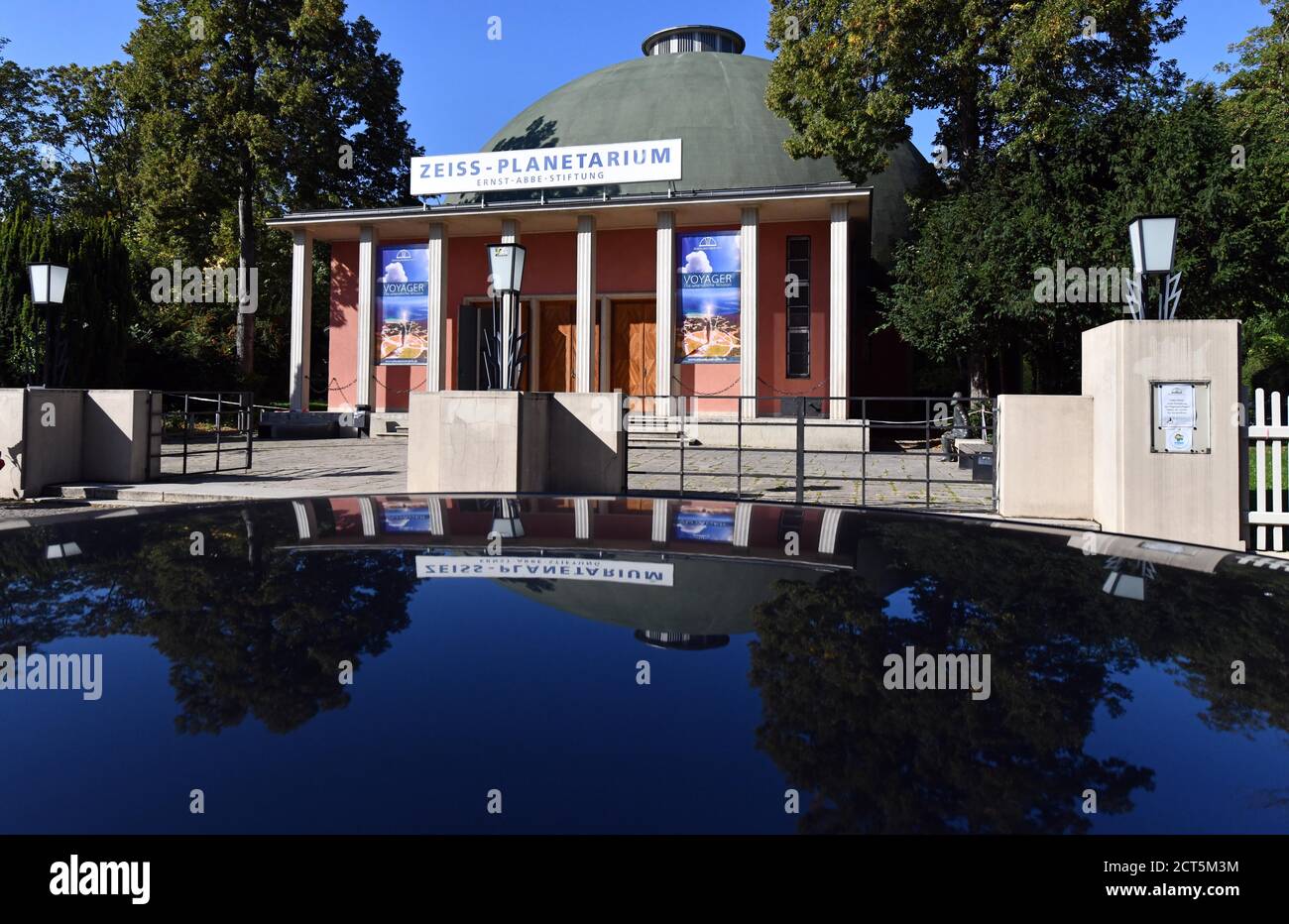 Jena, Germany. 21st Sep, 2020. The Zeiss Planetarium Jena is reflected on the roof of a car. From 23 September, the new programme 'Voyager - The Infinite Mission' will offer visitors images of the outermost planets of the solar system and their moons, taken by the US space probes Voyager 1 and 2. The planetarium had to close for almost three months in spring because of the Corona pandemic. It has only been receiving visitors again since 9 June. Credit: Martin Schutt/dpa-Zentralbild/dpa/Alamy Live News Stock Photohttps://www.alamy.com/image-license-details/?v=1https://www.alamy.com/jena-germany-21st-sep-2020-the-zeiss-planetarium-jena-is-reflected-on-the-roof-of-a-car-from-23-september-the-new-programme-voyager-the-infinite-mission-will-offer-visitors-images-of-the-outermost-planets-of-the-solar-system-and-their-moons-taken-by-the-us-space-probes-voyager-1-and-2-the-planetarium-had-to-close-for-almost-three-months-in-spring-because-of-the-corona-pandemic-it-has-only-been-receiving-visitors-again-since-9-june-credit-martin-schuttdpa-zentralbilddpaalamy-live-news-image376295016.html
Jena, Germany. 21st Sep, 2020. The Zeiss Planetarium Jena is reflected on the roof of a car. From 23 September, the new programme 'Voyager - The Infinite Mission' will offer visitors images of the outermost planets of the solar system and their moons, taken by the US space probes Voyager 1 and 2. The planetarium had to close for almost three months in spring because of the Corona pandemic. It has only been receiving visitors again since 9 June. Credit: Martin Schutt/dpa-Zentralbild/dpa/Alamy Live News Stock Photohttps://www.alamy.com/image-license-details/?v=1https://www.alamy.com/jena-germany-21st-sep-2020-the-zeiss-planetarium-jena-is-reflected-on-the-roof-of-a-car-from-23-september-the-new-programme-voyager-the-infinite-mission-will-offer-visitors-images-of-the-outermost-planets-of-the-solar-system-and-their-moons-taken-by-the-us-space-probes-voyager-1-and-2-the-planetarium-had-to-close-for-almost-three-months-in-spring-because-of-the-corona-pandemic-it-has-only-been-receiving-visitors-again-since-9-june-credit-martin-schuttdpa-zentralbilddpaalamy-live-news-image376295016.htmlRM2CT5M3M–Jena, Germany. 21st Sep, 2020. The Zeiss Planetarium Jena is reflected on the roof of a car. From 23 September, the new programme 'Voyager - The Infinite Mission' will offer visitors images of the outermost planets of the solar system and their moons, taken by the US space probes Voyager 1 and 2. The planetarium had to close for almost three months in spring because of the Corona pandemic. It has only been receiving visitors again since 9 June. Credit: Martin Schutt/dpa-Zentralbild/dpa/Alamy Live News
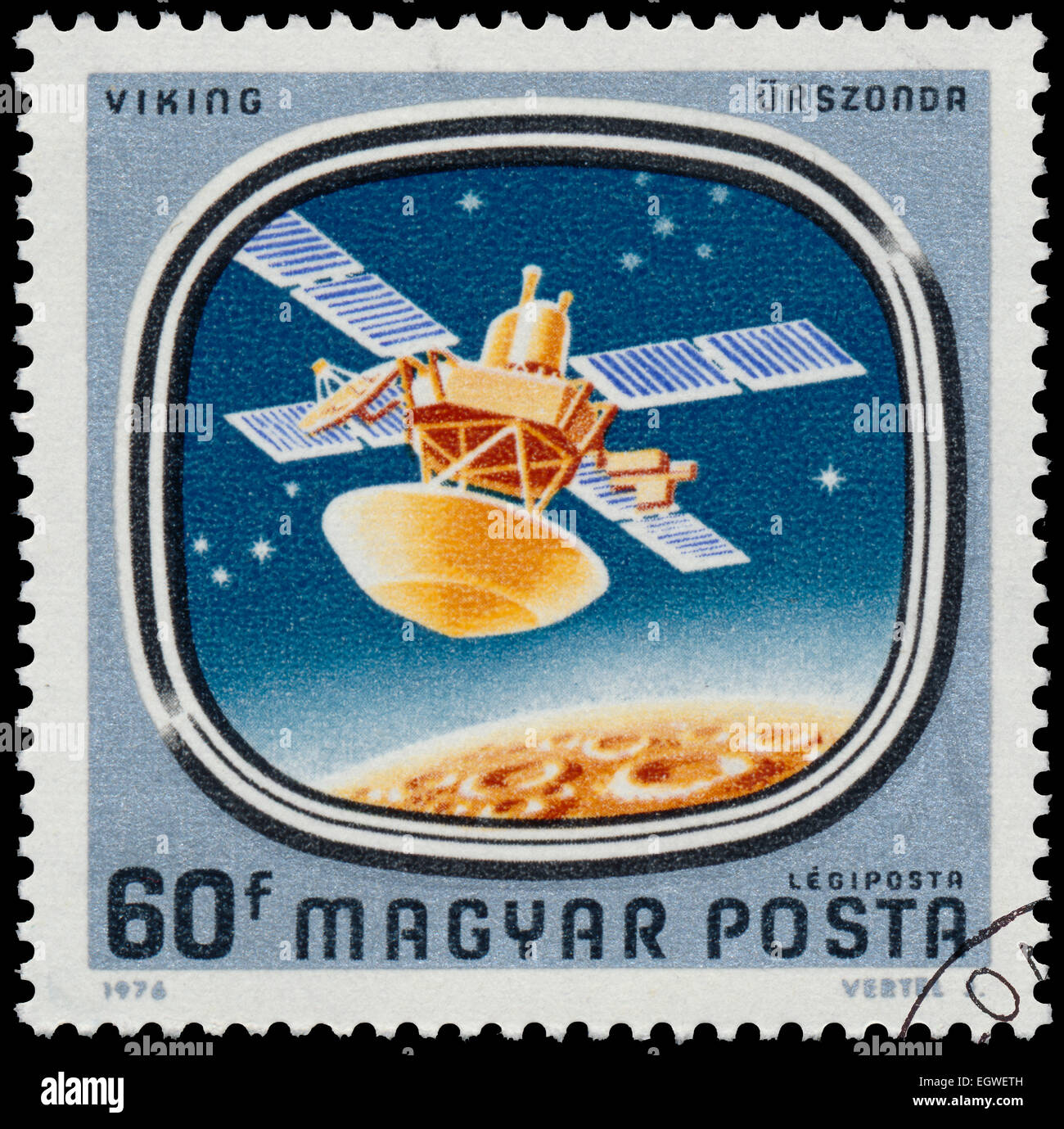 HUNGARY - CIRCA 1976: Stamp printed in Hungary shows Viking, with the same inscription, from the series 'Space Probes to Mars an Stock Photohttps://www.alamy.com/image-license-details/?v=1https://www.alamy.com/stock-photo-hungary-circa-1976-stamp-printed-in-hungary-shows-viking-with-the-79236433.html
HUNGARY - CIRCA 1976: Stamp printed in Hungary shows Viking, with the same inscription, from the series 'Space Probes to Mars an Stock Photohttps://www.alamy.com/image-license-details/?v=1https://www.alamy.com/stock-photo-hungary-circa-1976-stamp-printed-in-hungary-shows-viking-with-the-79236433.htmlRFEGWETH–HUNGARY - CIRCA 1976: Stamp printed in Hungary shows Viking, with the same inscription, from the series 'Space Probes to Mars an
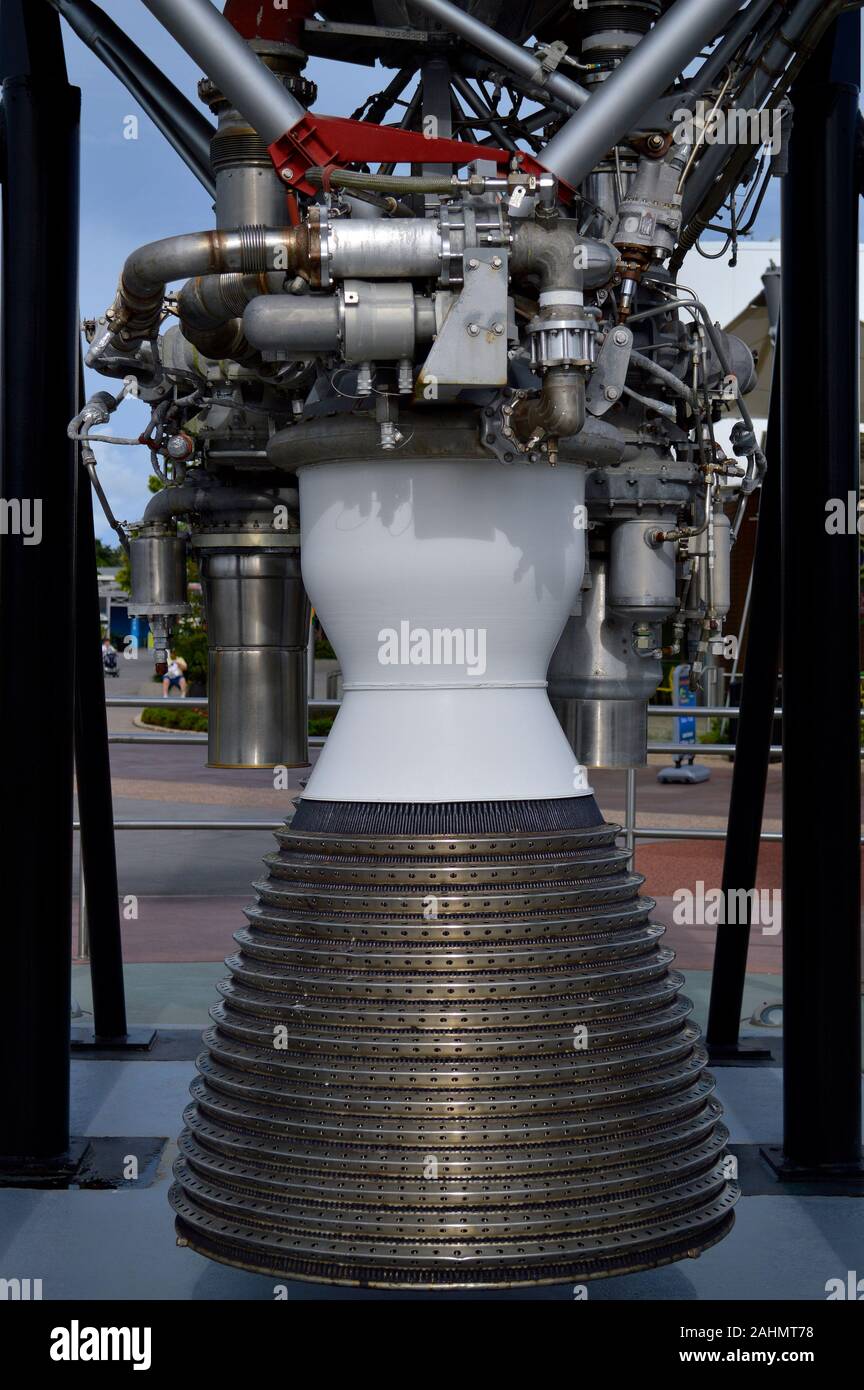 Apollo F1 Engine on display at Kennedy Space Centre in Florida Stock Photohttps://www.alamy.com/image-license-details/?v=1https://www.alamy.com/apollo-f1-engine-on-display-at-kennedy-space-centre-in-florida-image337904204.html
Apollo F1 Engine on display at Kennedy Space Centre in Florida Stock Photohttps://www.alamy.com/image-license-details/?v=1https://www.alamy.com/apollo-f1-engine-on-display-at-kennedy-space-centre-in-florida-image337904204.htmlRF2AHMT78–Apollo F1 Engine on display at Kennedy Space Centre in Florida
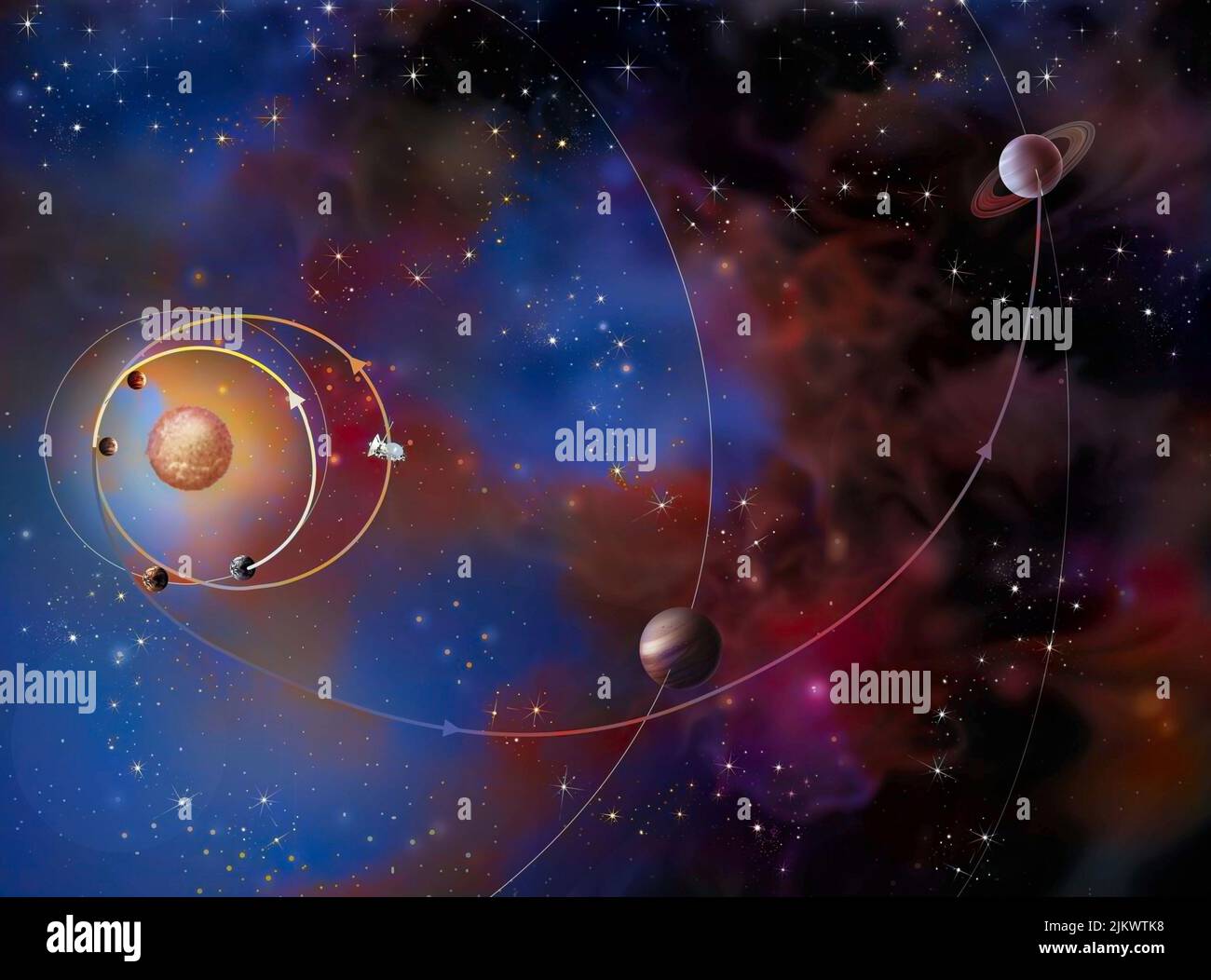 Trajectory of the Cassini probe from Earth to Saturn. Stock Photohttps://www.alamy.com/image-license-details/?v=1https://www.alamy.com/trajectory-of-the-cassini-probe-from-earth-to-saturn-image476926556.html
Trajectory of the Cassini probe from Earth to Saturn. Stock Photohttps://www.alamy.com/image-license-details/?v=1https://www.alamy.com/trajectory-of-the-cassini-probe-from-earth-to-saturn-image476926556.htmlRF2JKWTK8–Trajectory of the Cassini probe from Earth to Saturn.
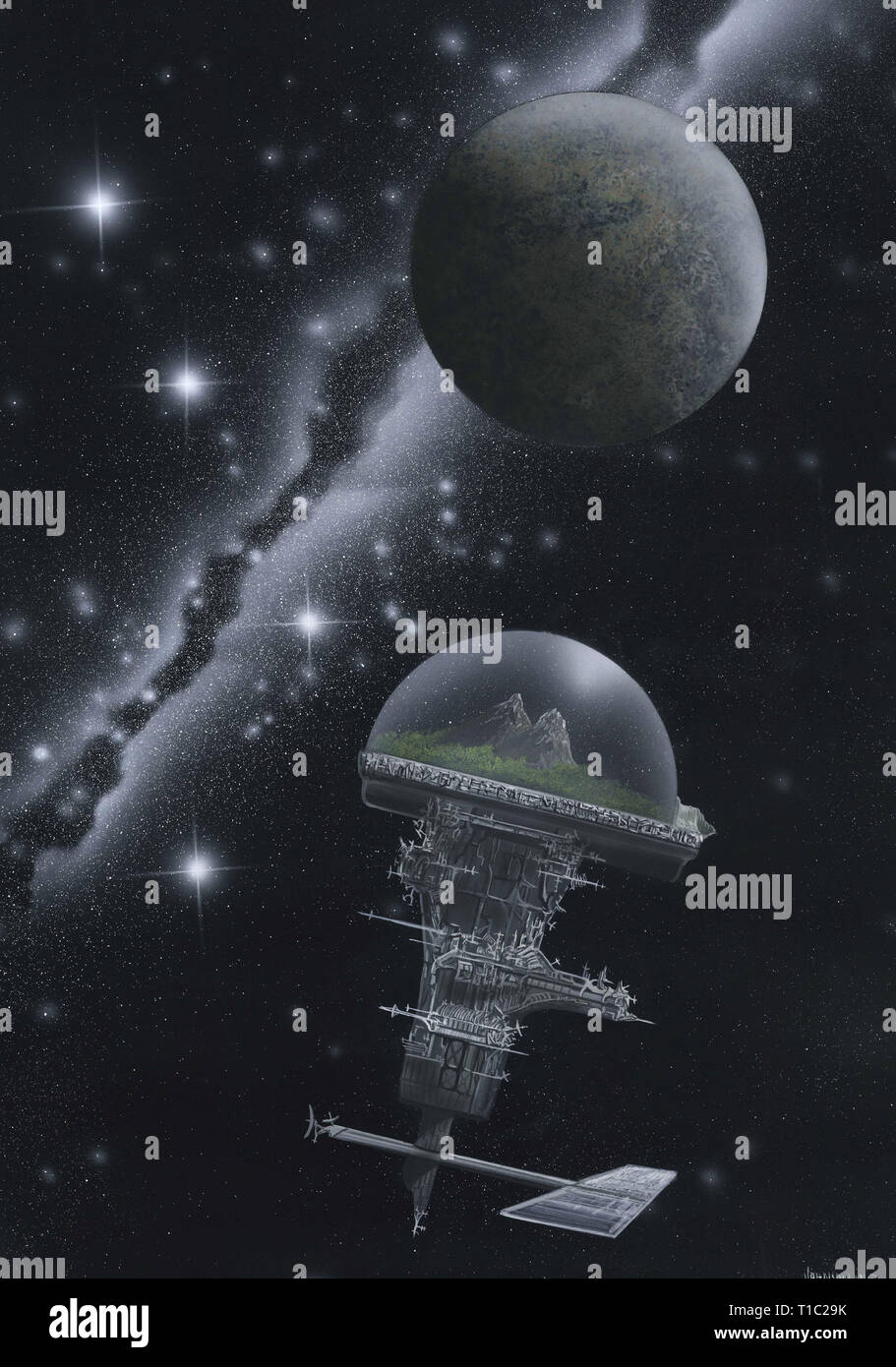 Earth hangs in the background void of water and baron. A giant craft leaves Earth to find a new planet. Stock Photohttps://www.alamy.com/image-license-details/?v=1https://www.alamy.com/earth-hangs-in-the-background-void-of-water-and-baron-a-giant-craft-leaves-earth-to-find-a-new-planet-image241825071.html
Earth hangs in the background void of water and baron. A giant craft leaves Earth to find a new planet. Stock Photohttps://www.alamy.com/image-license-details/?v=1https://www.alamy.com/earth-hangs-in-the-background-void-of-water-and-baron-a-giant-craft-leaves-earth-to-find-a-new-planet-image241825071.htmlRMT1C29K–Earth hangs in the background void of water and baron. A giant craft leaves Earth to find a new planet.
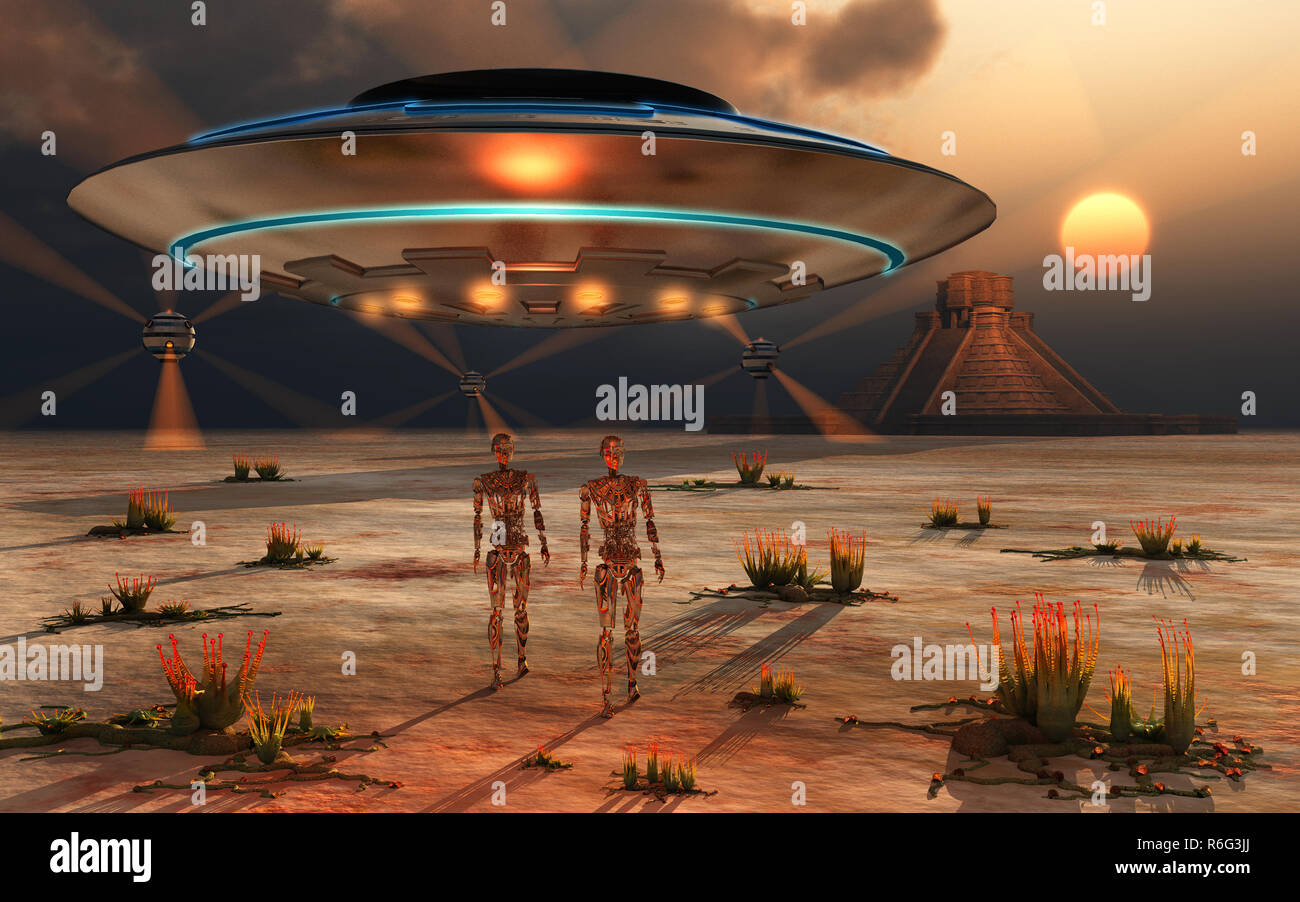 Robotic Time & Space Travellers Stock Photohttps://www.alamy.com/image-license-details/?v=1https://www.alamy.com/robotic-time-space-travellers-image227776826.html
Robotic Time & Space Travellers Stock Photohttps://www.alamy.com/image-license-details/?v=1https://www.alamy.com/robotic-time-space-travellers-image227776826.htmlRMR6G3JJ–Robotic Time & Space Travellers
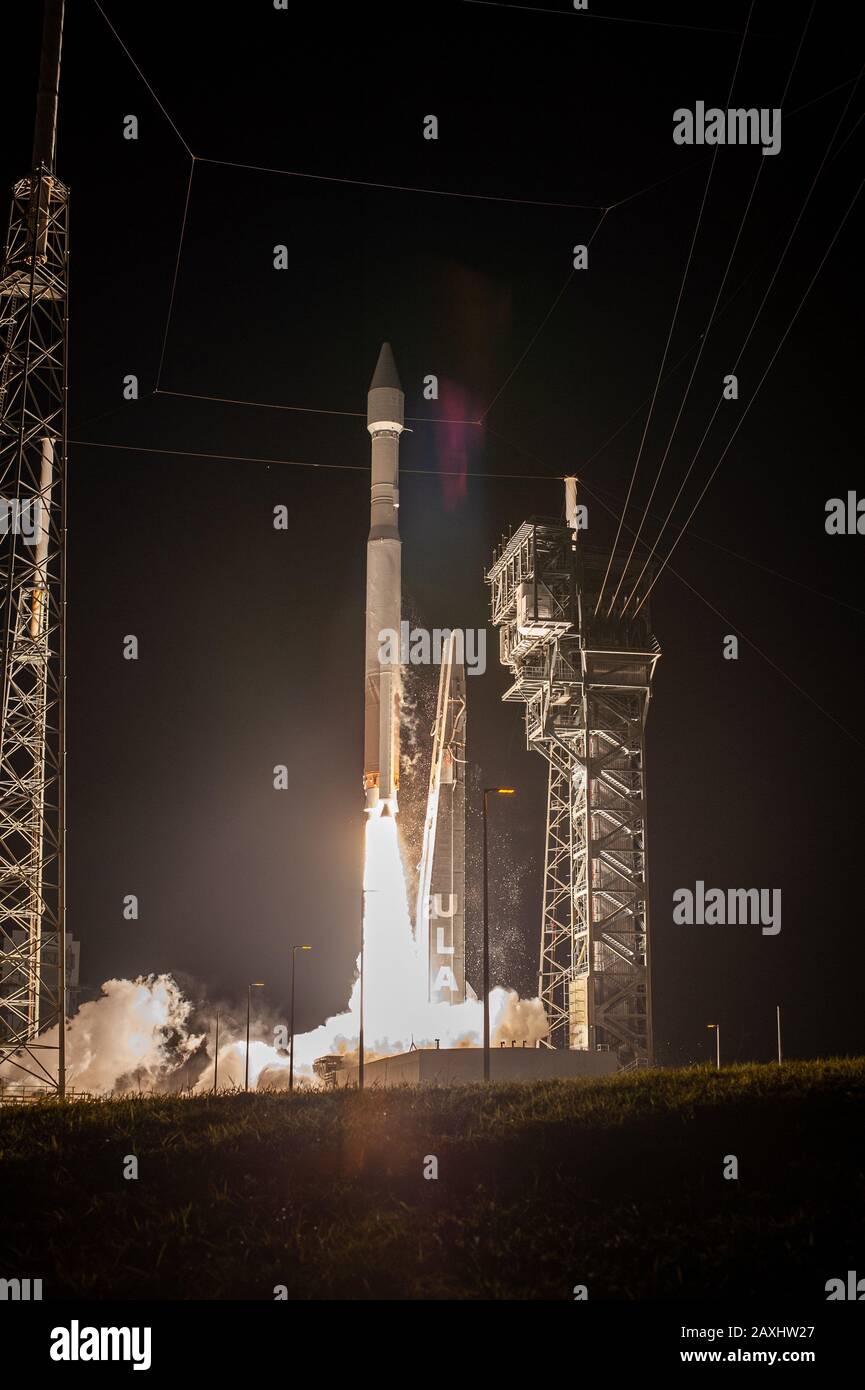 CAPE CANAVERAL, USA - 9 Feb 2020 - The United Launch Alliance Atlas V rocket, carrying the Solar Orbiter, lifts off Space Launch Complex 41 at Cape Ca Stock Photohttps://www.alamy.com/image-license-details/?v=1https://www.alamy.com/cape-canaveral-usa-9-feb-2020-the-united-launch-alliance-atlas-v-rocket-carrying-the-solar-orbiter-lifts-off-space-launch-complex-41-at-cape-ca-image343370895.html
CAPE CANAVERAL, USA - 9 Feb 2020 - The United Launch Alliance Atlas V rocket, carrying the Solar Orbiter, lifts off Space Launch Complex 41 at Cape Ca Stock Photohttps://www.alamy.com/image-license-details/?v=1https://www.alamy.com/cape-canaveral-usa-9-feb-2020-the-united-launch-alliance-atlas-v-rocket-carrying-the-solar-orbiter-lifts-off-space-launch-complex-41-at-cape-ca-image343370895.htmlRM2AXHW27–CAPE CANAVERAL, USA - 9 Feb 2020 - The United Launch Alliance Atlas V rocket, carrying the Solar Orbiter, lifts off Space Launch Complex 41 at Cape Ca
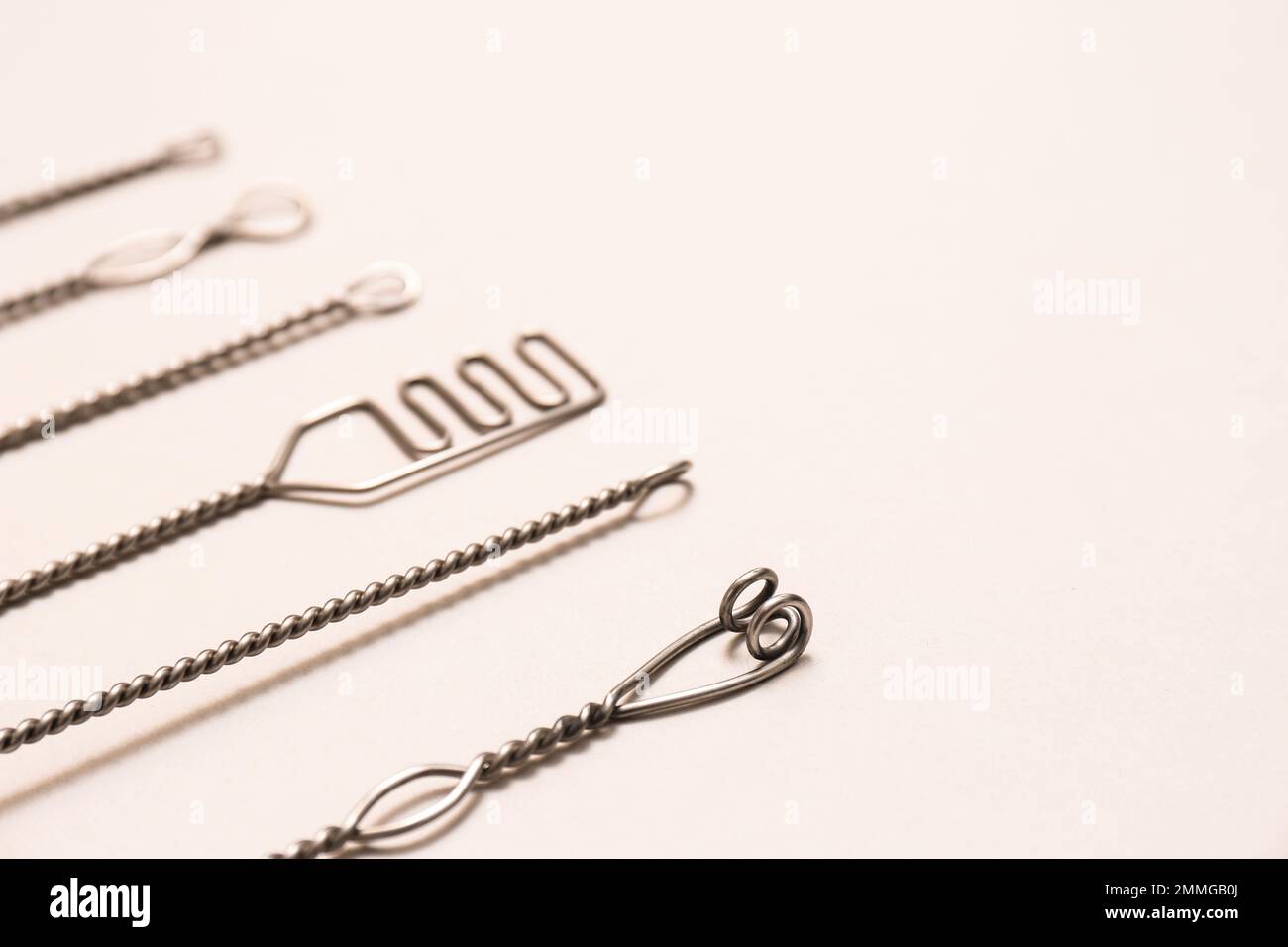 Set of logopedic probes for speech therapy on beige background. Space for text Stock Photohttps://www.alamy.com/image-license-details/?v=1https://www.alamy.com/set-of-logopedic-probes-for-speech-therapy-on-beige-background-space-for-text-image511753666.html
Set of logopedic probes for speech therapy on beige background. Space for text Stock Photohttps://www.alamy.com/image-license-details/?v=1https://www.alamy.com/set-of-logopedic-probes-for-speech-therapy-on-beige-background-space-for-text-image511753666.htmlRF2MMGB0J–Set of logopedic probes for speech therapy on beige background. Space for text
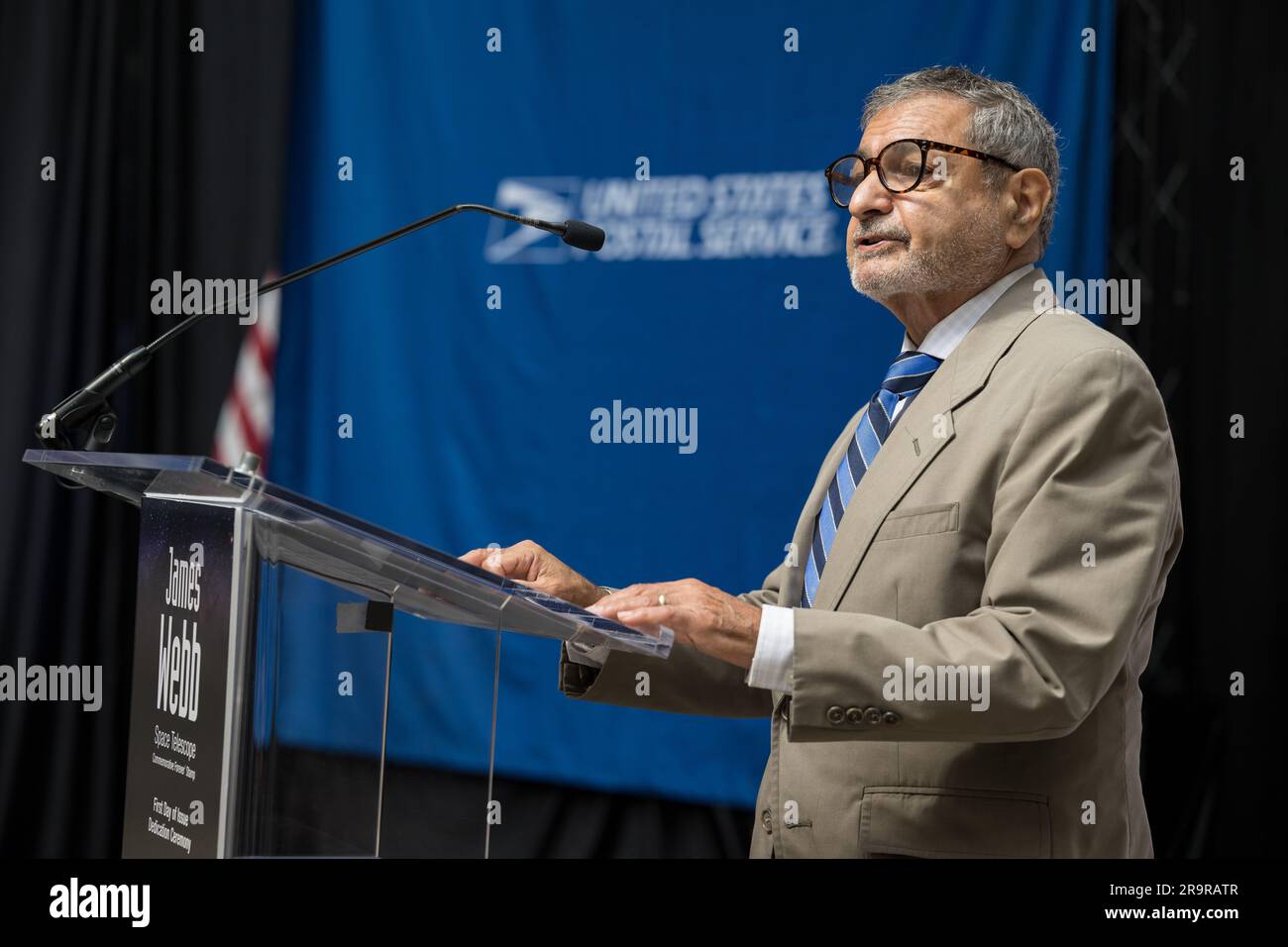 JWST Stamp Issuance Ceremony. United States Postal Service Vice Chairman, Board of Governors, Anton Hajjar, provides remarks at the first-day-of-issue event for the United States Postal Service’s new stamp celebrating NASA’s James Webb Space Telescope (JWST) on Thursday, Sept. 8, 2022, at the Smithsonian’s National Postal Museum in Washington. The stamp, which features an illustration of the observatory, honors Webb’s mission to explore the unknown in our universe – solving mysteries in our solar system, looking beyond to distant worlds around other stars, and probing the structures and origin Stock Photohttps://www.alamy.com/image-license-details/?v=1https://www.alamy.com/jwst-stamp-issuance-ceremony-united-states-postal-service-vice-chairman-board-of-governors-anton-hajjar-provides-remarks-at-the-first-day-of-issue-event-for-the-united-states-postal-services-new-stamp-celebrating-nasas-james-webb-space-telescope-jwst-on-thursday-sept-8-2022-at-the-smithsonians-national-postal-museum-in-washington-the-stamp-which-features-an-illustration-of-the-observatory-honors-webbs-mission-to-explore-the-unknown-in-our-universe-solving-mysteries-in-our-solar-system-looking-beyond-to-distant-worlds-around-other-stars-and-probing-the-structures-and-origin-image556777111.html
JWST Stamp Issuance Ceremony. United States Postal Service Vice Chairman, Board of Governors, Anton Hajjar, provides remarks at the first-day-of-issue event for the United States Postal Service’s new stamp celebrating NASA’s James Webb Space Telescope (JWST) on Thursday, Sept. 8, 2022, at the Smithsonian’s National Postal Museum in Washington. The stamp, which features an illustration of the observatory, honors Webb’s mission to explore the unknown in our universe – solving mysteries in our solar system, looking beyond to distant worlds around other stars, and probing the structures and origin Stock Photohttps://www.alamy.com/image-license-details/?v=1https://www.alamy.com/jwst-stamp-issuance-ceremony-united-states-postal-service-vice-chairman-board-of-governors-anton-hajjar-provides-remarks-at-the-first-day-of-issue-event-for-the-united-states-postal-services-new-stamp-celebrating-nasas-james-webb-space-telescope-jwst-on-thursday-sept-8-2022-at-the-smithsonians-national-postal-museum-in-washington-the-stamp-which-features-an-illustration-of-the-observatory-honors-webbs-mission-to-explore-the-unknown-in-our-universe-solving-mysteries-in-our-solar-system-looking-beyond-to-distant-worlds-around-other-stars-and-probing-the-structures-and-origin-image556777111.htmlRM2R9RATR–JWST Stamp Issuance Ceremony. United States Postal Service Vice Chairman, Board of Governors, Anton Hajjar, provides remarks at the first-day-of-issue event for the United States Postal Service’s new stamp celebrating NASA’s James Webb Space Telescope (JWST) on Thursday, Sept. 8, 2022, at the Smithsonian’s National Postal Museum in Washington. The stamp, which features an illustration of the observatory, honors Webb’s mission to explore the unknown in our universe – solving mysteries in our solar system, looking beyond to distant worlds around other stars, and probing the structures and origin
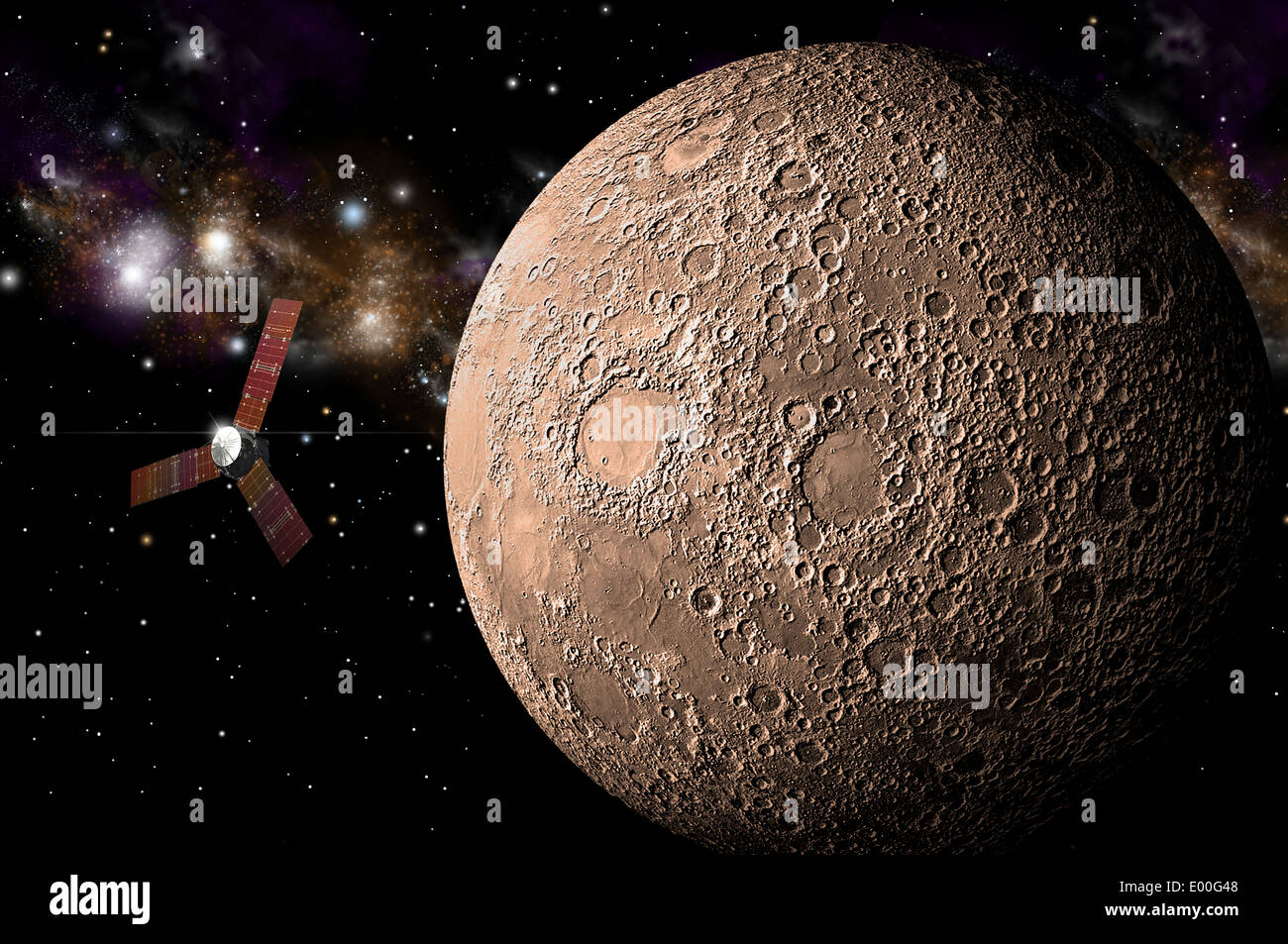 An artist's depiction of a probe investigating a heavily cratered moon in deep space. Stock Photohttps://www.alamy.com/image-license-details/?v=1https://www.alamy.com/an-artists-depiction-of-a-probe-investigating-a-heavily-cratered-moon-image68854136.html
An artist's depiction of a probe investigating a heavily cratered moon in deep space. Stock Photohttps://www.alamy.com/image-license-details/?v=1https://www.alamy.com/an-artists-depiction-of-a-probe-investigating-a-heavily-cratered-moon-image68854136.htmlRFE00G48–An artist's depiction of a probe investigating a heavily cratered moon in deep space.
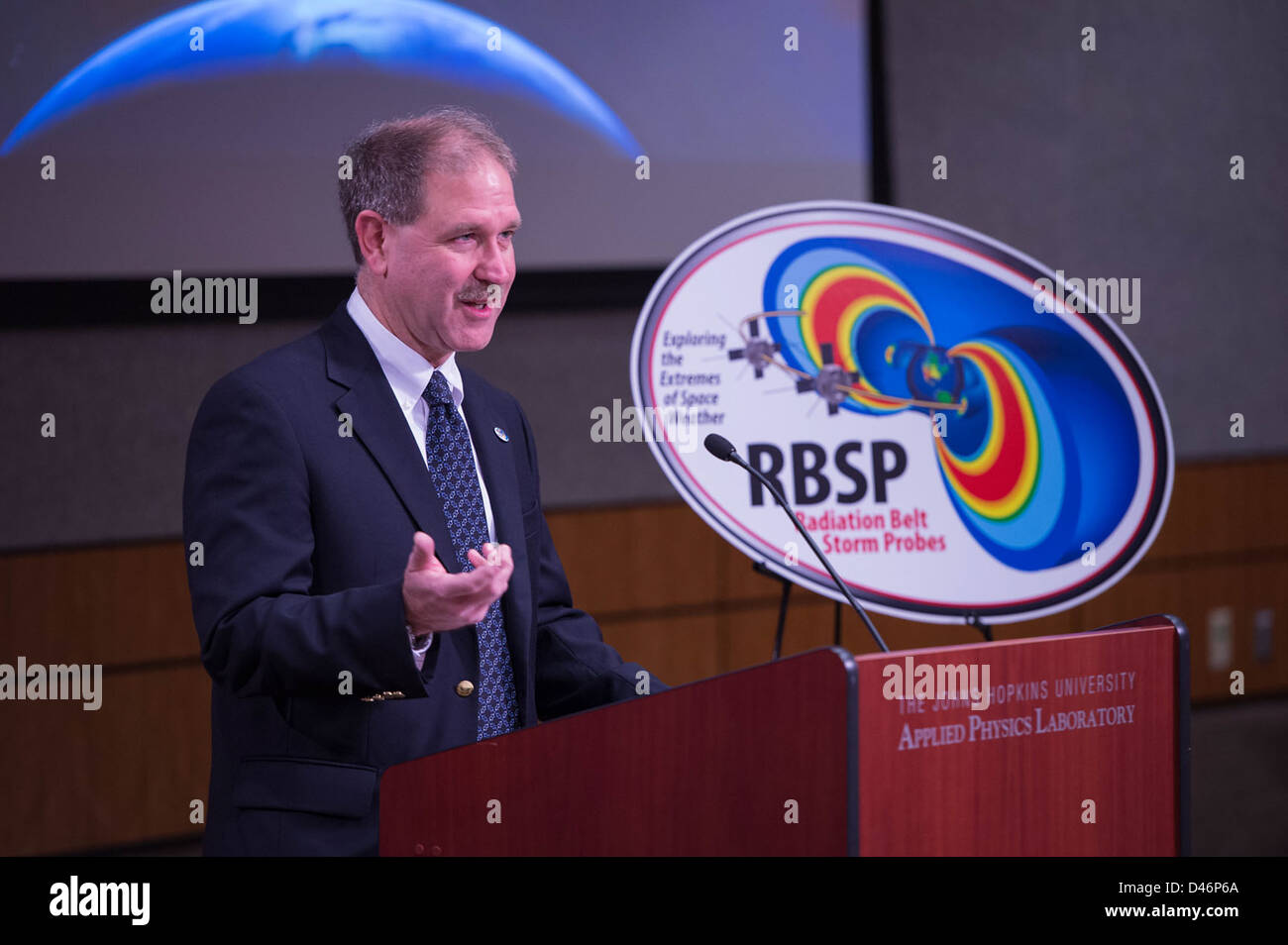 NASA’s Van Allen Probes, launched to study Earth's radiation belts, were named in honor of Dr. James Van Allen, who discovered these belts. The probes aim to explore space weather and its effects on Earth. Stock Photohttps://www.alamy.com/image-license-details/?v=1https://www.alamy.com/stock-photo-nasas-van-allen-probes-launched-to-study-earths-radiation-belts-were-54238866.html
NASA’s Van Allen Probes, launched to study Earth's radiation belts, were named in honor of Dr. James Van Allen, who discovered these belts. The probes aim to explore space weather and its effects on Earth. Stock Photohttps://www.alamy.com/image-license-details/?v=1https://www.alamy.com/stock-photo-nasas-van-allen-probes-launched-to-study-earths-radiation-belts-were-54238866.htmlRMD46P6A–NASA’s Van Allen Probes, launched to study Earth's radiation belts, were named in honor of Dr. James Van Allen, who discovered these belts. The probes aim to explore space weather and its effects on Earth.
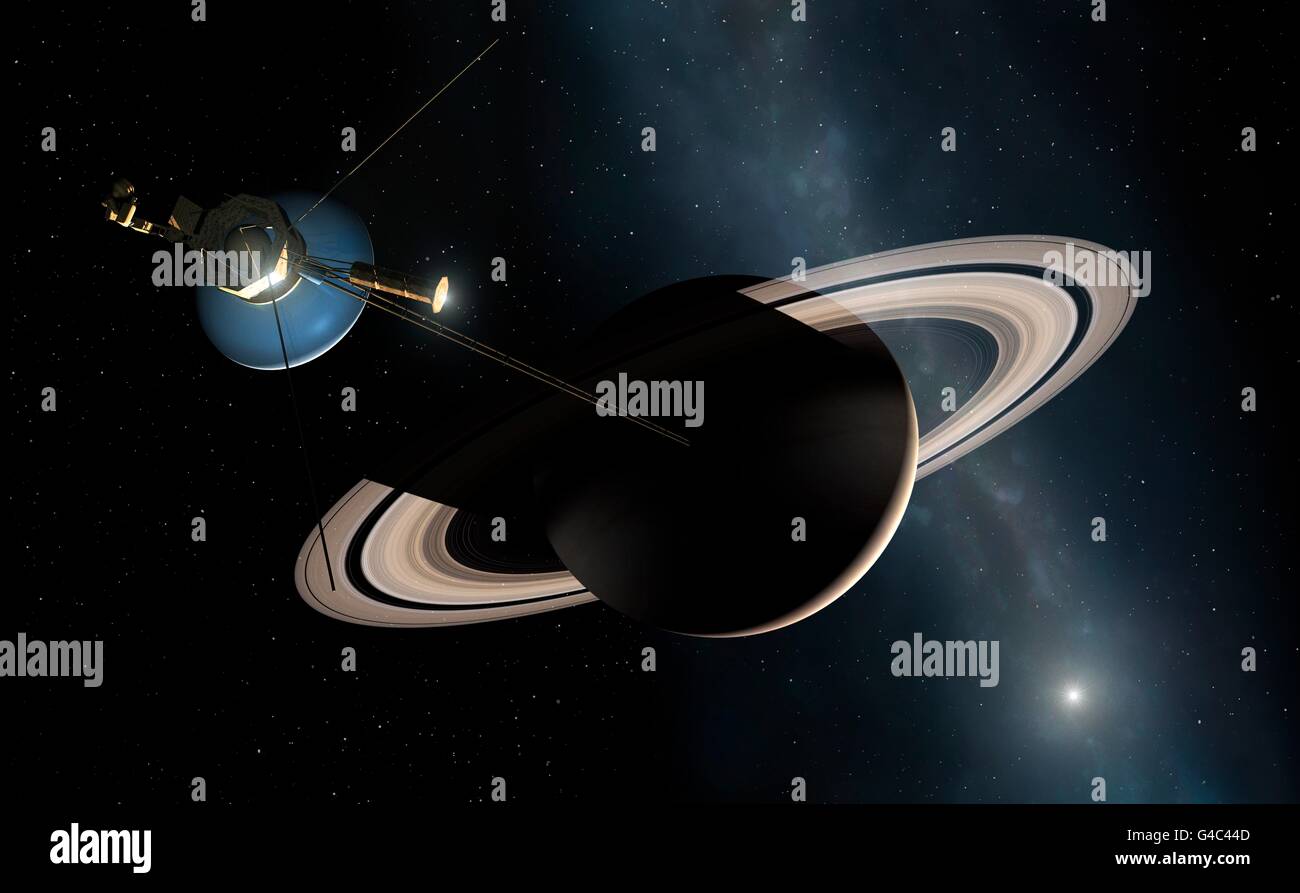 Voyager spacecraft at Saturn, artwork. Two Voyager spacecraft (Voyager 1 and Voyager 2) were launched in 1977. This timing took advantage of a rare alignment of the giant outer planets Jupiter to Neptune, which made it possible for the spacecraft to visit them in a single mission. The probes successfully beamed images and scientific data back to Earth using their dish. Voyager 2 is currently 110 AU from the Earth – one of the most distant man-made objects in space. In this illustration it is seen passing the planet Saturn. Stock Photohttps://www.alamy.com/image-license-details/?v=1https://www.alamy.com/stock-photo-voyager-spacecraft-at-saturn-artwork-two-voyager-spacecraft-voyager-105987517.html
Voyager spacecraft at Saturn, artwork. Two Voyager spacecraft (Voyager 1 and Voyager 2) were launched in 1977. This timing took advantage of a rare alignment of the giant outer planets Jupiter to Neptune, which made it possible for the spacecraft to visit them in a single mission. The probes successfully beamed images and scientific data back to Earth using their dish. Voyager 2 is currently 110 AU from the Earth – one of the most distant man-made objects in space. In this illustration it is seen passing the planet Saturn. Stock Photohttps://www.alamy.com/image-license-details/?v=1https://www.alamy.com/stock-photo-voyager-spacecraft-at-saturn-artwork-two-voyager-spacecraft-voyager-105987517.htmlRFG4C44D–Voyager spacecraft at Saturn, artwork. Two Voyager spacecraft (Voyager 1 and Voyager 2) were launched in 1977. This timing took advantage of a rare alignment of the giant outer planets Jupiter to Neptune, which made it possible for the spacecraft to visit them in a single mission. The probes successfully beamed images and scientific data back to Earth using their dish. Voyager 2 is currently 110 AU from the Earth – one of the most distant man-made objects in space. In this illustration it is seen passing the planet Saturn.
 President Ronald Reagan shaking hands with Andrew J. Stofan. Andrew John Stofan (born January 26, 1935) is an American engineer. He worked for the National Aeronautics and Space Administration (NASA). In the 1960s he played an important role in the development of the Centaur upper stage rocket. In the 1970s he managed the Atlas-Centaur and Titan-Centaur Project Offices, and oversaw the launch of the Pioneer 10 and Pioneer 11 probes to Jupiter and Saturn, the Viking missions to Mars, Helios probes to the Sun, and the Voyager probes to Jupiter and the outer planets. He was director of the Lewis Stock Photohttps://www.alamy.com/image-license-details/?v=1https://www.alamy.com/president-ronald-reagan-shaking-hands-with-andrew-j-stofan-andrew-john-stofan-born-january-26-1935-is-an-american-engineer-he-worked-for-the-national-aeronautics-and-space-administration-nasa-in-the-1960s-he-played-an-important-role-in-the-development-of-the-centaur-upper-stage-rocket-in-the-1970s-he-managed-the-atlas-centaur-and-titan-centaur-project-offices-and-oversaw-the-launch-of-the-pioneer-10-and-pioneer-11-probes-to-jupiter-and-saturn-the-viking-missions-to-mars-helios-probes-to-the-sun-and-the-voyager-probes-to-jupiter-and-the-outer-planets-he-was-director-of-the-lewis-image618358931.html
President Ronald Reagan shaking hands with Andrew J. Stofan. Andrew John Stofan (born January 26, 1935) is an American engineer. He worked for the National Aeronautics and Space Administration (NASA). In the 1960s he played an important role in the development of the Centaur upper stage rocket. In the 1970s he managed the Atlas-Centaur and Titan-Centaur Project Offices, and oversaw the launch of the Pioneer 10 and Pioneer 11 probes to Jupiter and Saturn, the Viking missions to Mars, Helios probes to the Sun, and the Voyager probes to Jupiter and the outer planets. He was director of the Lewis Stock Photohttps://www.alamy.com/image-license-details/?v=1https://www.alamy.com/president-ronald-reagan-shaking-hands-with-andrew-j-stofan-andrew-john-stofan-born-january-26-1935-is-an-american-engineer-he-worked-for-the-national-aeronautics-and-space-administration-nasa-in-the-1960s-he-played-an-important-role-in-the-development-of-the-centaur-upper-stage-rocket-in-the-1970s-he-managed-the-atlas-centaur-and-titan-centaur-project-offices-and-oversaw-the-launch-of-the-pioneer-10-and-pioneer-11-probes-to-jupiter-and-saturn-the-viking-missions-to-mars-helios-probes-to-the-sun-and-the-voyager-probes-to-jupiter-and-the-outer-planets-he-was-director-of-the-lewis-image618358931.htmlRM2XX0K3F–President Ronald Reagan shaking hands with Andrew J. Stofan. Andrew John Stofan (born January 26, 1935) is an American engineer. He worked for the National Aeronautics and Space Administration (NASA). In the 1960s he played an important role in the development of the Centaur upper stage rocket. In the 1970s he managed the Atlas-Centaur and Titan-Centaur Project Offices, and oversaw the launch of the Pioneer 10 and Pioneer 11 probes to Jupiter and Saturn, the Viking missions to Mars, Helios probes to the Sun, and the Voyager probes to Jupiter and the outer planets. He was director of the Lewis
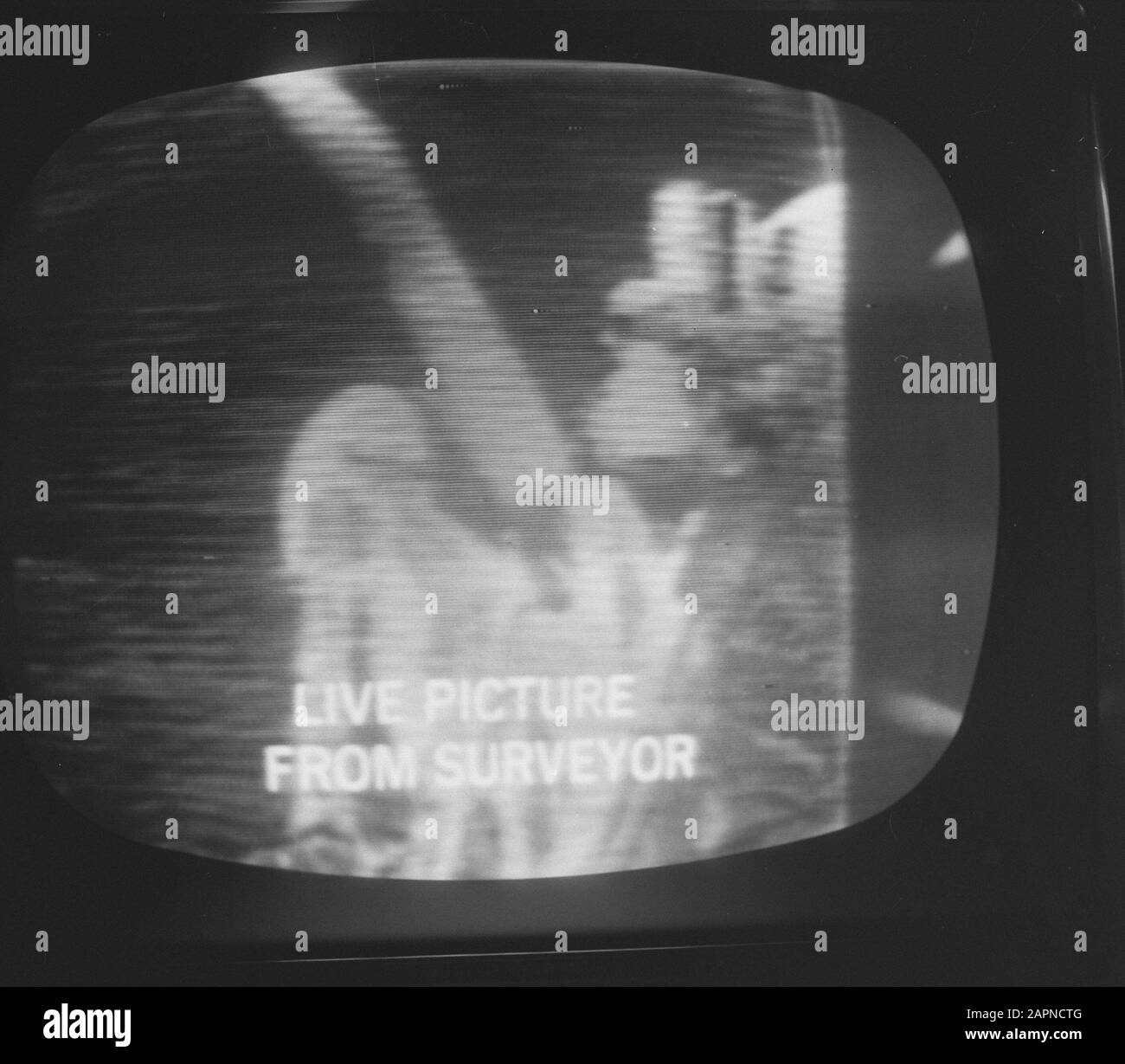 Recording of the Moon by Surveyor from TV Aff Date: June 2, 1966 Keywords: MOON Institution Name: Surveyor Stock Photohttps://www.alamy.com/image-license-details/?v=1https://www.alamy.com/recording-of-the-moon-by-surveyor-from-tv-aff-date-june-2-1966-keywords-moon-institution-name-surveyor-image340990512.html
Recording of the Moon by Surveyor from TV Aff Date: June 2, 1966 Keywords: MOON Institution Name: Surveyor Stock Photohttps://www.alamy.com/image-license-details/?v=1https://www.alamy.com/recording-of-the-moon-by-surveyor-from-tv-aff-date-june-2-1966-keywords-moon-institution-name-surveyor-image340990512.htmlRM2APNCTG–Recording of the Moon by Surveyor from TV Aff Date: June 2, 1966 Keywords: MOON Institution Name: Surveyor